Axell Wireless A215SERIES Dual Band Repeater MBF-D-8-19 User Manual manual
Axell Wireless Dual Band Repeater MBF-D-8-19 manual
manual

MBF, Multi Band Repeater
PRODUCT DESCRIPTION AND USER’S MANUAL
© Axell Wireless Ltd A 200 93 00, rev E 1 (105)
MBF, Multi Band Repeater
Product Description and User’s Manual
This revision of the MBF manual is valid for single, dual and tri band repeaters covering the frequency bands
LTE 700, 850, 900, 1800, 1900, 2200 and AWS
Firmware release version
Common Commands and Attributes v 1.3.2
MBF Commands and Attributes v 1.0.0
Copyright © 2010 Axell Wireless Ltd
All rights reserved.
No part of this document may be copied, distributed, transmitted, transcribed, stored in a retrieval system,
or translated into any human or computer language without the prior written permission of Axell Wireless
Ltd.
The manufacturer has made every effort to ensure that the instructions contained in this document are
adequate and free of errors and omissions. The manufacturer will, if necessary, explain issues which may
not be covered by this document. The manufacturer's liability for any errors in the document is limited to
the correction of errors and the aforementioned advisory services.
This document has been prepared to be used by professional and properly trained personnel, and the
customer assumes full responsibility when using them. The manufacturer welcomes customer comments as
part of the process of continual development and improvement of the documentation in the best way
possible from the user's viewpoint. Please submit your comments to the nearest Axell Wireless sales
representative.

MBF, Multi Band Repeater
PRODUCT DESCRIPTION AND USER'S MANUAL
© Axell Wireless Ltd A 200 93 00, rev E 2 (105)
Table of Contents
Safety Instructions and Warnings ................................................................................................. 4
References .................................................................................................................................... 7
Contact Information ..................................................................................................................... 8
Definitions, Abbreviations and Acronyms ................................................................................... 9
1.1
Basic Repeater Features .................................................................................................... 12
1.2
Repeater Types .................................................................................................................. 12
1.3
Repeater Applications ....................................................................................................... 16
2.1
Repeater Firmware ............................................................................................................ 19
2.2
The RMC, Repeater Maintenance Console ....................................................................... 19
2.3
The AEM, Axell Element Manager ................................................................................... 19
3.1
Overview ........................................................................................................................... 20
3.2
Repeater Models ................................................................................................................ 21
3.3
Characteristics ................................................................................................................... 22
3.4
Casing ................................................................................................................................ 22
3.5
Connections ....................................................................................................................... 24
3.6
Building Blocks ................................................................................................................. 24
3.7
Signal Diagrams ................................................................................................................ 30
3.8
OMU-Repeater System ..................................................................................................... 32
3.9
Access to the System ......................................................................................................... 33
3.10
SW for Configuration and Control .................................................................................... 34
4.1
Software Features - Overview ........................................................................................... 35
4.2
Network Nodes .................................................................................................................. 36
4.3
Fibre Loss Compensation .................................................................................................. 38
4.4
Alarm System .................................................................................................................... 39
4.5
Repeater Heartbeat ............................................................................................................ 52
4.6
RF Parameters ................................................................................................................... 57
4.7
Hardware Identification ..................................................................................................... 59
4.8
Tag and ID ......................................................................................................................... 60
4.9
User Access ....................................................................................................................... 61
4.10
Integration into AEM ........................................................................................................ 62
4.11
Upgrading Firmware ......................................................................................................... 62
5.1
Commissioning Advice ..................................................................................................... 64
5.2
Install the Repeater ............................................................................................................ 69
5.3
Start-up the Repeater ......................................................................................................... 78
5.4
Initiate Local Communication ........................................................................................... 82
5.5
Install the OMU and Set up OMU-Repeater System ......................................................... 84
5.6
Configure the Repeater ...................................................................................................... 84

MBF, Multi Band Repeater
PRODUCT DESCRIPTION AND USER'S MANUAL
© Axell Wireless Ltd A 200 93 00, rev E 3 (105)
5.7
Set Up Remote Communication ........................................................................................ 87
5.8
Integration into the AEM ................................................................................................... 98
6.1
General .............................................................................................................................. 99
6.2
Preventative Maintenance ................................................................................................. 99
6.3
Trouble Shooting ............................................................................................................... 99
6.4
Component Replacement ................................................................................................... 99
6.5
Product Disposal ................................................................................................................ 99
7.1
Single Band Repeater MBF-S-7/8/9/17/18/19/22............................................................ 100
7.2
Dual Band Repeater MBF-D-9-22/8-19/7-17 .................................................................. 102
7.3
Tri Band Repeater MBF-T-9-18-22/8-17-19 ................................................................... 104

MBF, Multi Band Repeater
PRODUCT DESCRIPTION AND USER'S MANUAL
© Axell Wireless Ltd A 200 93 00, rev E 4 (105)
Safety Instructions and Warnings
Guarantees
All antennas must be installed with lightning protection. Damage to power modules, as a result of lightning
are not covered by the warranty.
Switching on AC or DC power prior to the connection of antenna cables is regarded as faulty installation
procedure and therefore not covered by the Axell Wireless warranty.
The repeater box should be closed using the two screws. The screws must be fully tightened. Failure to do so
may affect the IP65 compliancy and therefore any warranty.
Safety to Personnel
Before installing or replacing any of the equipment, the entire manual should be read and understood. The
user needs to supply the appropriate AC or DC power to the repeater. Incorrect power settings can damage
the repeater and may cause injury to the user.
Caution
Please be aware that the equipment may, during certain conditions become very warm
and can cause minor injuries if handled without any protection, such as gloves.
Throughout this manual, there are "Caution" warnings. "Caution" calls attention to a procedure or practice,
which, if ignored, may result in injury or damage to the system, system component or even the user. Do not
perform any procedure preceded by a "Caution" until the described conditions are fully understood and met.
Caution
This notice calls attention to a procedure or practice that, if ignored,
may result in personal injury or in damage to the system or system component.
Do not perform any procedure preceded by a “Caution” until described
conditions are fully understood and met.
Safety to Equipment
When installing, replacing or using this product, observe all safety precautions during handling and operation.
Failure to comply with the following general safety precautions and with specific precautions described
elsewhere in this manual violates the safety standards of the design, manufacture, and intended use of this
product. Axell Wireless assumes no liability for the customer's failure to comply with these precautions. This
entire manual should be read and understood before operating or maintaining the repeater.
Electrostatic Sensitivity
Observe electrostatic precautionary procedures.
Caution
ESD = Electrostatic Discharge Sensitive Device
Semiconductor transmitters and receivers provide highly reliable performance when operated in conformity
with their intended design. However, a semiconductor may be damaged by an electrostatic discharge
inadvertently imposed by careless handling.
Static electricity can be conducted to the semiconductor chip from the centre pin of the RF input connector,
and through the AC connector pins. When unpacking and otherwise handling the repeater, follow ESD
precautionary procedures including use of grounded wrist straps, grounded workbench surfaces, and
grounded floor mats.
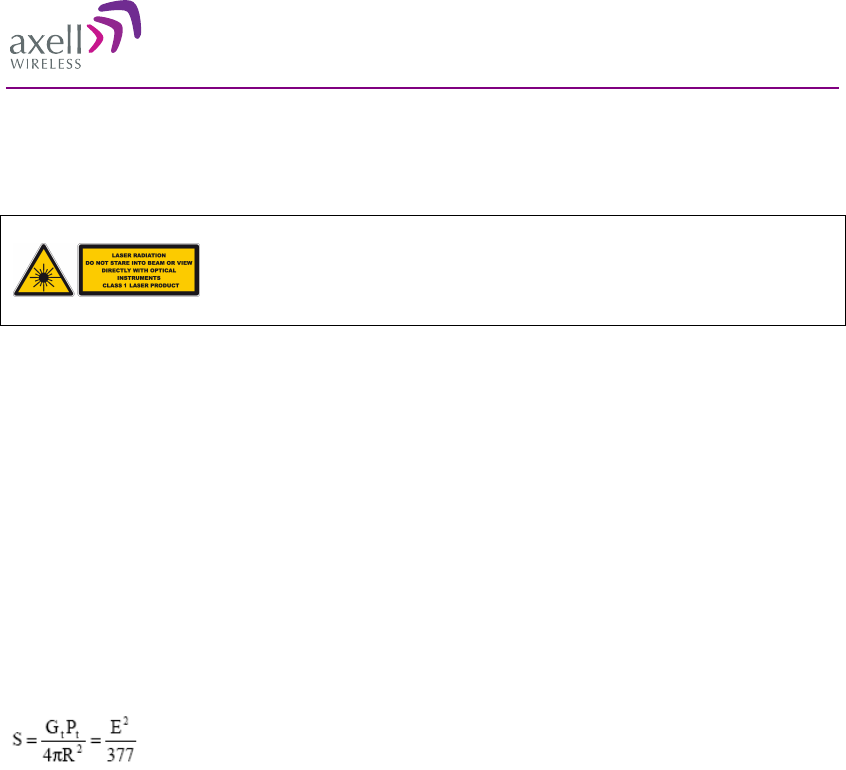
MBF, Multi Band Repeater
PRODUCT DESCRIPTION AND USER'S MANUAL
© Axell Wireless Ltd A 200 93 00, rev E 5 (105)
Class 1 Laser
This product is equipped with class 1 lasers, as per definition in EN 60825-1.
Caution
Un-terminated optical receptacles may
emit laser radiation. Do not stare into beam
or view with optical instruments.
Optical transmitters in the opto module can send out high energy invisible laser radiation. There is a risk for
permanent damage to the eye.
Always use protective cover on all cables and connectors which are not connected. Never look straight into a
fibre cable or a connector. Consider that a fibre can carry transmission in both directions.
During handling of laser cables or connections ensure that the source is switched off. Regard all open
connectors with respect and direct them in a safe direction and never towards a reflecting surface. Reflected
laser radiation should be regarded as equally hazardous as direct radiation.
Radiation Hazard
This equipment emits radio frequency radiation and can, if used the wrong way, be hazardous for personnel.
Here follows an example of the power densities from an intentional radiator.
For radiation from a general antenna, the power density (S) at some distance is according to the well-known
formula:
For the repeaters described in this handbook the maximum output powers are 5 W for 900 / 1800 MHz and
10 W 2100 MHz. The corresponding power densities using a + 10 dBi antenna as an example at 1 m will be 4
W/ m² for the 900/1800 MHz output and 8 W/ m² for 2100 MHZ output.
1 m distance from the antenna at these frequencies is used as a minimum distance for practical exposure of
the public. It is also difficult to have a developed EMF at distances closer than 1 m.
According to R&TTE Health requirements referring to the 1999 Council recommendation, the reference level
for the frequency range of 400 – 2000 MHz is f/ 200 W/ m² ( f in MHz ) and above 2 GHz, 10 W/ m².
For the repeaters in this manual the levels are:
GSM 900 (960 MHz) = 4.8 W/m²
DC 1800 (1880 MHz) = 9.4 W/m²
UMTS 2100 (2170 MHz) = 10 W/m².
This means that an installation with a +10 dBi antenna does not exceed the basic restriction levels according
to the recommendations.
For frequencies between 400 and 2000 MHz the ICNIRP occupational guideline level of exposure is f /40
W/m² (f in MHz), and 50 W/m² for frequencies above 2 GHz.
The ICNIRP levels for the frequency above bands:
GSM 900 (960 MHz) = 24 W/m²
DC 1800 (1880 MHz) = 47 W/m²
UMTS 2100 (2170 MHz) = 50 W/m².
There are no radiation health issues with the above + 10 dBi antenna installations. However, the repeater is
marked with radiation hazard warning.

MBF, Multi Band Repeater
PRODUCT DESCRIPTION AND USER'S MANUAL
© Axell Wireless Ltd A 200 93 00, rev E 6 (105)
References
This document covers both GSM and WDCMA repeaters. These references are valid for respective repeater
type.
ETSI TS 25.106
Universal Mobile Telecommunications System (UMTS); UTRA repeater
radio transmission and reception 3GPP TS 25.106 version 5.8.0 Release 5)
ETSI TS 25.143
Universal Mobile Telecommunications System (UMTS); UTRA repeater
conformance testing (3GPP TS 25.143 version 5.8.0 Release 5)
ETSI EN 301 908-3
Electromagnetic compatibility and Radio spectrum Matters (ERM);
ElectroMagnetic Compatibility (EMC) standard for radio equipment and
services; Part 1: Common technical requirements
ETSI EN 301 489-23
Electromagnetic compatibility and Radio spectrum Matters (ERM);
ElectroMagnetic Compatibility (EMC) standard for radio equipment and
services; Part 23: Specific Conditions for IMT-2000 CDMA Direct Spread
(UTRA) Base Station (BS) radio, repeater and ancillary equipment
EN 60 950 Information technology equipment - Safety - Part 1: General requirements
EN 301 502
Harmonized EN for Global System for Mobile communications (GSM);
Base station and Repeater equipment covering essential requirements
under article 3.2 of the R&TTE directive (GSM 13.21 version 8.1.2.
Release 1999)
ETS 300 342-3
Radio Equipment and Systems (RES); Electro-Magnetic Compatibility
(EMC) for European Digital Cellular Telecommunications systems. Base
Station Radio and ancillary equipment and Repeaters meeting phase 2
GSM requirements.
R & TTE Directive:
ETS EN 301 502
(ETS EN 300 609-
4/GSM 11.26)
Harmonized EN for Global System for Mobile communications (GSM);
Base Station and Repeater equipment covering essential requirements
under article 3.2 of the R&TTE directive
ETS EN 301 489-8
Electromagnetic Compatibility (EMC) Standard For Radio Equipment
And Services; Part 8: Specific Conditions For GSM Base Stations
ETS 300 342-3
Electromagnetic Compatibility (EMC) For European Digital Cellular
Telecommunications System (GSM 900 MHz and DCS 1 800 MHz); Part
3: Base Station Radio and Ancillary Equipment And Repeaters Meeting
Phase 2 GSM Requirements

MBF, Multi Band Repeater
PRODUCT DESCRIPTION AND USER'S MANUAL
© Axell Wireless Ltd A 200 93 00, rev E 7 (105)
Contact Information
Headquarters Axell Wireless
Aerial House
Asheridge Road
Chesham
Buckinghamshire HP5 2QD
United Kingdom
Tel: +44 1494 777000
Fax: +44 1494 777002
Commercial inquiries info@axellwireless.com
Web site www.axellwireless.com
Support issues support@axellwireless.com
Technical Support Line, English speaking +44 1494 777 777
Contact information for Axell Wireless offices in other countries can be found on our web site,
www.axellwireless.com

MBF, Multi Band Repeater
PRODUCT DESCRIPTION AND USER'S MANUAL
© Axell Wireless Ltd A 200 93 00, rev E 8 (105)
Definitions, Abbreviations and Acronyms
AEM Axell Element Manager
A software tool for operation and monitoring a network consisting of Axell Wireless
products.
Previous name of this product was Avitec Element Manager.
ALC Automatic Limit Control
Antenna The part of a radio transmission system designed to radiate or receive
electromagnetic waves
Antenna
beamwidth
More properly referred to as the half-power beamwidth, this is the angle of an
antenna pattern or beam over which the relative power is at or above 50% of the
peak power
Antenna
directivity
This is the relative gain of the main beam of an antenna pattern to a reference
antenna, usually an isotropic or standard dipole
Base station The central radio transmitter/receiver that maintains communications with a mobile
radio equipment within a given range
BCCH Broadcast Control Channel
BTS Base Transceiver Station, one part of a base station.
A base station is composed of two parts, a Base Transceiver Station (BTS) and a
Base Station Control Module (BSC). A base station is often referred to as BTS.
The BTS is also sometimes called an RBS or Remote Base Station.
Carrier-to-
interference ratio,
C/I
The ratio of power in an RF carrier to the interference power in the channel
Carrier-to-noise
ratio, C/N
The ratio of power in an RF carrier to the noise power in the channel
Channel In all Axell Wireless documentation a channel is the same as a carrier.
Coverage area The geographical reach of a mobile communications network or system
Coverage hole An area within the radio coverage footprint of a wireless system in which the RF
signal level is below the design threshold. Coverage holes are usually caused by
physical obstructions such as buildings, foliage, hills, tunnels and indoor parking
garages
dB Decibel, A technique for expressing voltage, power, gain, loss or frequency in
logarithmic form against a reference.
dBi Decibels referenced to an isotropic antenna. A technique for expressing a power gain
measurement in logarithmic form using a theoretical isotropic antenna as a reference
dBm Decibels referenced to 1 mW. A technique for expressing a power measurement in
logarithmic form using 1 mW as a reference.
Dead spot An area within the coverage area of a wireless network in which there is no coverage
or transmission falls off. Dead spots are often caused by electronic interference or
physical barriers such as hills, tunnels and indoor parking garages. See also coverage
area.
Distributed
antenna system
A type of antenna system that is distributed or remotely located away from the
transmitter. Such an antenna or series of antennas can be connected via coaxial

MBF, Multi Band Repeater
PRODUCT DESCRIPTION AND USER'S MANUAL
© Axell Wireless Ltd A 200 93 00, rev E 9 (105)
cable, leaky feeder or optical fibre link.
DL, Downlink The transmission path from the base station down to the mobile station
EAM External Alarm Messaging
EDGE Enhanced Data for Global Evolution. A technology that gives GSM and TDMA
similar capacity to handle services for the third generation of mobile telecom. EDGE
was developed to enable the transmission of large amounts of data at a high speed of
384 kilobit per second, or more.
EMC Electromagnetic Compatibility. The ability of a device or system to function in its
intended electromagnetic environment
ERP Effective Radiated Power
ETSI European Telecommunications Standard Institute. The European standardization
body for telecommunications
GND Ground
Hand-over The passing of a call signal from one base station to the next as the user moves out
of range or the network software re-routes the call
ISI Inter Symbol Interference. An interference effect where energy from prior symbols
in a bit stream is present in later symbols. ISI is normally caused by filtering of the
data streams
LED Light Emitting Diode
Link budget A calculation involving the gain and loss factors associated with the antennas,
transmitters, transmission lines and propagation environment used to determine the
maximum distance at which a transmitter and receiver can successfully operate.
LMT Local Maintenance Terminal
LNA Low Noise Amplifier. A receive preamplifier having very low internal noise
characteristics.
Logical channel A communications channel derived from a physical channel. A physical channel, i.e.
RF channel, typically carries a data stream that contains several logical channels.
These usually include multiple control and traffic channels.
LOS Line of Sight. A description of an unobstructed radio path or link between the
transmitting and receiving antennas of a communications system
MCPA Multi Carrier Power Amplifier
MS Mobile Station (e.g. mobile phone)
MTBF Meantime Between Failures
NA Not Applicable
NC Not Connected
NF Noise Figure
Noise figure A figure of merit for receivers and preamplifiers representing the amount of excess
noise added to the signal by the amplifier or receiving system itself. The lower the
noise figure, the less excess noise is added to the signal
ODF Optical Distribution Frame, used for connection and patching of optical cables
OMC Operations and Maintenance Centre. A location used to operate and maintain a
wireless network
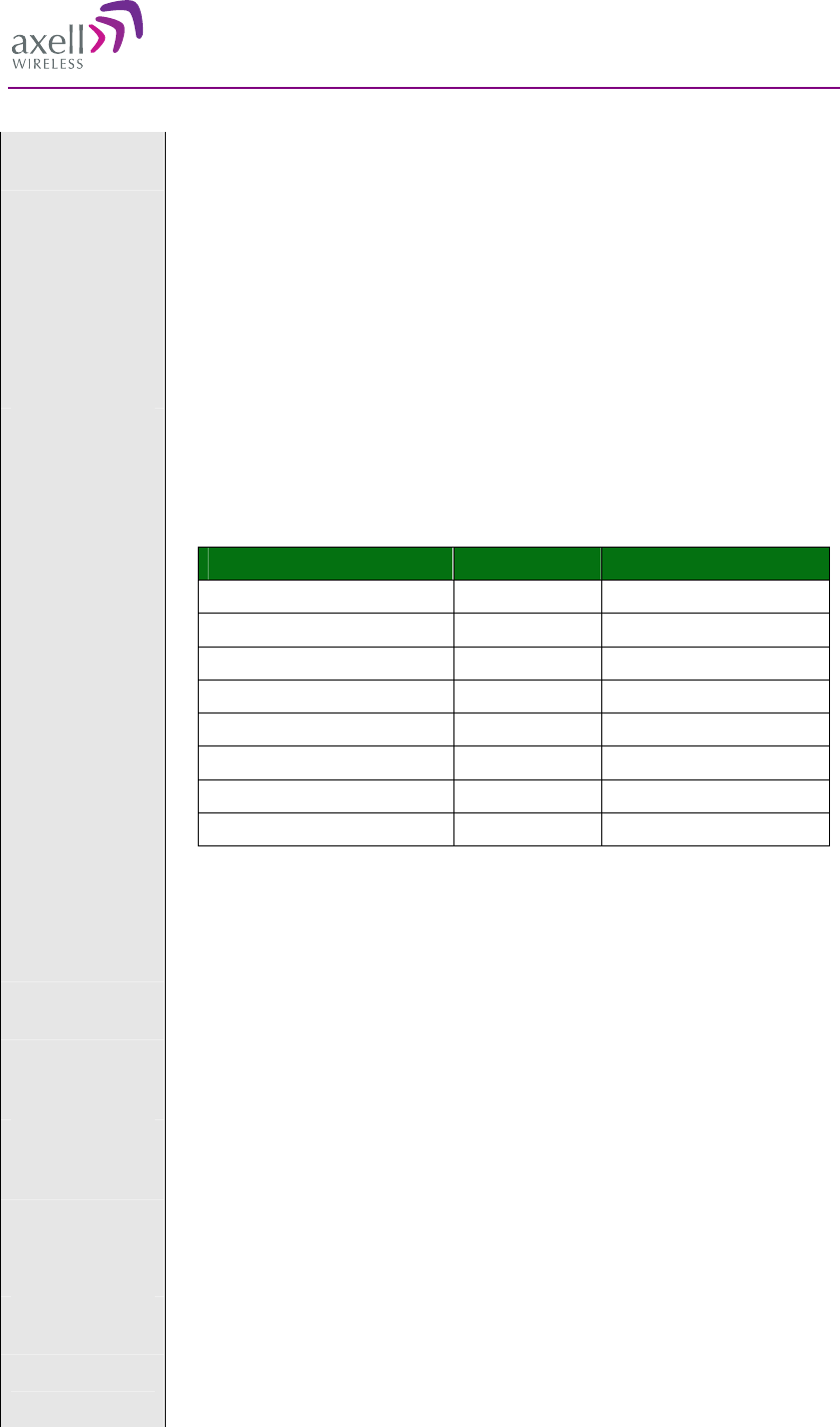
MBF, Multi Band Repeater
PRODUCT DESCRIPTION AND USER'S MANUAL
© Axell Wireless Ltd A 200 93 00, rev E 10 (105)
OMU Optical Master Unit, translates between RF signals and optical signals so that fibre
fed repeaters can be used.
PA Power Amplifier. A device for taking a low or intermediate-level signal and
significantly boosting its power level. A power amplifier is usually the final stage of
amplification in a transmitter.
PSTN Public Switched Telephone Network, standard domestic and commercial phone
service
Radio link The equipment and transmission path (propagation channel) used to carry on
communications. It includes the transmitting system, the propagation channel and
receiving system
Repeater A bi-directional Radio Frequency (RF) amplifier that can amplify and transmit a
received Mobile Station (MS) signal in the
MS
transmit band. Simultaneously it
amplifies and transmits a received Base Transceiver Station (BTS) RF signal in the
BTS transmit band.
RF Radio Frequency, 9 kHz – 300 GHz
Designation Abbreviation Frequencies
Very Low Frequency VLF 9 kHz - 30 kHz
Low Frequency LF 30 kHz - 300 kHz
Medium Frequency MF 300 kHz - 3 MHz
High Frequency HF 3 MHz - 30 MHz
Very High Frequency VHF 30 MHz - 300 MHz
Ultra High Frequency UHF 300 MHz - 3 GHz
Super High Frequency SHF 3 GHz - 30 GHz
Extremely High Frequency EHF 30 GHz - 300 GHz
RMC Repeater Maintenance Console. Software tool to monitor and control Axell Wireless
repeaters via local or remote access
RS232 Serial interface standard
RS485 Serial Interface standard
Service area The specified area over which the operator of a wireless communications network or
system provides services
Signal-to-
interference ratio,
S/I
The ratio of power in a signal to the interference power in the channel. The term is
usually applied to lower frequency signals, such as voice waveforms, but can also be
used to describe the carrier wave. See also carrier-to-interference ratio.
Signal-to-noise
ratio, S/N, SNR
The ratio of power in a signal to the noise power in the channel. This term is usually
applied to lower frequency signals, such as voice waveforms. See also carrier-to-
noise ratio
SMSC Short Messaging Service Centre
TCH Traffic Channel. A logical channel that allows the transmission of speech or data. In
most second generation systems, the traffic channel can be either full or half-rate
Transceiver A transmitter and receiver contained in one package. A 2-way radio or cell phone is
an example of a transceiver
Transmitter Equipment which feeds the radio signal to an antenna, for transmission. It consists of
active components such as the mixer, driver and PA and passive components such as
the TX filter. Taken together, these components impress a signal onto an RF carrier

MBF, Multi Band Repeater
PRODUCT DESCRIPTION AND USER'S MANUAL
© Axell Wireless Ltd A 200 93 00, rev E 11 (105)
of the correct frequency by instantaneously adjusting its phase, frequency, or
amplitude and provide enough gain to the signal to project it through the ether to its
intended target
UL, Uplink The transmission path from the mobile station up to the base station
WDM Wavelength Division Multiplexing. A technology that uses optical signals on
different wavelengths to increase the capacity of fibre optic networks in order to
handle a number of services simultaneously
VSWR Voltage Standing Wave Ratio
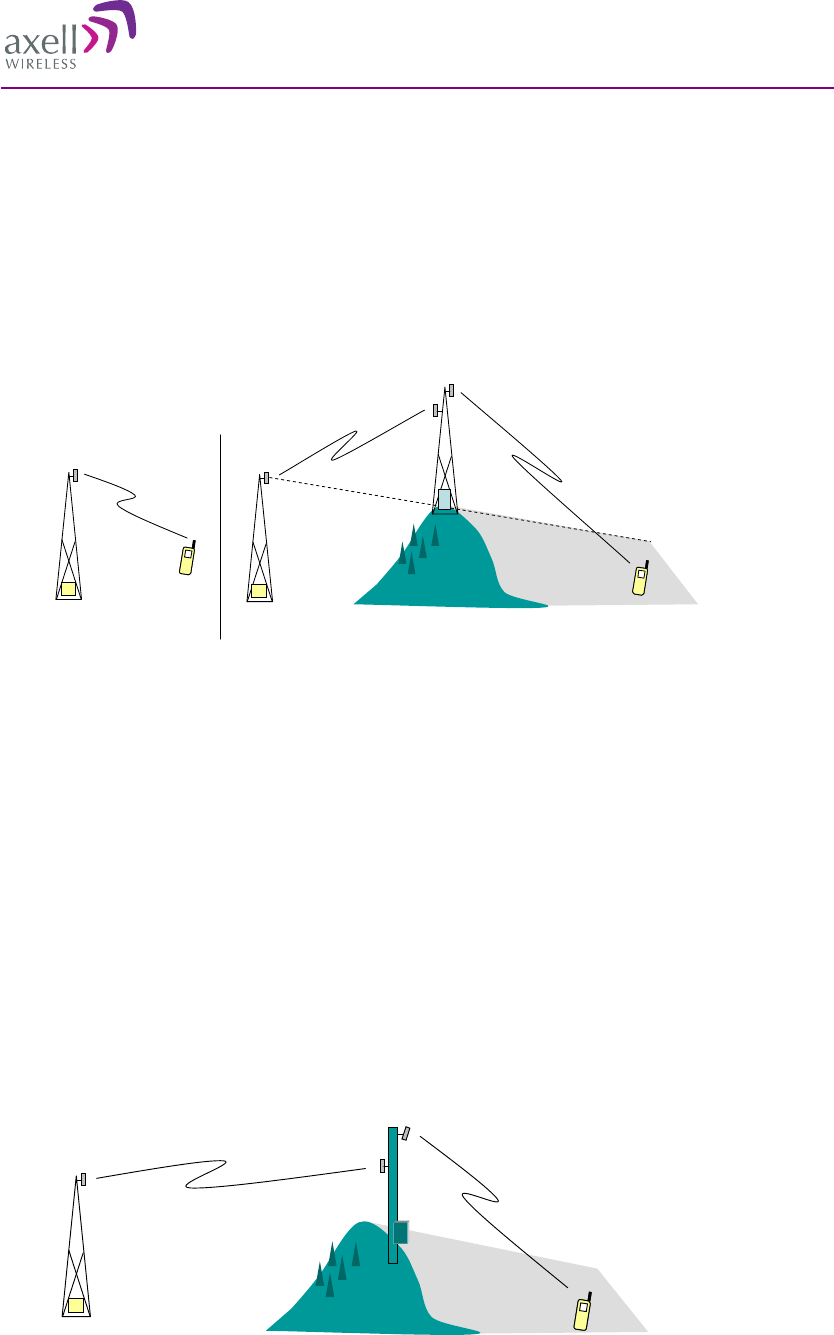
MBF, Multi Band Repeater
PRODUCT DESCRIPTION AND USER'S MANUAL
© Axell Wireless Ltd A 200 93 00, rev E 12 (105)
1 Repeater Technology
1.1 Basic Repeater Features
A basic feature of a mobile communication system is to transmit RF signals between base stations and mobile
radio equipment.
When there is a blocking object, such as a mountain or a building, preventing the base station signal to reach
the mobile equipment, a repeater can be used to extend the base station’s coverage area.
Repeater
BTS BTS
Donor antenna
Server antenna
Undisturbed transmission Obstacle creating a coverage hole
MS MS
In the downlink path (from the base station to the mobile phone) the repeater picks up the signal in the air via
a donor antenna, amplifies it and re-transmits it into the desired coverage area via a server antenna. In the
uplink path (from the mobile phone to the base station) the repeater receives the signals from mobile
transmitters in the covered area and re-transmits them back to the base station.
A repeater can work off-air, as the repeater in the example above, or be fed over fibre from an optical master
unit, OMU. The OMU taps the signal directly off a base station via a coupler, converts it to light and
transmits it to a number of repeaters via fibre.
1.2 Repeater Types
1.2.1 Channel Selective Repeaters
Channel selective repeaters are mainly used for coverage of dead zones, shadows, in-building coverage or
other areas with inadequate signal strength. The output power of a channel selective repeater is sufficient to
cover an area shadowed by a building or other obstacle.
In a channel selective repeater each carrier is separately filtered, amplified and retransmitted.
BTS
Donor antenna
Server antenna
F1 F1 F1
Repeater
MS
A channel selective repeater system consists of one repeater unit complemented with one antenna facing the
donor BTS and another antenna directed towards the coverage area. The repeater site needs to be located
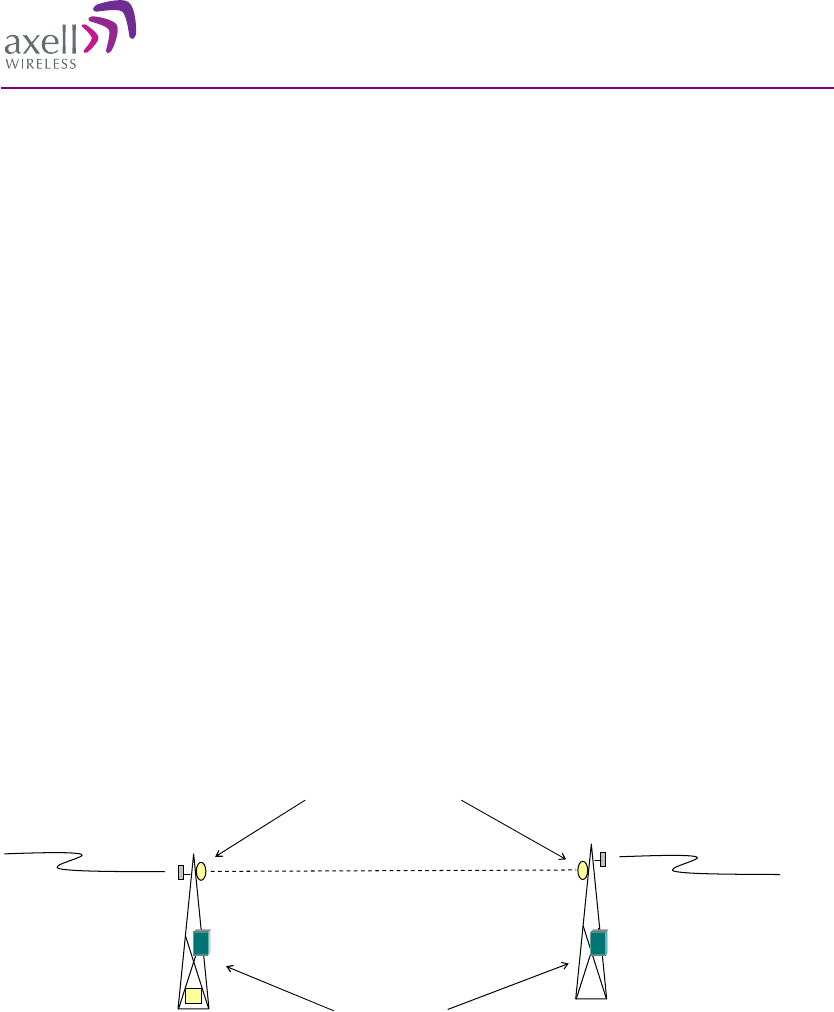
MBF, Multi Band Repeater
PRODUCT DESCRIPTION AND USER'S MANUAL
© Axell Wireless Ltd A 200 93 00, rev E 13 (105)
where the BTS signal strength is large enough to be usable by the system. Ideally the repeater’s donor
antenna should have line of sight (LOS) contact with the BTS antenna. If the signal strength is high enough,
LOS may in some cases not be necessary.
The signal generated by the BTS is picked up at the repeater site via the donor antenna. The repeater filters
and amplifies the signal before retransmitting it at the same frequency over the server antenna.
The isolation between the antennas at the repeater site has to be high in order to prevent degradation of signal
quality and risk of oscillation. Ways to achieve this can be large physical separation between the antennas,
usage of highly directional antennas with good front-to-interference ratio or external shielding between the
antennas. Another option is to use a Frequency Translating repeater (see description below).
Channel selective repeaters may have higher output power per carrier and typically have better spurious
rejection than band selective repeaters. The maximum output power per carrier can be several watts.
1.2.2 Band Selective Repeaters
Band selective repeaters have the same functionality as channel selective repeaters. The difference is that
band selective repeaters do not separate out specific carriers but amplify and retransmit all signals within a
defined frequency band.
The risk for intermodulation distortion leads in most cases to a lower output power per carrier in a band
selective repeater than in a channel selective repeater.
1.2.3 Frequency Translating Repeaters
A frequency translating repeater provides output power levels comparable to a base station. The concept
allows for high gain without the high antenna isolation required for channel selective repeaters.
The frequency translating repeater consists of two units; one donor unit and one remote unit.
Donor Cell
Base Station
Remote unit
Server antenna
F4 F4 F1
Donor unit
RF Link Path
F1
Link antennas
Repeater units
The donor unit is mounted at the base station site where the signal enters the repeater via a directional
coupler. In the donor unit, the signal is translated into another frequency, the link frequency, amplified and
transmitted via a link antenna. At the remote site, a link antenna picks up the signal and feeds it to the remote
unit. The signal is translated back into the original frequency and retransmitted over the server antenna.
Only 2 guard channels are needed between the radio frequency and the link frequency.
The isolation between antennas at the remote site seldom needs to be more than 75dB. This value that can be
achieved with a limited antenna displacement, often as low as 3 meters. The relatively modest isolation
requirement allows the use of omni-directional antennas for the service area.
Important applications for frequency translating repeaters are road coverage, rural coverage or for
transferring capacity from a base station to another area.
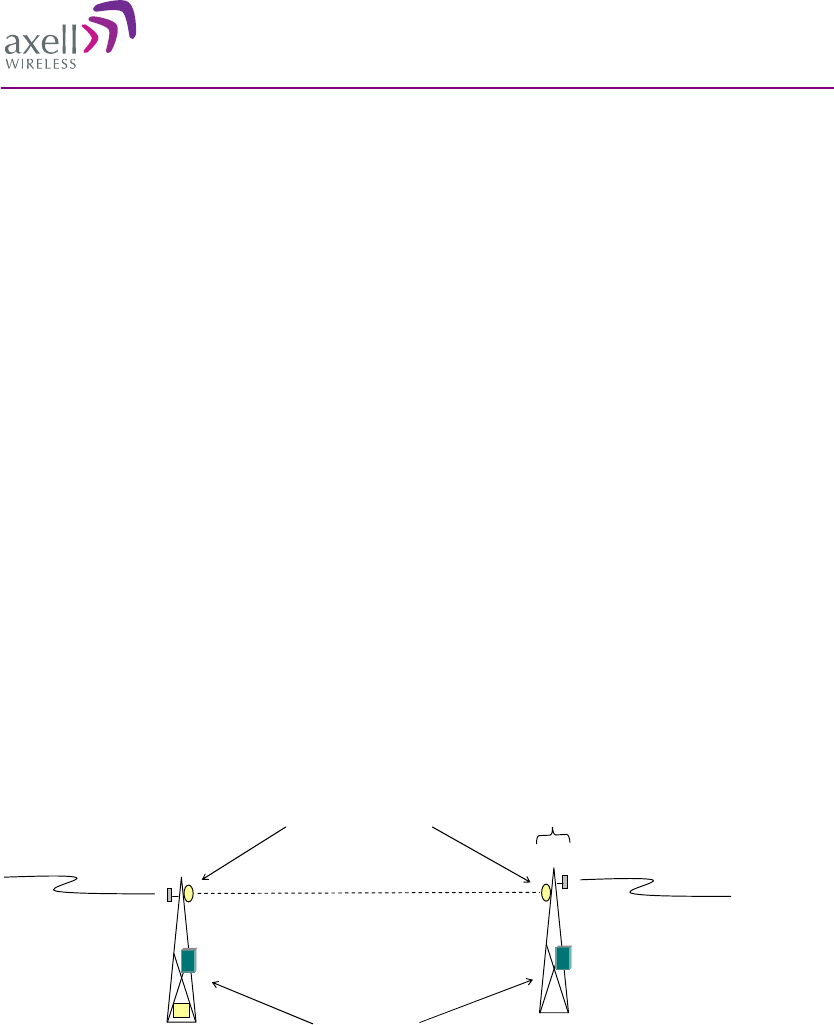
MBF, Multi Band Repeater
PRODUCT DESCRIPTION AND USER'S MANUAL
© Axell Wireless Ltd A 200 93 00, rev E 14 (105)
1.2.3.1 Donor Unit
There are two types of donor units – single donor (SD) and double donor (DD).
A single donor (SD) unit has one input connector. The input signal from the BTS is split in two within the
repeater unit. In the opposite direction – in the uplink – the signals are combined within the repeater before
being sent to the BTS.
A double donor (DD) unit has dual inputs. This can be used in combination with a BTS that uses air
combining, and hence has a separate antenna for each TRU. A double donor unit can alternatively handle two
signals from two separate BTS.
1.2.3.2 Remote Unit
There are two types of remote units – internal combining (IR) and external combining (ER).
In an internal combining (IR) remote unit output from the power amplifiers in the downlink is combined and
filtered before being passed on to the server antenna. In the uplink the signal is separated within the remote
unit.
An external combining remote (ER) unit has two server antenna ports and the signal is combined in the air.
Since the ER model needs no combiner the output signal and gain is 3dB higher than in the IR model.
1.2.4 Band Shifting Repeaters
Band shifting repeaters are based on the same concept as frequency translating repeaters described above.
In contrast to a frequency translating repeater, which uses another frequency within the same band for the
link, a band shifting repeater uses another band. For instance can a repeater operating on the 900MHz band
use the 1800MHz band for the link and vice versa. Other combinations are also possible.
Donor Cell
Base Station
Remote unit
Server antenna
Band 2 Band 2 Band 1
Donor unit
RF Link Path
Band 1
Link antennas
Repeater units
Link and server antenna on the
remote site can often be combined
By using another band for the link the isolation between antennas at the remote site becomes very low. It
might in some applications even be possible to use the same antenna for both the link and the service area.
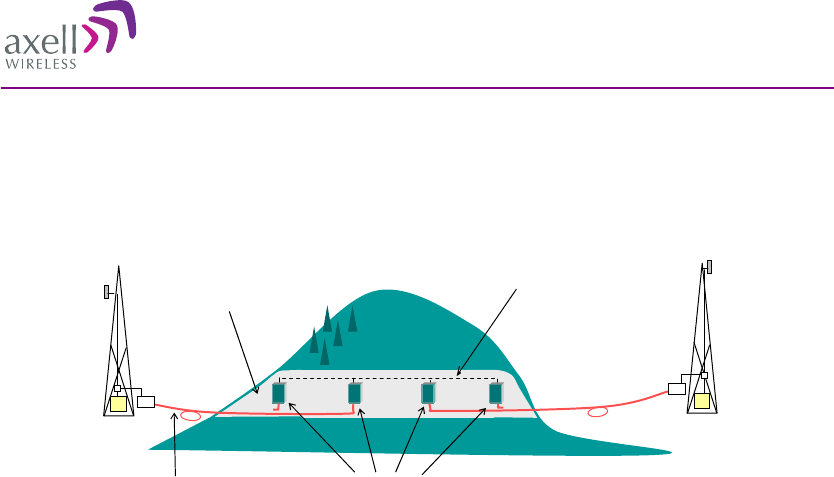
MBF, Multi Band Repeater
PRODUCT DESCRIPTION AND USER'S MANUAL
© Axell Wireless Ltd A 200 93 00, rev E 15 (105)
1.2.5 Fiber Fed Repeaters
The fiber fed repeater is primarily designed for coverage of tunnels and large buildings.
BTS BTS
Leaky feeder
Fiber fed repeaters
Tunnel
HUB/
OptoBox
Directional
coupler
Optic fiber
A fiber fed repeater can be either channel selective or band selective. It receives the RF signals from the base
station via a HUB or an OptoBox which translates the RF signal to an optical signal and sends it to the
repeater via a fiber optic cable. The repeater unit can be installed up to 20 km away from the base station.
Inside the tunnel leaky feeders or antennas can be used for transmission to the mobile units.
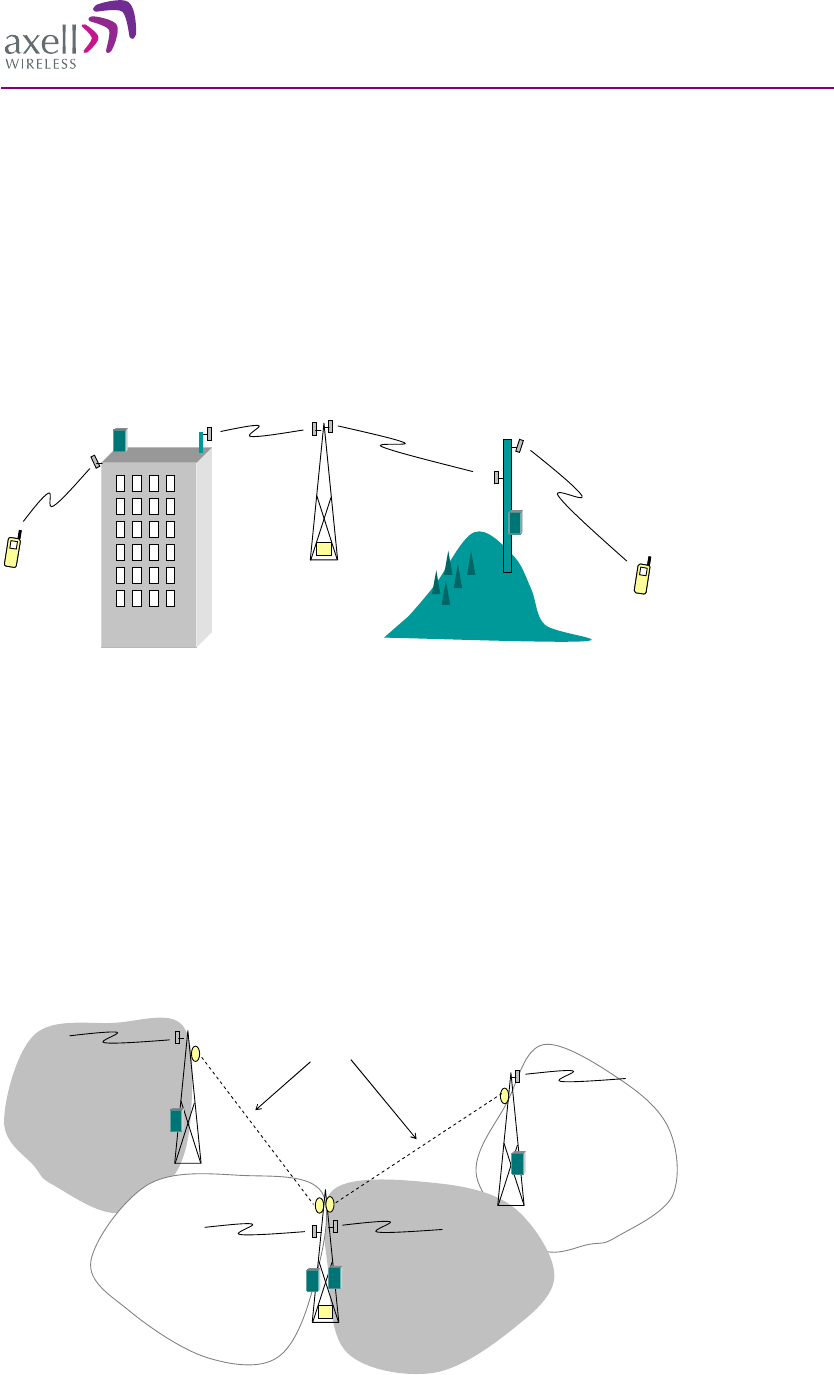
MBF, Multi Band Repeater
PRODUCT DESCRIPTION AND USER'S MANUAL
© Axell Wireless Ltd A 200 93 00, rev E 16 (105)
1.3 Repeater Applications
1.3.1 Channel Selective Repeaters
1.3.1.1 Shadow Coverage and Gap Filling
When there are coverage holes caused by buildings or mountains, a channel selective repeater can be used to
extend coverage into the “dead zone”. The building can sometimes be used as physical shield to create the
necessary antenna isolation.
BTS
Repeater
Repeater
MS
MS
The terrain is often seen as a limiting factor when striving for flawless radio coverage. The gap-filler
repeaters can be used as a complement to the network of base stations.
1.3.2 Frequency Translating Repeaters
1.3.2.1 Low Traffic Coverage
The example shows coverage extension in an area with low traffic by using frequency translating repeaters.
A two sector BTS is extended with two frequency translating repeaters. Both donor units are mounted at the
base station site and connected to the base station via directional couplers.
Each repeater has a different link frequency and transmits the frequency of the opposite base station sector,
thus minimizing interference or multi-path propagation problems. A normal handover is performed between
the repeater coverage area and the neighboring base station coverage area.
BTS
Donor unit
Donor unit
Remote unit
Remote unit
RF Link Paths
F1
F1
F2
F8
F2
F4
F4
F8
Since the installation of frequency translating repeaters requires moderate antenna isolation, remote site
requirements are very moderate.
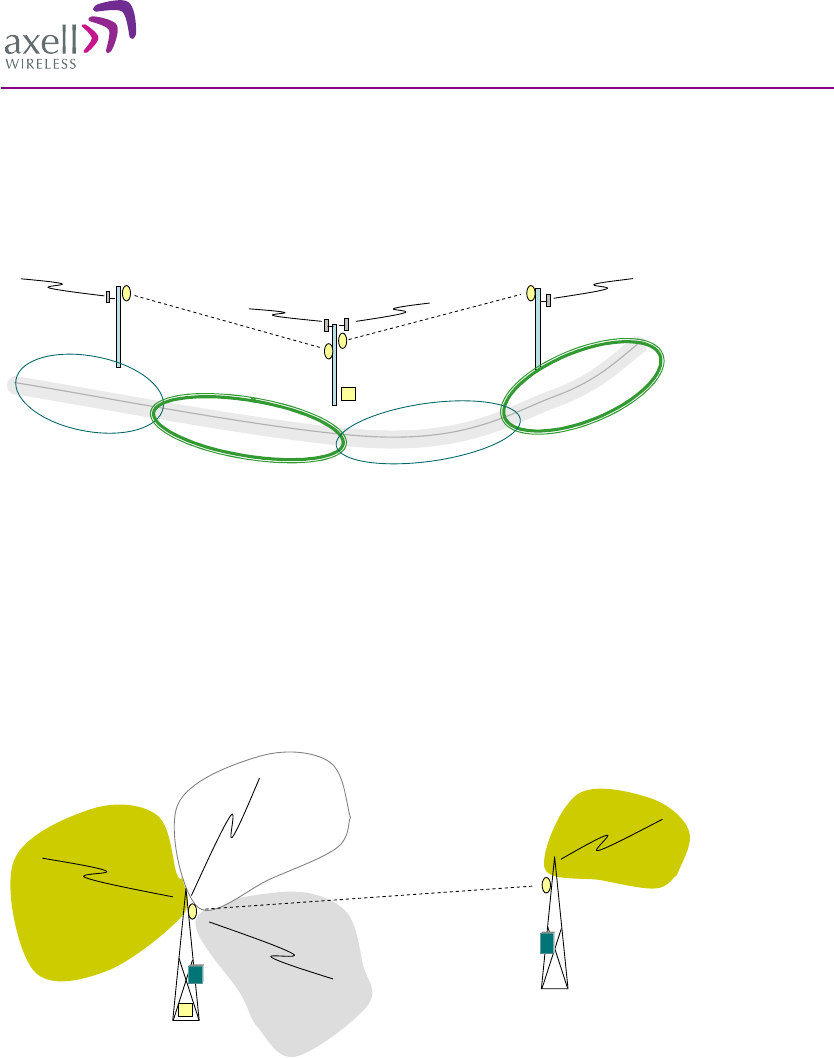
MBF, Multi Band Repeater
PRODUCT DESCRIPTION AND USER'S MANUAL
© Axell Wireless Ltd A 200 93 00, rev E 17 (105)
1.3.2.2 Highway Coverage
One two-sector BTS feeds two frequency translating repeaters, each covering an area comparable to the base
station. This is a way to get maximum coverage out of the one BTS, with one connection point for
transmission.
BTS
Since antenna isolation requirements are low for frequency translating repeaters, omni-directional antennas
can be used at the remote sites to achieve good coverage.
1.3.2.3 “Fake site” – Moving Capacity
In this application the BTS is upgraded with an additional “sector” used for feeding a frequency translating
repeater to cover an area up to 20km away from the BTS. This is an effective alternative when no
transmission point is available in the area to be covered. The frequency translating repeater “moves” capacity
from the base station site to the new location.
BTS
Remote
unit
Donor
unit
Fake Site
This type of installation takes full advantage of the high output power and high sensitivity of the frequency
translating repeater.
1.3.3 Band Shifting Repeaters
A band shifting repeater can be used in the same way as a frequency translating repeater if the user has access
to frequencies on two different bands.
1.3.4 Fiber Fed Repeaters
1.3.4.1 Tunnel Coverage
Fiber optic fed repeaters makes it possible to cover long tunnels from one or two BTS sites nearby. The hub
unit at the BTS site can feed up to 24 repeaters. The repeaters distribute the signal in the tunnel with antennas
or radiating cables (leaky feeders).
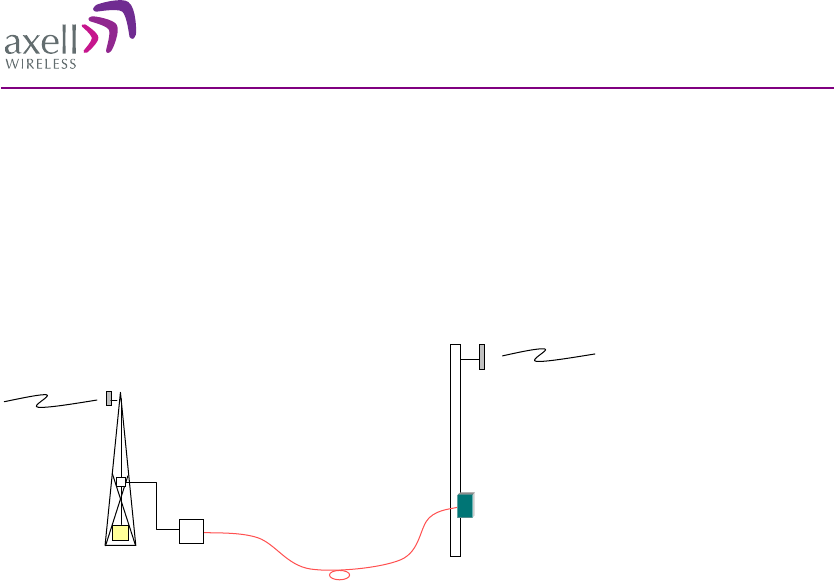
MBF, Multi Band Repeater
PRODUCT DESCRIPTION AND USER'S MANUAL
© Axell Wireless Ltd A 200 93 00, rev E 18 (105)
Using leaky feeders is normally the most effective way to cover a tunnel, since the signal is evenly distributed
along the tunnel. Achieving good coverage in a train tunnel, for instance, using antennas can be difficult as
the trains tend to block signal propagation.
1.3.4.2 Open Area Coverage
A fiber optic fed repeater can be used in combination with a HUB or an OptoBox to move the repeater away
from the base station. This can in some cases be used to avoid antenna isolation problems.
BTS
HUB/OptoBox
Fiber Fed
Repeater
Optical Fiber
Omnidirectional
Antenna
Directional Coupler
In this example a HUB/OptoBox is placed at the BTS site. The RF signal is tapped from the antenna by a
directional coupler, translated into an optical signal and sent to the repeater over a fiber optic link. At the
repeater site a fiber fed repeater receives the signal, translates it back to RF and sends it to the antenna. This
antenna can be for instance omni-directional because the distance to the BTS is no longer a problem.

MBF, Multi Band Repeater
PRODUCT DESCRIPTION AND USER'S MANUAL
© Axell Wireless Ltd A 200 93 00, rev E 19 (105)
2 Software Overview
Axell Wireless mainly supplies three different types of software; Repeater firmware, Repeater Maintenance
Console and Axell Element Manager.
2.1 Repeater Firmware
The repeater firmware is the software inside the Control Module of the repeater. It is command line based,
with simple SET and GET commands. A rich variety of commands are available to control and monitor all
subsystems of the repeater from a normal VT100 terminal emulation program, such as MiniCom
(Linux/Unix) or HyperTerminal (Windows). This also means that any standard laptop is able to control a
repeater without additional software installed.
The repeater firmware has three main tasks:
Set and configure parameters in the repeater, such as channel numbers, gain, power levels, and different
report configurations
Monitor and measure alarm sources, alarm parameters and repeater utilization
Send reports and alarms to the repeater OMC
Communication with the repeater can be performed either locally on site or remotely via a built in modem.
For local communication a terminal with RS232 interface is needed. For remote communication a computer
with a modem is needed as well as a serial communications program such as HyperTerminal™.
2.2 The RMC, Repeater Maintenance Console
RMC is an online software program with an intuitive graphical interface that simplifies control and
installation of the repeater or OMU. The RMC is a graphical shell for the repeater’s Control Module. It reads
commands and attributes from the Control Module and displays them in an intuitive layout. This eliminates
the need to learn commands and attributes for controlling the repeater or OMU.
Login can be made locally via the LMT port or remotely via a modem or via Ethernet. As soon as the RMC is
connected it constantly polls the repeater or OMU for parameters such as power supply levels, in and out
levels, temperature, traffic, etc. If the repeater is a slave type repeater, the OMU manages the data collection
from the repeater.
The RMC program can be installed from a CD. It is a Windows based application that runs on Windows 2000
and Windows XP.
2.3 The AEM, Axell Element Manager
AEM is a complete operations and maintenance centre for Axell Wireless repeater networks.
The AEM takes control of the repeater – or the OMU-Repeater system - once the installation at site is
completed. The repeater gets integrated into the network and will be controlled by the Element Manager.
During integration all repeater parameters and statuses are downloaded into a database. The database is
regularly updated with all incoming alarms and reports, and will hence contain a copy of the repeater
configuration so that current repeater information will be accessible without setting up communication with
the repeaters.
Communication between the AEM and the repeaters are message based. This means that the operator does
not have to await message delivery, but will be informed when the message is delivered to the repeater
The Axell Element Manager is a Windows™ based application that runs on Windows 2000, Windows 2003
Server and Windows XP.
For more information please refer to the separate AEM User’s Manual.
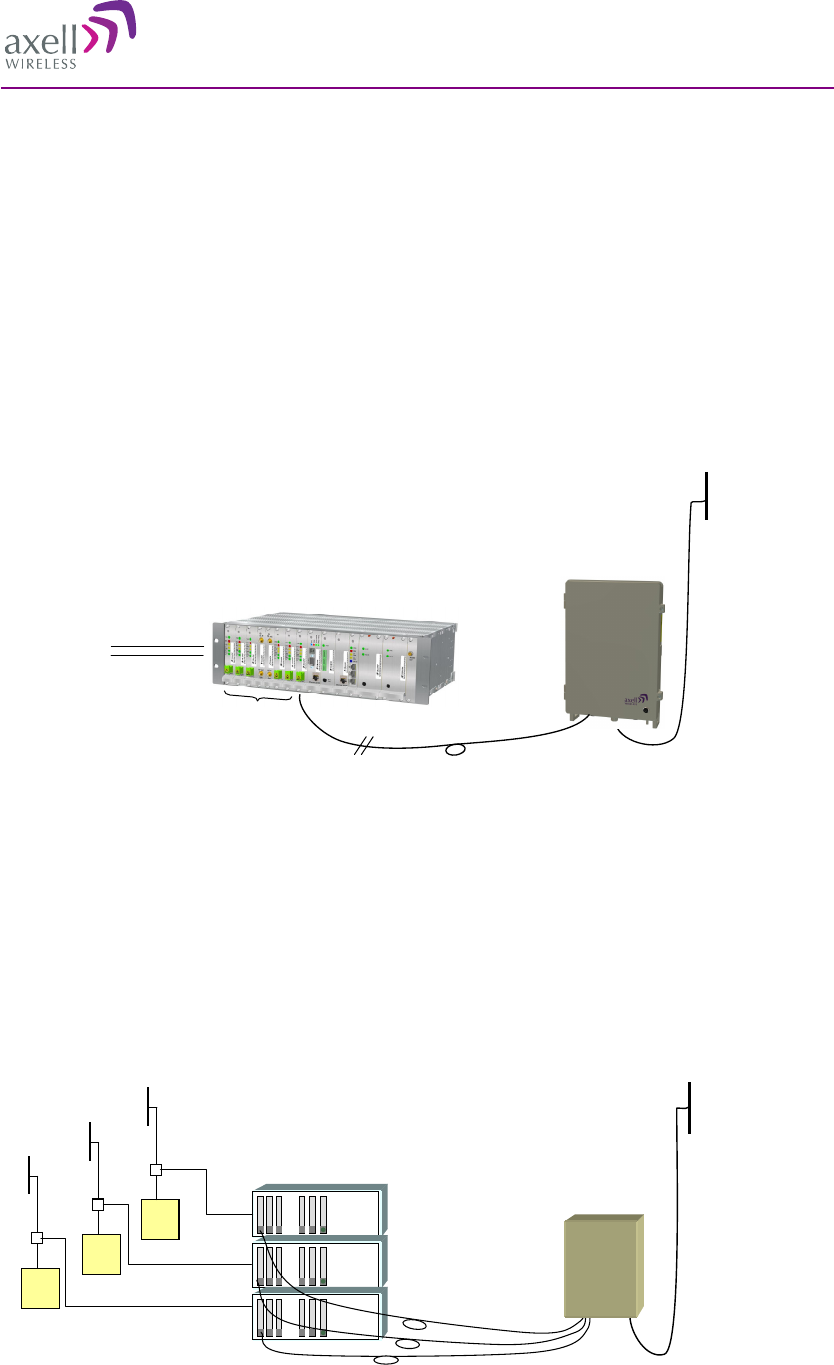
MBF, Multi Band Repeater
PRODUCT DESCRIPTION AND USER'S MANUAL
© Axell Wireless Ltd A 200 93 00, rev E 20 (105)
3 Product and System Description
3.1 Overview
The MBF family of repeaters include band selective, fibre fed repeaters with one, two or three bands
integrated into one repeater box. The repeaters are named MBF (Multi Band Fibre) with an extension that
defines the number of bands and the type of band. The number of bands is indicated by a letter where “S”
stands for single band, “D” for dual band and “T” for tri band. The frequencies covered are indicated by
numbers where “7” stands for 700MHz, “8” stands for 850MHz, “9” for 900 MHz, “18” for 1800MHz, “19”
for 1900 MHz, “22” for 2100MHz and “17” for the AWS band.
The MBF repeater is a systems component and needs to be fed from an Optical Master Unit, OMU. Each
OMU can be equipped with up to 6 fibre optic converters. Several OMUs can also be cascaded to form more
extensive repeater systems.
RF
MBF
Repeater
Opto Fiber
RF
FiberOptic
Converters
Server
Antenna
From BTS
via coupler
OMU
Standard OMU-Repeater application where one OMU is used
In a standard OMU-Repeater application as illustrated above, the input signal to the system is tapped off a
base station via a directional coupler. In the OMU the RF signal is converted into an analogue optical signal
and transported via optic fibre to the fibre fed repeater MBF. The repeater converts the optical signal back
into an RF signal which is then amplified and transmitted via a server antenna. In the uplink direction the
OMU receives the signal from the repeater via the fibre optical cable, converts it to an RF signal and sends it
back to the base station via the coupler. The OMU-Repeater system can also be fed from one a repeater. In
this case the signal is tapped from the repeater’s server antenna port. The repeater in its turn can be linked to
an antenna that picks up the signal off air.
An MBF repeater with more that one band can be equipped with one fibre optic converter which is shared
between the bands or have one converter for each band. Below are the two options exemplified.
BTS 1
BTS 2
BTS 3
Tri band repeater with three
fibre optic converters
Server
Antenna
A tri
band repeater with three fibre optic converters fed by three OMUs
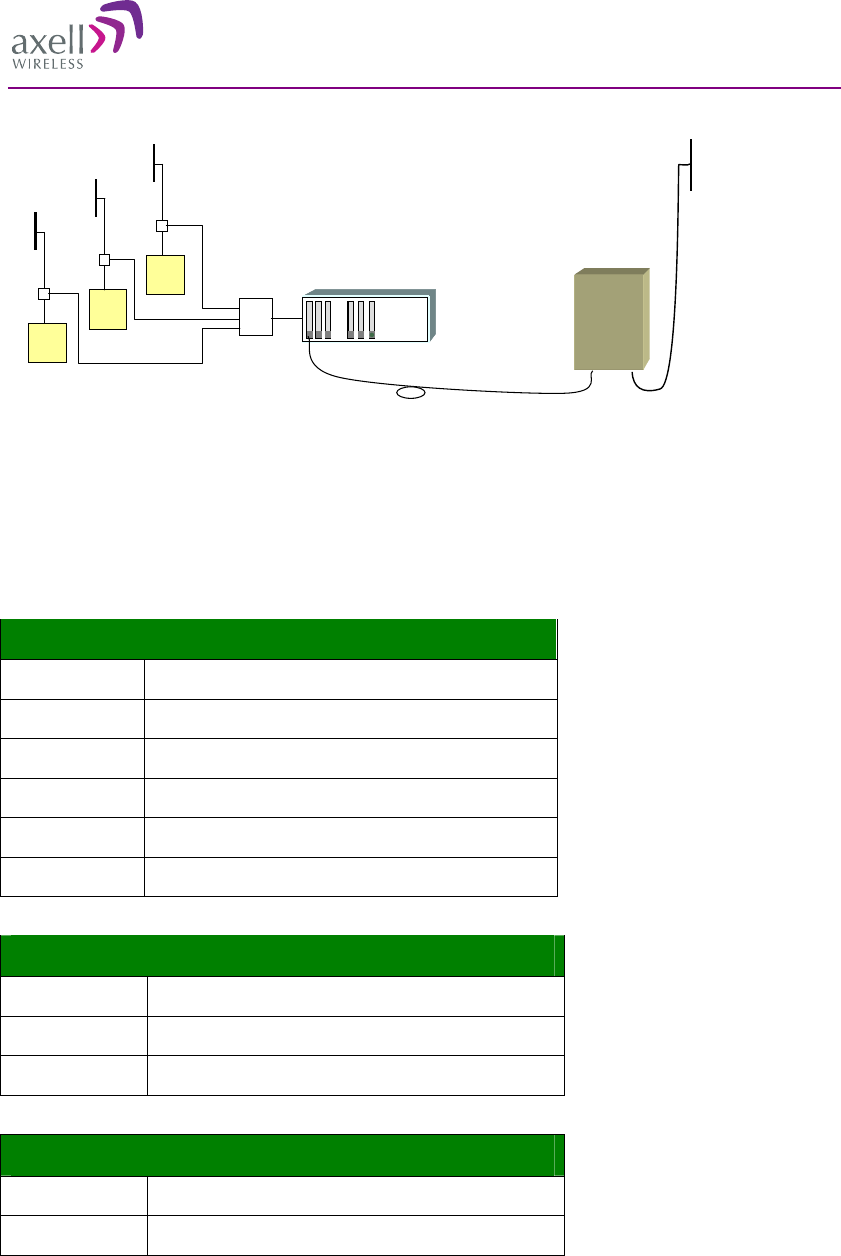
MBF, Multi Band Repeater
PRODUCT DESCRIPTION AND USER'S MANUAL
© Axell Wireless Ltd A 200 93 00, rev E 21 (105)
BTS 1
BTS 2
BTS 3
Tri band repeater with one
fibre optic converter
Server
Antenna
Combiner
system
A tri
band repeater with one fibre optic converter fed by one OMU
An OMU-Repeater system can be expanded to handle up to 24 repeaters and cover a distance of to up to 20
km of fibre between the OMU and the most distant repeater.
3.2 Repeater Models
The MBF repeater can be configured in many combinations. These are the most common ones.
Single Band
MBF-S-7 LTE-700
MBF-S-8 GSM/WCDMA850
MBF-S-9 E-GSM
MBF-S-18 GSM1800
MBF-S-19 GSM/WCDMA1900
MBF-S-22 WCDMA2100
Dual Band
MBF-D-9-22 E-GSM and WCDMA2100
MBF-D-8-19 GSM/WCDMA850 and GSM/WCDMA1900
MBF-D-7-17 LTE700 and AWS
Tri Band
MBF-T-9-18-22 E-GSM, GSM1800 and WCDMA2100
MBF-T-8-17-19 GSM/WCDMA850, AWS and GSM/WCDMA1900

MBF, Multi Band Repeater
PRODUCT DESCRIPTION AND USER'S MANUAL
© Axell Wireless Ltd A 200 93 00, rev E 22 (105)
3.3 Characteristics
These are some of the most important characteristics of the MBF family of repeaters.
For more detailed information please refer to section 7 Specifications.
MBF
System GSM/WCDMA850, E-GSM, GSM1800,
GSM/WCDMA1900, AWS, LTE and WCDMA2100
Composite Output Power DL 850MHz +37 dBm
Composite Output Power DL E-GSM +37 dBm*
Composite Output Power DL 700MHz +37dBm
Composite Output Power DL 1800MHz +37 dBm*
Composite Output Power DL 1900MHz +37 dBm
Composite Output Power DL 2100MHz +39 dBm
Gain is defined by the whole link including the OMU Adjustable in 1dB steps
* Note! In repeaters that share a common downlink fibre for 900MHZ and 1800MHz a minimum of 4
carriers in each band is required for the full composite output power to be attainable maintaining full ETSI
compliance.
3.4 Casing
Axell Wireless repeaters are relatively small and have low power consumption. They are housed in a die cast
aluminum box which makes them light and offers good heat conduction and waterproofing. Cooling is
accomplished by convection.
Note! The MBF repeaters are designed primarily for multi carrier purposes. If the repeaters are run at full
output power over a longer period the convection cooling might not be enough. The repeaters have a power
management function implemented that will step down the power and if needed fully shut down the amplifier
chains until temperature has reached normal values. In situations where a repeater will be run in such a
manner extra cooling can be provided for instance by putting the repeater in a temperature controlled
environment or via external fans.
The housing conforms to IP65 and NEMA 4 standards.
Dimensions, Weight and Power Consumption
Dimensions Single and dual band versions: 540 x 350 x 150 mm
Tri band version:540 x 350 x 220 mm
Weight Single band version: 21 kg, Dual band version: 25 kg, Tri band version: 33kg
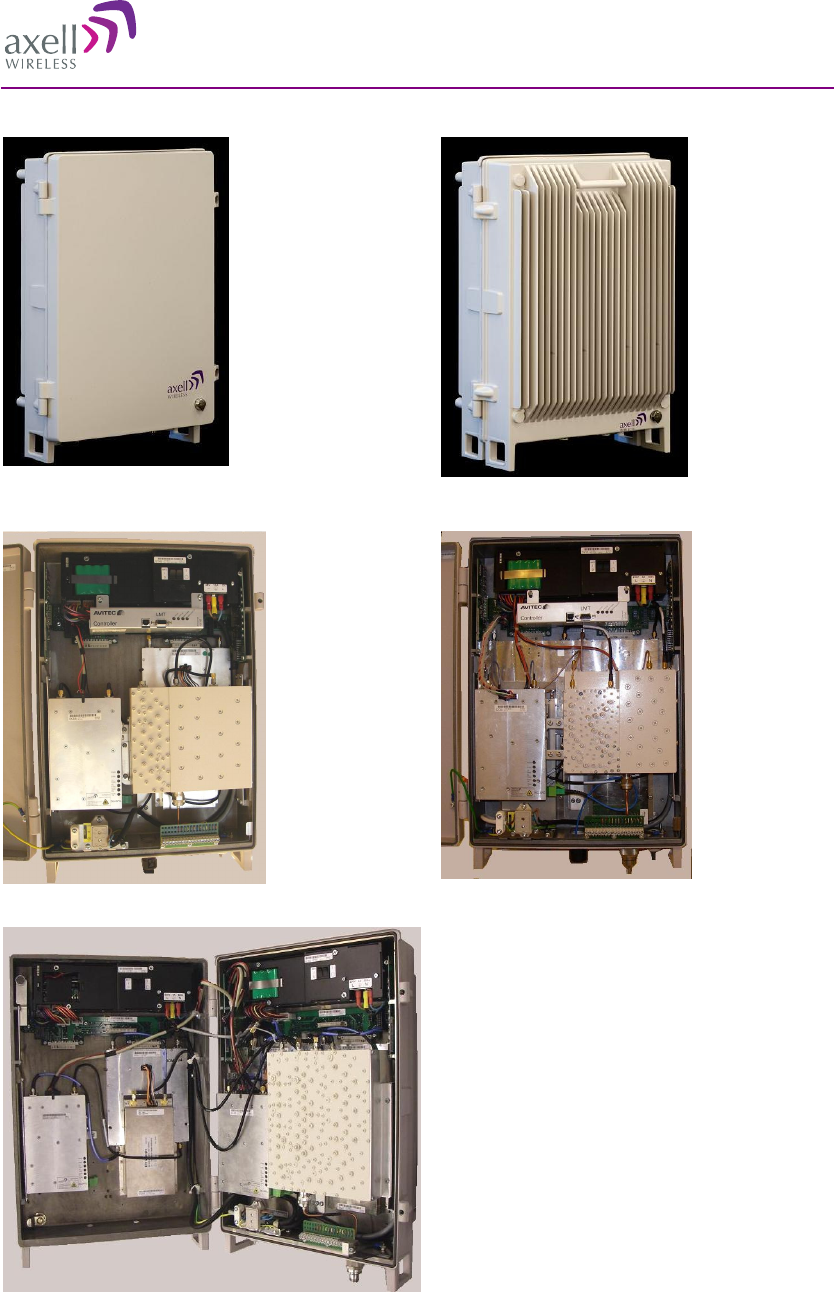
MBF, Multi Band Repeater
PRODUCT DESCRIPTION AND USER'S MANUAL
© Axell Wireless Ltd A 200 93 00, rev E 23 (105)
Single or dual band repeater Tri band repeater
Single band repeater with door open Dual band repeater with door open
Tri band repeater with door open
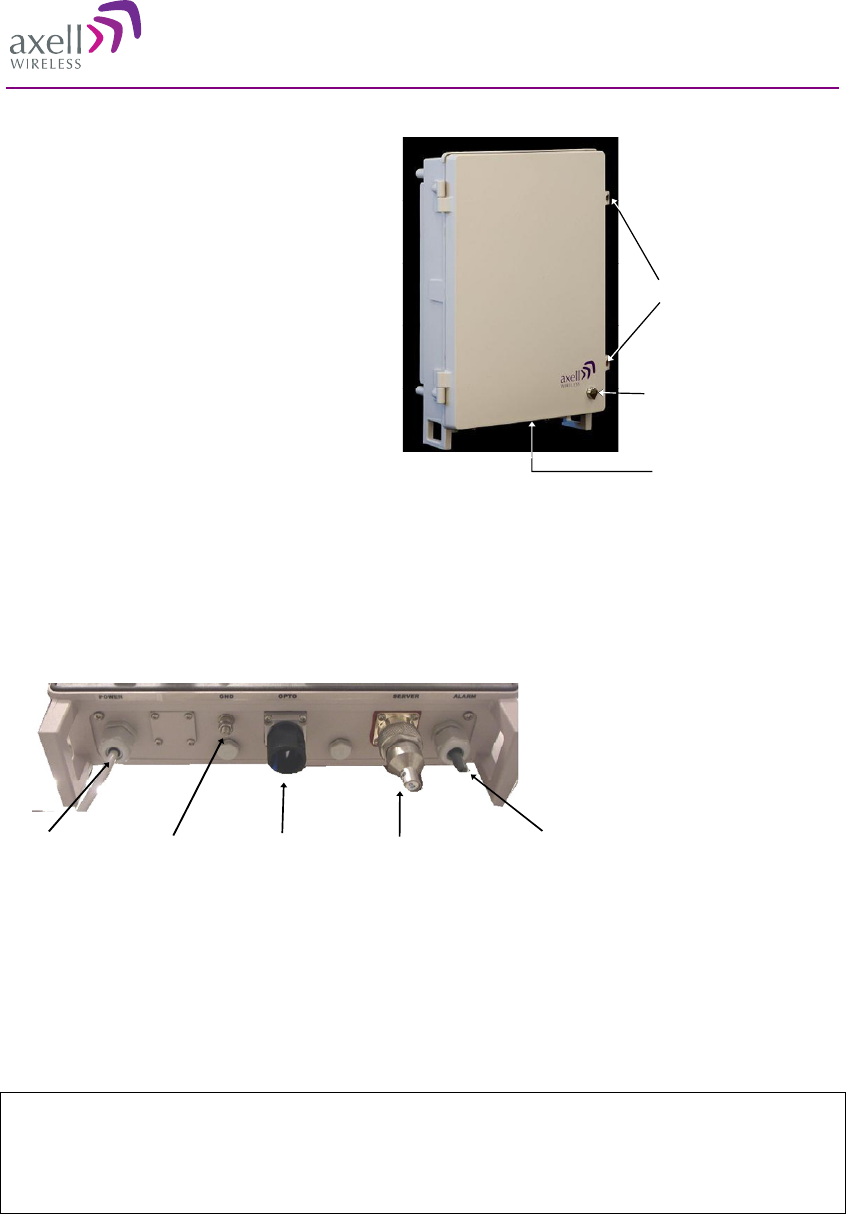
MBF, Multi Band Repeater
PRODUCT DESCRIPTION AND USER'S MANUAL
© Axell Wireless Ltd A 200 93 00, rev E 24 (105)
The repeaters are closed with two hex screws,
M8.
As a complement the repeaters can be locked
with a key.
Note! The two screws must be fully tightened.
Failure to do so may affect the IP65 compliancy
and therefore any warranty.
The external connections at the bottom of the
repeater can be protected with a cover which is
screwed in place.
Screws
Connectors
Lock
The repeaters are designed to be mounted on a wall or in a 19” rack. They should always be mounted in a
vertical position with the connectors facing downwards.
3.5 Connections
All connections are placed at the bottom panel of the repeater.
Power Fiber inputGround Server
antenna
External
alarms
Antenna connection is DIN 7/16” connector, female
Fibre connector is SC/APC. It is placed on the fibre optic converter(s) inside the repeater
Plinth connection for power input is described in section 5 Installation
Plinth connector for external alarms is described in section 5 Installation
Note!
APC connectors need to be used
throughout the whole link between the OMU and the repeater.
Also all ODF connections need to be of the same type.
3.6 Building Blocks
The repeaters consist of the following main building blocks.
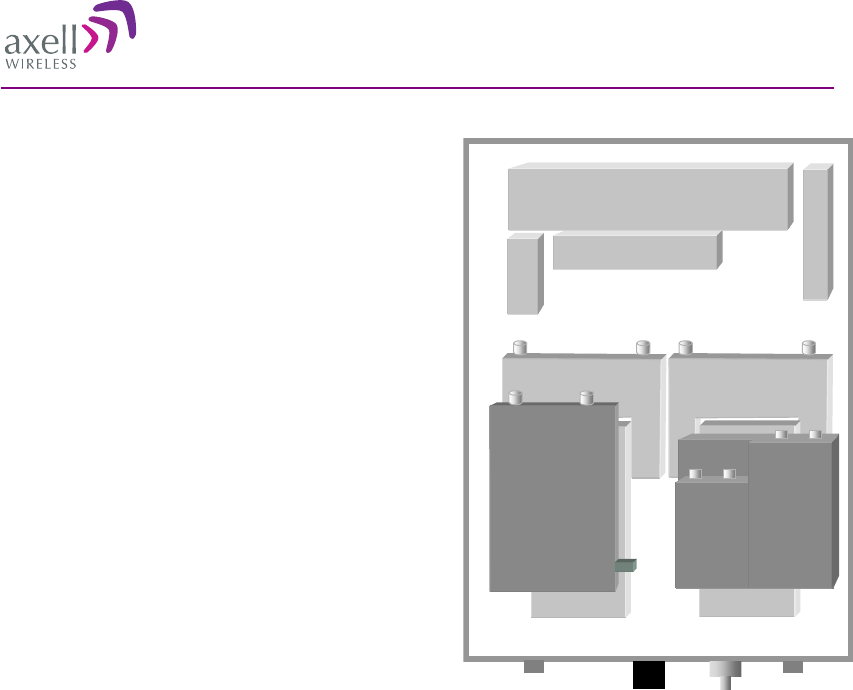
MBF, Multi Band Repeater
PRODUCT DESCRIPTION AND USER'S MANUAL
© Axell Wireless Ltd A 200 93 00, rev E 25 (105)
Control Module – all MBF repeaters have one
Control Module
MCPA, Multi Carrier Power Amplifier – an MBF
repeater has one MCPA for each band
Radio Module – an MBF repeater has one Radio
Module for each band
Fibre Optic Converter – an MBF repeater can have
one, two or three Fibre Optic Converters
Filter – all MBF repeaters have one filter for one,
two or thee bands
RefGen, Reference Generator - all MBF repeaters
have one RefGen
EAIM, External Alarm Interface Module - all MBF
repeaters have one EAIM
PSUP, Power Supply Module - single and dual
band repeaters have one PSUP, and tri band
repeaters have two
The illustration to the right shows a dual band repeater
with one fibre optic converter.
Radio Module
External
Alarms
Power Server
Antenna
Port
PSUPPSUP
Control Module
Ref Gen
EAIM
Fiber
Input
Fibre Optic
Converter
MCPA MCPA
Filter
Radio Module
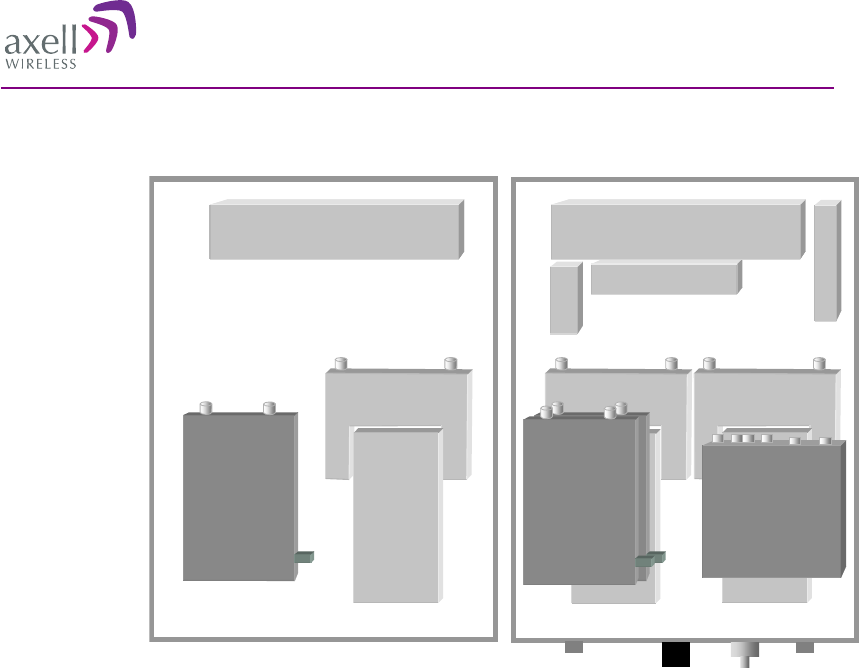
MBF, Multi Band Repeater
PRODUCT DESCRIPTION AND USER'S MANUAL
© Axell Wireless Ltd A 200 93 00, rev E 26 (105)
The illustration
to the left shows
a tri band
repeater with
three fibre optic
converters
Radio Module
External
Alarms
Power Server
Antenna
Port
PSUPPSUP
Control Module
Ref Gen
EAIM
Fiber
Input
Fibre Optic
Converter
MCPA MCPA
Filter
Radio Module
PSUPPSUP
MCPA
Radio Module
Fibre Optic
Converter Fibre Optic
Converter
3.6.1 Control Module
The Control Module manages and controls the repeater and handles alarms. The Control Module keeps track
of all modules in the repeater based on serial numbers. Data is collected from modules within the repeater
such as MCPA, Radio Module and Fibre Optic Converter. The collected data is processed and if an error is
detected the Control Module may send an alarm via a built in modem or via Ethernet to an Operations and
Maintenance Center (OMC).
In addition to collecting data from all modules, the Control Module can also collect status of four external
alarm inputs connected to the External Interface board. The summary alarm status of the repeater can be
indicated on a relay port, available on the external interface connector. This relay can be used to indicate to
external equipment if the repeater is functioning properly.
The Control Module includes a Real Time Clock (RTC). The RTC keeps track of at what time alarms and
events occur. This RTC has its own backup battery in order to keep up proper time keeping even during long
power failures.
The Control Module contains a RS232 port used for local access to the repeater. The USB connector is not
activated in this version of the repeater and cannot be used.
The Control Module can be configured in two different modes:
Stand-alone Mode – in this mode all communication is made directly with the unit – either locally or
remotely via a modem or Ethernet. The communication with the Axell Element Manager is performed
using a modem or Ethernet.
Systems Slave – being a systems slave means all communications with the Axell Element Manager is
handled by the Control module in the OMU.
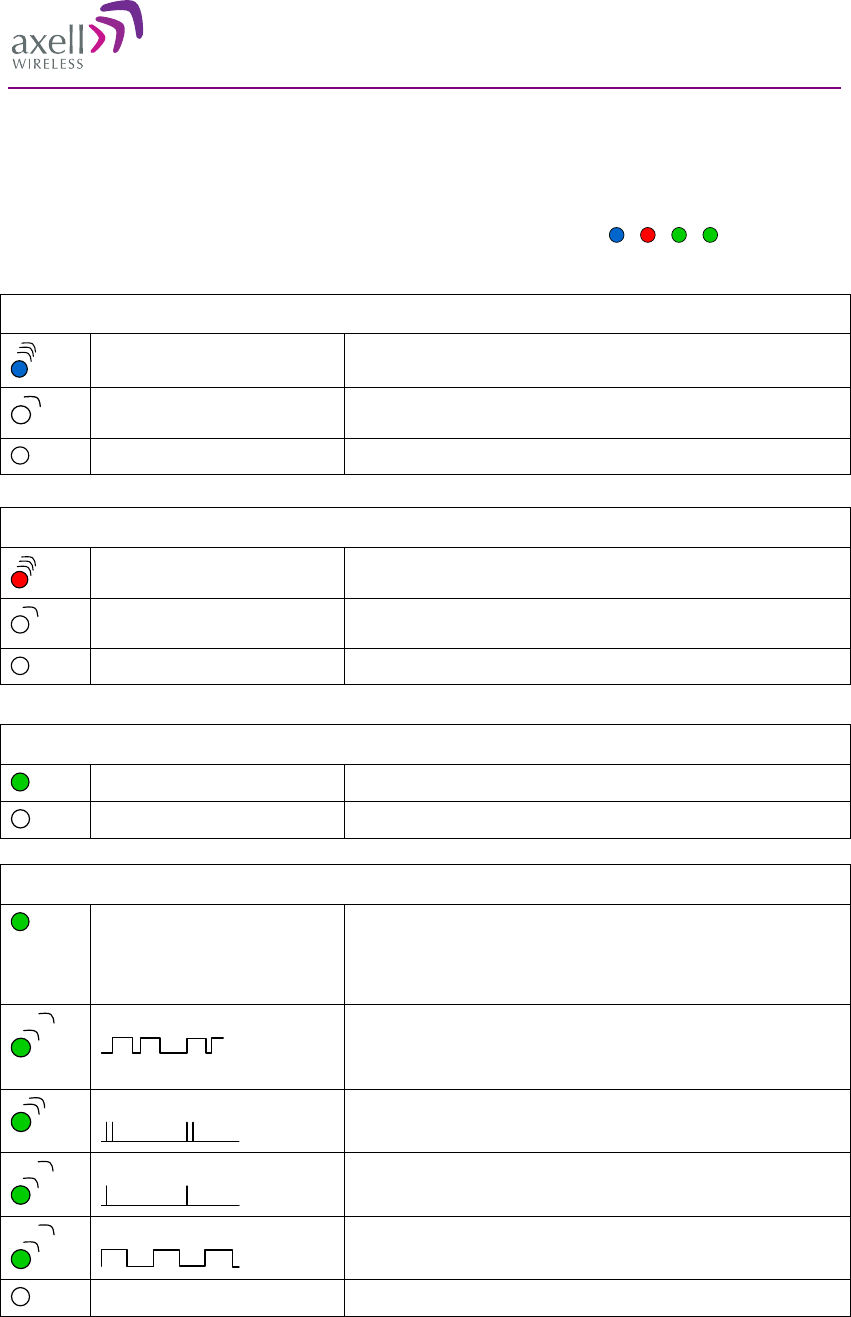
MBF, Multi Band Repeater
PRODUCT DESCRIPTION AND USER'S MANUAL
© Axell Wireless Ltd A 200 93 00, rev E 27 (105)
The Control Module has four LEDs which give information regarding
the status of the repeater and if someone is logged on to the repeater.
If the repeater is configured as a system slave the two LEDs MDM
Power and MDM Status do not fill any function and can be disregarded.
LOGIN
STATUS
MDM PWR
MDM STATUS
Blue LED - Login
Quick flash Control Module switched on, someone logged in locally and/or remotely
Off (except for a quick flash every
10th second)
Control Module switched on, no one logged in
Off (permanent) Control Module switched OFF
Red LED - Status
Quick flash Control Module switched on, one or more errors/alarms detected
Off (except for a quick flash every
10th second)
Control Module switched on, status OK
Off (permanent) Control Module switched off
Green LED – Modem Status
On Depending on type of call:
Voice call: Connected to remote party
Data call: Connected to remote party or exchange of parameters while setting up
or disconnecting a call
Flashing
(irregular)
Indicates GPSR data transfer. When a GPRS transfer is in progress the LED
goes on within 1 second after data packets were exchanged. Flash duration in
approximately 0.5s.
75ms on/75ms off/75ms on/3s off
One or more GPRS contexts activated
75ms on/3s off
Logged to network (monitoring control channels and user interactions). No call
in progress
600ms on/600ms off
No SIM card inserted, or no PIN entered, or network search in progress, or
ongoing user authentications, or network login in progress
Off Modem is off
Green LED – Modem Power
On Modem Power is on
Off Modem Power is off

MBF, Multi Band Repeater
PRODUCT DESCRIPTION AND USER'S MANUAL
© Axell Wireless Ltd A 200 93 00, rev E 28 (105)
3.6.1.1 Modem
The repeater can be equipped with a wireless modem or a PSTN modem for remote control and supervision.
Different wireless modem types are supported – GSM, EDGE, GPRS, TETRA, etc. If the repeater is
equipped with a wireless modem a SIM card holder is mounted on the Control Module.
The repeater can also be accessed via Ethernet.
Wireless modems are placed on the Control Module inside the repeater. A PSTN modem is placed in a
separate module within the repeater.
3.6.2 MCPA, Multi Carrier Power Amplifier
There is one MCPA for each band in the repeater.
3.6.3 Radio Module
There is one Radio Module for each band in the repeater. These are RF boards containing two RF-chains, one
uplink and one downlink.
3.6.4 Fibre Optic Converter
A single band MBF repeater has only one Fibre Optic Converter. A dual or tri band repeater can have one,
two or three converters depending on the mixture of frequency bands and the requirements on the system.
The Fibre Optic Converters contain both a receiver and a transmitter. The two optical signals are combined
utilizing WDM technology (Wavelength Division Multiplexing). Hence only one fibre is necessary for
transmission. The module also contains a function for the internal communication over the fibre.
The Fibre Optic Modules work in pairs in the system – one in the OMU and one in the repeater. The one
placed in the OMU is the master (Optical Master Unit) and the one placed in the repeater is the slave (Optical
Slave Unit).
The Fibre Optic Converter has a pilot tone generator that is used for detecting the optical path loss in the
fibre. This information can be used for compensation of this loss. Optical loss compensation is always
initiated from the Optical Master Unit. In the Optical Slave Unit the pilot tone is normally disabled, and only
enabled upon request (from for example the Optical Master Unit).
The Fibre Optic Converter contains two optical alarm sources. These are alarms for transmitted and received
optical signal level. The levels of the received optical signals can be monitored on-line via the RMC. This is
convenient during installation and tuning of the system. The module also has two alarm sources for the
communication between the master and the slave.
There are 6 LEDs on the
module to indicate the
status.
PWR
ERR
UL Data
DL Data
Opto Rx
Opto Tx
LED 1, Power, Green
On Unit is powered on
Off Unit has no power
LED 2, Error, Red
On Error detected
Off No error
LED 3, UL Data, Yellow
On Communication is ongoing in the uplink direction
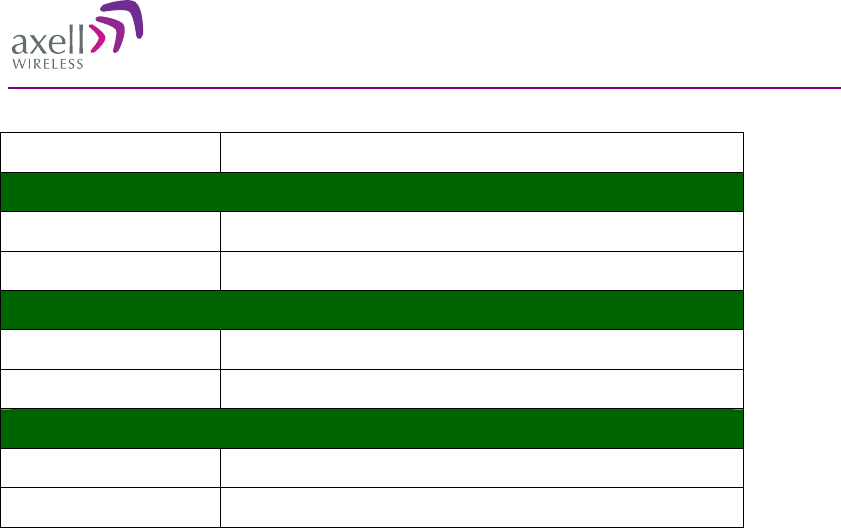
MBF, Multi Band Repeater
PRODUCT DESCRIPTION AND USER'S MANUAL
© Axell Wireless Ltd A 200 93 00, rev E 29 (105)
Off No communication
LED 4, DL Data, Yellow
On Communication is ongoing in the downlink direction
Off No communication
LED 5, Opto Rx, Green
On Received RF signal on fiber channel is above threshold
Off Input level below threshold
LED 6, Opto Tx, Green
On Transmitted RF signal on fiber channel is above threshold
Off Output level below threshold
3.6.5 Filter
The filter provides a wide band selective window for the uplink and downlink in each band on the RF antenna
end of the repeater.
3.6.6 RefGen, Reference Generator Module
The Reference Generator generates a stable reference frequency which is distributed to the radio modules of
the system. It is used as a reference signal in the synthesizer in the repeater and also in the microcontrollers in
the MCPA and Radio Module.
3.6.7 EAIM, External Alarm and Interface Module
Four external alarm sources can be connected to the alarm module, EAIM. These sources must generate a
voltage between 12 and 24 VDC. The presence or absence of this voltage will trigger the alarm depending on
how alarm thresholds have been configured in the controller software.
The module can also supply +15V to external alarm sources. The maximum allowed load on this supply is
100mA.
One relay contact closure is provided to reflect the status of the repeater. This can be used as a sum alarm.
For installation of external alarms see section 5 Installation.
3.6.8 PSUP, Power Supply
The PSUP is fed by 110/230 V AC, 50/60 Hz or -48 V DC. The PSUP generates secondary DC voltages for
the repeater modules. The input is equipped with a surge, EMI, EMC suppression filter.
The -48VDC version of the power supply is designed to turn off if the supply voltage falls below -36V
(±1V). It will turn on again as the supply voltage reaches -43V (± 1V).
On the Power Supply unit a rechargeable battery pack in mounted. This part also includes charging and
supervision electronics. The backup battery will provide the Control Module and modem with enough
capacity to send an alarm in case of input power failure.
The power supply module is connected to all other electronic modules via the distribution board.
The power supply has a switch which allows it to be set in “on” position or in “stand by”. The battery can be
switched on and off.
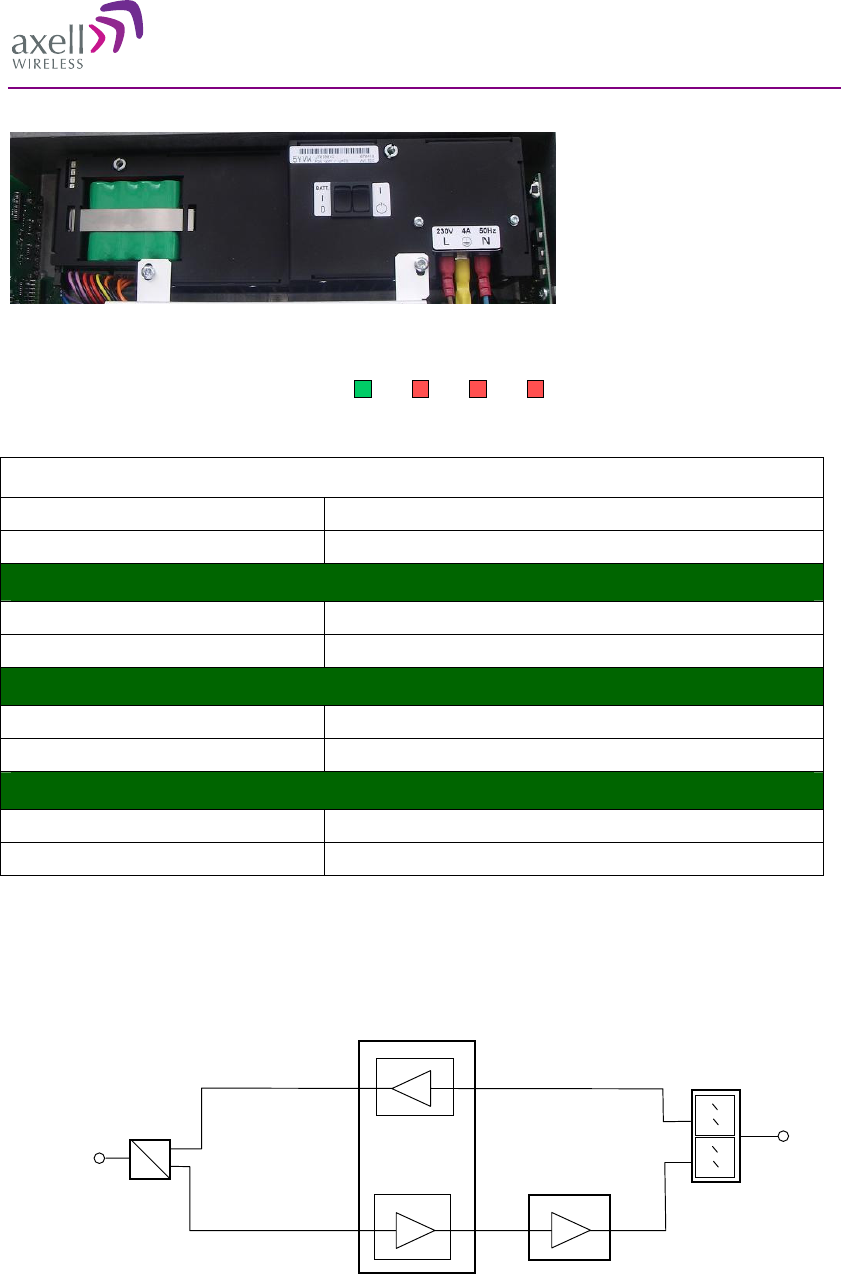
MBF, Multi Band Repeater
PRODUCT DESCRIPTION AND USER'S MANUAL
© Axell Wireless Ltd A 200 93 00, rev E 30 (105)
Power Supply
The power supply has 4 LEDs to
indicate the status.
Input
Power
+6V +15V +28V
LED 1, Input Power, Green
Slow flash Power supply unit operating on AC or DC
OFF Power supply unit not operating
LED 2, +6V, Red
Slow flash (every 10 seconds) +6V power supply operating
Quick flash +6V power supply not operating or operating with malfunction
LED 3, +15V, Red
Slow flash (every 10 seconds) +15V power supply operating
Quick flash +15V power supply not operating or operating with malfunction
LED 4, +28V, Red
Slow flash (every 10 seconds) +28V power supply operating
Quick flash +28V power supply not operating or operating with malfunction
3.7 Signal Diagrams
Duplex
Filter
RF
O
Optical
In/Out
Downlink
RF in/out
Fiber Optic
Converter
Radio Module
GSM
MCPA GSM
Uplink
~
~
~
~
~
~
~
~
~
~
~
~
Single band repeater for E-GSM
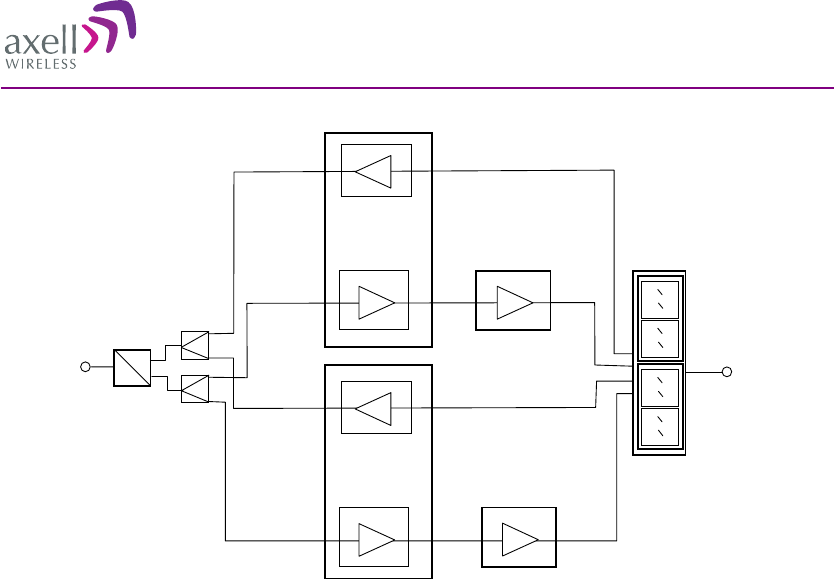
MBF, Multi Band Repeater
PRODUCT DESCRIPTION AND USER'S MANUAL
© Axell Wireless Ltd A 200 93 00, rev E 31 (105)
MCPA UMTS
2 x
Duplex
Filter
RF
O
Optical
In/Out
Downlink
Uplink
RF in/out
Fiber Optic
Converter
Radio Module
UMTS
Radio Module
GSM
MCPA GSM
Downlink
Uplink
~
~
~
~
~
~
~
~
~
~
~
~
~
~
~
~
~
~
~
~
~
~
~
~
Dual band repeater for E-GSM and UMTS
In the downlink the signal from the OMU enters the fibre optic converter in the repeater that translates the
optical signal to RF. The signal is fed to the Radio Modules. The signals are amplified in the Radio Modules
and further in the separate MCPAs. It is then fed to the combined duplex filter and out on the server port to
the antenna.
In the uplink the signal is amplified in the Radio Modules and translated to an optical signal and fed back to
the OMU.
A tri band repeater works in a corresponding way.
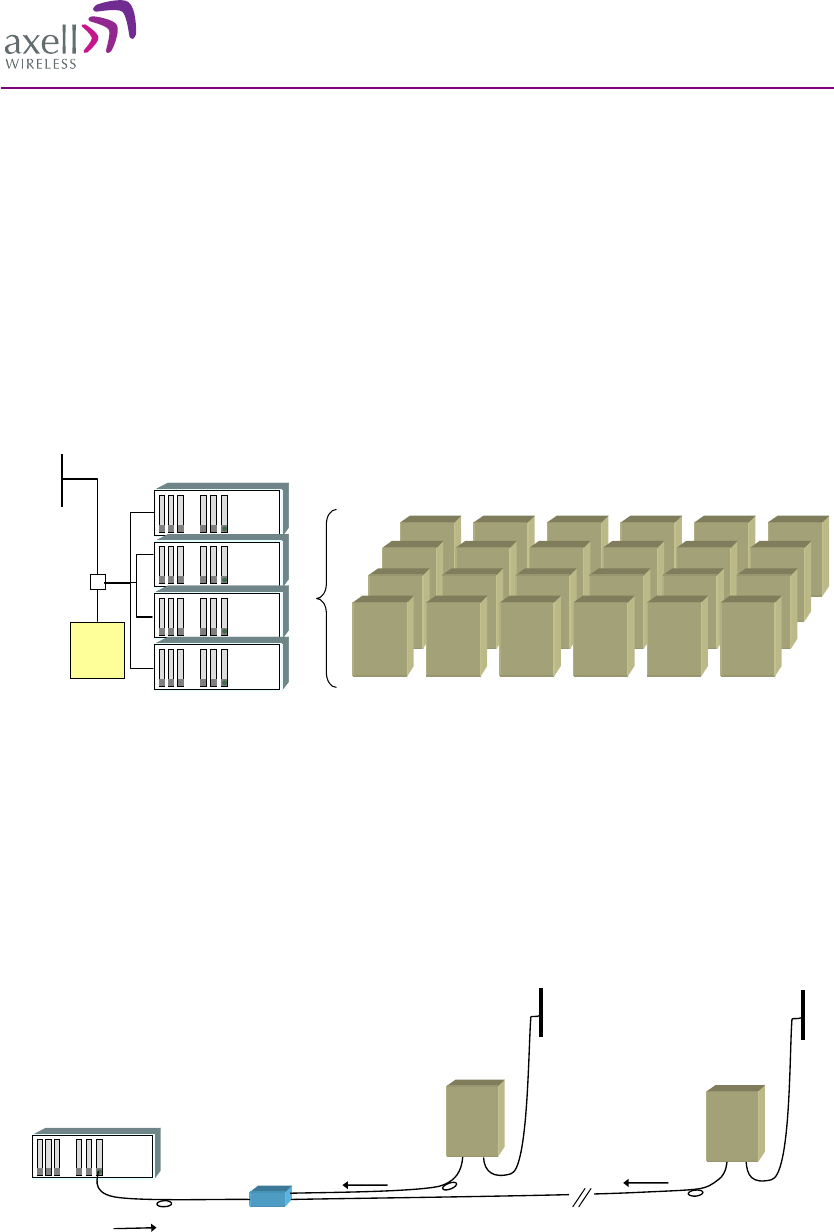
MBF, Multi Band Repeater
PRODUCT DESCRIPTION AND USER'S MANUAL
© Axell Wireless Ltd A 200 93 00, rev E 32 (105)
3.8 OMU-Repeater System
An OMU-Repeater system consists of one or more Optical Master Units and one or several fibre fed
repeaters.
An Optical Master Unit, OMU, can be equipped with up to 6 fibre optic converters. If more than 6 repeaters
are needed in the network there are two ways of expanding the system.
Link several OMUs together.
Up to 4 OMUs can be cascaded in this manner, and operate up to 24 repeaters as one system. When
OMUs are cascaded only one is equipped with a Control Module and that one manages the other OMUs
as well as all the repeaters.
BTS
RepeatersOMU Units
Four OMUs cascaded in one system
A laser system with two colors can operate one repeater for each fibre optic converter in an OMU-
Repeater system; one color is used for the uplink and one for the downlink. A laser system with three or
four colors can operate two or three repeaters per fibre optic converter. One color is used for the
downlink which is the same for all repeaters, and in the uplink each repeater uses its own color.
The connection from one repeater to the next is done via so called add-drop couplers. If needed these
couplers can be designed to balance the downlink signal to compensate for different distances to the
repeaters.
Add-drop
Coupler
Slave 1 Slave 2
OMU
1310
1550 1510
Two repeaters are connected to the same converter in the OMU via the same fibre but the wavelength for the
uplink differs between the units. Slave 1: 1550 ± 3 nm, Slave 2: 1510 ± 3 nm. The downlink signal is the same
for both repeaters.

MBF, Multi Band Repeater
PRODUCT DESCRIPTION AND USER'S MANUAL
© Axell Wireless Ltd A 200 93 00, rev E 33 (105)
3.9 Access to the System
Important Generic Information
Axell Wireless repeaters and OMUs can be configured in three different ways as regards
communication and control. They can be “stand-alone units”, “node masters” or “slaves”.
Stand-alone units do not control any other unit or take control from any other unit. All communication
with a stand-alone unit needs to be made directly with the unit – either locally or remotely via a modem
or Ethernet. Most stand-alone units are equipped with Ethernet and/or a modem for this purpose.
Node Masters keep track of the slaves that are connected to it. It is the single point of contact for alarm
reports and for heart beats in the entire system, and communicates with the AEM. All configuration and
control of all units in the network go through this Node Master. Most stand-alone units are equipped
with Ethernet and/or a modem for this purpose.
Slaves are linked to a node master. Slaves do not have modems but instead all data is transferred to the
master where it is distributed further to the AEM.
An OMU-Repeater system can be designed using repeaters that operate as slaves to the OMU or as stand
alone units regarding communication, configuration, alarms etc. Either all communication is handled by the
OMU that acts as a node master and the repeaters are slaves, or each repeater (and the OMU) handles this
communications and reporting separately.
The most common configuration is the master-slave set up which has several advantages:
All nodes can be reached from any node in the system. An operator can log in from any node in the
system and access all parameters in all nodes, including those in the OMU
Only one modem is needed for remote communication and configuration of the whole system
Since the communication runs on the same fibre as the RF, this arrangement gives a reliable supervision
of the radio link. If communication between the OMU and a repeater is broken, an alarm can be
generated immediately.
Several users at a time can be logged on to the system, for instance one locally via the RS232 interface and
one remotely via modem or Ethernet. Only one user at a time can be logged in remotely.
Note! If the network has an OMU from an earlier generation
1
, there are some limitations of what can be
accessed via a local login to a slave repeater.
3.9.1 Local Access
Local access is achieved via a RS232 interface to the LMT port in the repeater or the OMU. This port is
accessible on the front of the OMU and inside the repeater.
3.9.2 Remote Access
Remote access is achieved via modem or via Ethernet. Different types of modems are supported, for example
GSM, GSM-R and PSTN.
The modem is either placed on the Control Module or as a separate unit. When cascaded OMUs are used, the
modem is placed in the OMU unit that holds the Control Module. Ethernet connection is available on the
Control Module.
1
The earlier version of the OMU was called HUB.
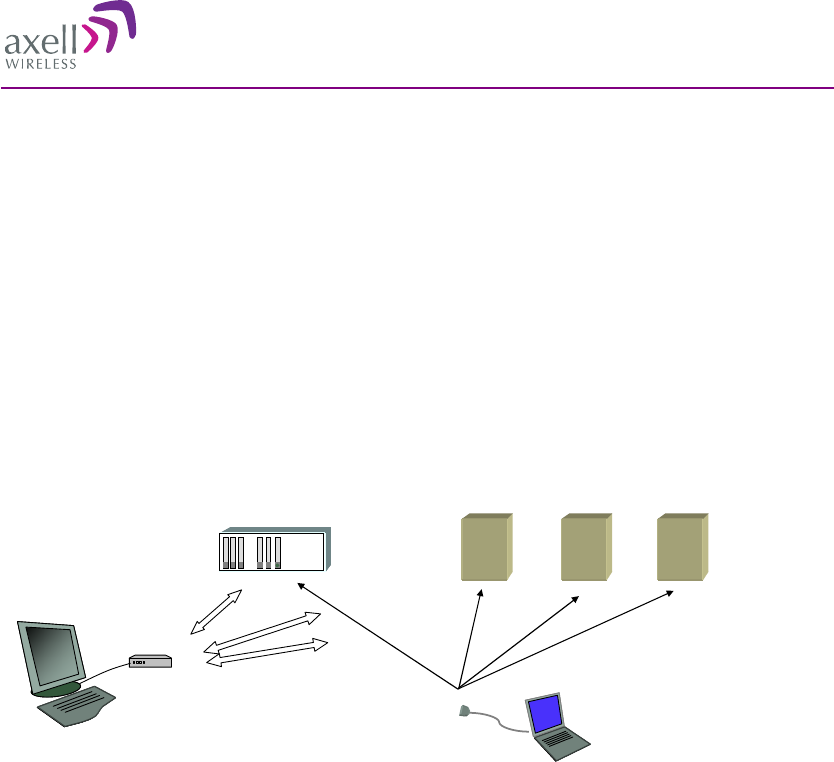
MBF, Multi Band Repeater
PRODUCT DESCRIPTION AND USER'S MANUAL
© Axell Wireless Ltd A 200 93 00, rev E 34 (105)
3.10 SW for Configuration and Control
There are two SW tools for configuration and control of the Axell Wireless OMU-Repeater system. The
RMC, Repeater Maintenance Consol and the AEM, Axell Wireless Element Manger.
The RMC is an on-line tool that can be used locally or remotely for configuration and monitoring of all
parameters in the system. It is installed on a lap-top computer and holds pre-configured screens for each
repeater type or OMU that shows the parameters live in a user-friendly manner. All parameters can be
accessed and changed on-line. In the RMC there is also a terminal mode that allows for command based
communication.
The AEM is a tool for monitoring and control of a whole network. Data from the network elements are
collected at regular intervals and alarm information are sent to the AEM as they occur. All data are
stored in a data base and can be presented in maps, reports and diagrams.
OMU Repeaters
AEM or RMC for remote monitoring via modem or Ethernet RMC for local access
Modem
GSM, PSTN or TCP/IP
data connection

MBF, Multi Band Repeater
PRODUCT DESCRIPTION AND USER'S MANUAL
© Axell Wireless Ltd A 200 93 00, rev E 35 (105)
4 Monitoring and Control
The MBF repeater can be accessed on site through the Local Maintenance Terminal (LMT) port or remotely
over a built in modem or Ethernet in the OMU (for slave-type repeaters) or via a modem or Ethernet in the
repeater.
When an RS232 cable is plugged in to the LMT port, there are two options for communication; terminal
mode or RMC mode.
Terminal mode is accessed by using a terminal emulation software, such as HyperTerminal™ or
ProComm™. Settings should be ANSI or VT100 emulation, baud rate 9600, 8 data bits, 1 stop bit, No
parity and No flow control. A simple command language is used to control the repeater in this mode.
Repeater Maintenance Console (RMC) mode allows configuration and control of the repeater via a user
friendly Windows software.
Note! All instructions in this chapter assumes that the repeater is controlled using the Repeater Maintenance
Console, RMC.
For use of the terminal mode please refer to the documents “Common Commands and Attributes” and “MBF
Commands and Attributes” which contain detailed description of all attributes and commands.
Firmware Documentation Structure
The attached documents “Common Commands and Attributes” and “MBF Commands and Attributes”
together describe all functionality in the repeater. The Common part contains functionality that is common
for all Axell Wireless repeaters of the latest generation and the MBF part contains functionality that is
specific for this repeater type.
Help Functions
When being logged in to a unit using the terminal mode the command
HELP
will list all attributes and their modes of operation and display them in alphabetic order on the screen.
Further help regarding specific commands can be had by typing
INF <command>
The INF attribute gives detailed information about a specific attribute.
4.1 Software Features - Overview
The firmware in the repeater controls and monitors all repeater parameters. Statuses and measured levels can
be read online via the RMC. This includes for instance voltage levels, RF-levels and temperatures.
In the event of a failure, an alarm is logged in the repeater. If the repeater is controlled by the AEM, the alarm
is also transmitted to the AEM. The repeater can be configured to handle alarms concerning a number of
different parameters. Each alarm can also be individually configured in a number of ways. The repeater stores
approximately 2 000 alarms in a local alarm log. The data stored regarding each alarm is the time at which an
alarm occurred and the alarm information which consists of alarm source, alarm severity, alarm attributes and
in some cases an additional alarm description.
On regular intervals, the repeater can send a heartbeat report to the AEM to confirm that the repeater is
functioning. The heartbeat message contains information about the RF-configuration and the alarm sources. It
ensures that the data communication from the repeater to the AEM is working properly. The latest 2 000
heartbeats (approximately) are stored in a log.
The Control Module keeps track of the exact repeater type it is controlling, and its performance parameters,
including maximum uplink and downlink gain, serial number of repeater, software version in Control
Module, controller hardware version, as well as hardware version of all included components.
The repeater can be equipped with a wireless modem (GSM, GSM-R, EDGE, etc) or a PSTN modem
mounted inside the repeater. The repeater is also equipped with Ethernet.

MBF, Multi Band Repeater
PRODUCT DESCRIPTION AND USER'S MANUAL
© Axell Wireless Ltd A 200 93 00, rev E 36 (105)
The Control Module contains a battery backed-up real time clock, which will stay active even during a power
failure. The real time clock is used for instance to keep track of when an alarm occurred, when to retransmit
an alarm and at what time of the day to send traffic report to the AEM.
If the repeater is controlled by the Axell Element Manager, the AEM will automatically time synchronize
repeaters, to ensure that the time is always set correctly in the entire repeater network. Slave repeaters are
synchronized from the OMU.
4.2 Network Nodes
Note! The description in this section is based on a master-slave set-up of the system, where the OMU is the
node master and the repeaters are the slaves.
An Axell Wireless OMU-Repeater system consists of an OMU unit and a number of remote nodes (repeaters)
connected to the OMU unit via fibre optic cables. During software setup of the system, all nodes installed in
the system are configured in the Control Module. Hence, the node master contains a list of all the repeaters in
the system. Once a node is added to the system, it is also written to all the nodes installed. This means that all
nodes in the repeater system have information about all other nodes, allowing for a very good overview of the
entire repeater system no matter what node the repeater system login is made from.
4.2.1 Node Identification
All nodes have a unique address within the repeater system. This address is based on the serial number of the
node. When the system is installed to the Axell Element Manager, the master unit is assigned a unique
repeater ID within the AEM database.
This number is on the form:
XX-YY-ZZZZ
where
XX is the AEM installation number within the network
YY is the region number within the AEM-system
ZZZZ is the site installation number
Within the repeater system, all slave nodes (repeaters) are given a unique ID, based on the AEM assigned ID.
The nodes share the XX-YY- part of the master ID, but the ZZZZ is replaced by the node’s serial number.
Example:
If the master’s ID is 17-42-4711 and the serial number for a node in the system is 23BJ. The node’s ID will
be 17-42-23BJ.
4.2.2 Node Addressing Modes
When logging in to the OMU-repeater system, it is possible to view information about any of the nodes in the
system, as long as they are added to the node list. All nodes can be addressed in four different ways, all
starting with the @-sign.
Numeric Addressing
Each node in the network gets a unique ID-number in the Node List as they are added to the system. Node 0
is always the master node.
Addressing is on the format:
@K
K from 0 to N where N is number of nodes
Reading a parameter from node 3 is entered as:
AVITEC AB> @3 GET ATD
14
AVITEC AB>

MBF, Multi Band Repeater
PRODUCT DESCRIPTION AND USER'S MANUAL
© Axell Wireless Ltd A 200 93 00, rev E 37 (105)
Serial Number Addressing
A node can be accessed using the serial number of the node.
Example:
AVITEC AB> @2J34 GET MDL
MBF-I
AVITEC AB>
Node ID Addressing
A node can also be addressed using the full Node ID.
Example:
AVITEC AB> @01-01-2J34 GET TAG
SITE3_TUNNEL_OPENING
AVITEC AB>
Direct Node Addressing
When many attributes are intended for another node, the user can enter Direct Node Accessing mode, where
the node the user is logged in redirects all commands to the destination node.
This mode is configured by sending the command:
SET DNA [Node Address]
where any of the node addressing modes can be used as Node Address.
When going into direct node addressing, the command prompt is changed to reflect what node is currently
addressed:
AVITEC AB> SET DNA 2J34
AVITEC AB @2J34>
Refer to attribute DNA in OMU Command and Attribute Summary for further details on direct node
addressing.
4.2.3 System Wide Parameters
System Wide Parameters are parameters that when configured should be written to all nodes in the system.
When setting a system wide parameter, the parameter is always set in the node master, which is then
responsible for setting the parameter to all other nodes. If attempting to set a system wide parameter from a
node as access to the node master is not available, setting the parameter will fail.
The following “standard” parameters are treated as system wide parameters (please refer to OMU Command
and Attribute Summary for details):
LMT Local Maintenance Terminal timeout
TIM Setting the time
DAT Setting the date
TPD Setting the time for sending traffic / utilization report to the AEM
UID User ID’s
PWD Passwords
RID Repeater ID
In slave repeaters the OMU is responsible for the communication with the AEM.
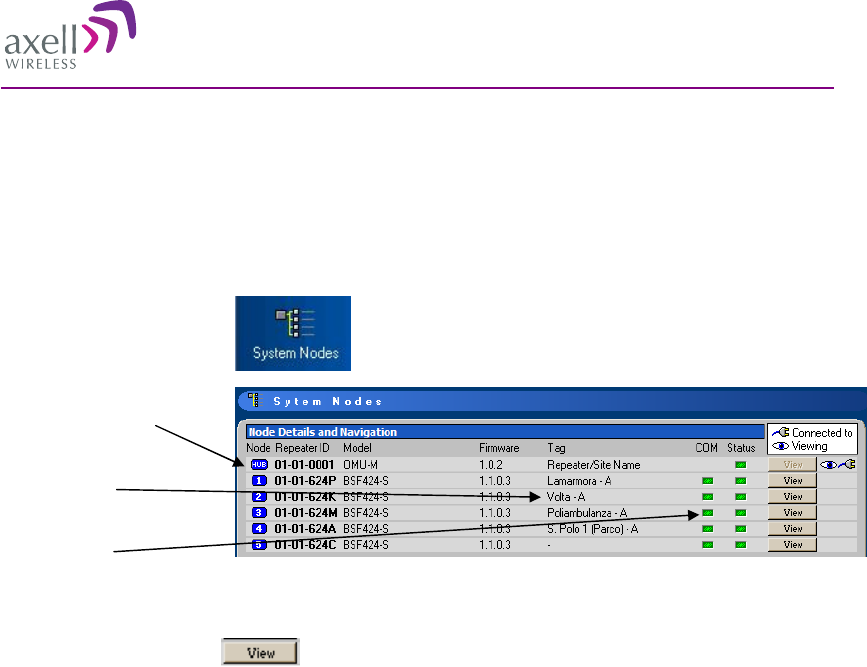
MBF, Multi Band Repeater
PRODUCT DESCRIPTION AND USER'S MANUAL
© Axell Wireless Ltd A 200 93 00, rev E 38 (105)
4.2.4 Node Access
An operator can login to the system from any node in the network and access all parameters in all nodes,
including those in the node master unit. This can be done using a serial cable connected to the node’s LMT-
port or by remote access over a modem in the master unit.
Select “System Nodes”
Node detailes: number,
ID, Model
Node name
Node status
Select a node by clicking on . The RMC will now connect to the selected node.
The OMU unit polls the connected repeaters / nodes regularly and keeps control of login requests. If a user at
a repeater site wants to log in to the system, the OMU Control Module is responsible for granting / denying
the login request. If a user forgets to log out from the node when a session is finished, the system will
automatically log the user out after a configurable number of minutes of inactivity.
4.3 Fibre Loss Compensation
Each fibre optic link in the system will induce a loss. This loss will also differ in magnitude from one link to
another since the distances between each repeater and the OMU is different. The Axell Wireless OMU-
repeater system can automatically calculate this loss, compensate for the loss in each link and by that also
balance the system.
This is accomplished by using a pilot tone of a well defined level which is sent from the master node to the
slave and vice versa. The received level of the pilot tone is measured and the loss is calculated. The Fibre
Optic Converter is automatically adjusted to compensate for the loss. The adjustment is made towards a target
value which means that the system will also be balanced (all fibers will appear to have the same loss). The
maximum compensation is 10dB which equals an unbroken fibre distance of 20 km. For each connection in
the link (for instance at the ODF) approximately 0.5 dB will have to be added to the loss.
The loss compensation function is activated by some quick commands as the system is set up. Each time the
system has been changed or fibres have been exchanged or moved for some reason, it is recommended to re-
activate this function.

MBF, Multi Band Repeater
PRODUCT DESCRIPTION AND USER'S MANUAL
© Axell Wireless Ltd A 200 93 00, rev E 39 (105)
4.4 Alarm System
The Axell Wireless repeaters contain a number of different alarm sources, both analogue and digital, to
ensure that the repeater works with desired performance.
4.4.1 Alarm Sources
Temperature Related Alarms
Alarm Code
Description Trigger
Temperature TEM Measures the temperature in the Control Module Temperature too high or
too low
Radio Board
Temperature
RBT Measures the temperature on the defined radio or
opto module
Temperature too high or
too low
Power Supply
Temperature
PTM Measures the temperature in the power supply Temperature too high or
too low
Power Related Alarms
Alarm Code
Description Trigger
Power Supply
Level
PSL Monitors the input voltage level to the repeater Level too high or too
low
Power Supply 1 PW1 Measures the +28V generated by the repeater’s
power supply.
Level too high or too
low
Power Supply 2 PW2 Measures the +15V generated by the repeater’s
power supply.
Level too high or too
low
Power Supply 3 PW3 Measures the +6.45 V generated by the repeater’s
power supply
Level too high or too
low
Power Supply 4 PW4 Measures the backed up +6.45 V generated by the
repeater’s power supply
Level too high or too
low
Battery Level BAT Measures the power level in the battery Level too high or too
low
Repeater Performance Related Alarms
Alarm Code Description Trigger
Amplifier/Gain
Downlink
AD1-4 The repeater measures the input signal level in
the downlink and compares it to expected output
power with regards to set attenuation. If the
output power is too high or too low an alarm is
triggered.
Expected output power
too high or too low
compared to calculated
output power
Amplifier/Gain
Uplink
AU1-4 The repeater measures the input signal level in
the uplink and compares it to expected output
power with regards to the set attenuation. If the
output power is too high or too low an alarm is
triggered.
Expected output power
too high or too low
compared to calculated
output power
Amplifier ASD Measures saturation in the downlink, measured Saturation enters

MBF, Multi Band Repeater
PRODUCT DESCRIPTION AND USER'S MANUAL
© Axell Wireless Ltd A 200 93 00, rev E 40 (105)
Alarm Code Description Trigger
Saturation
Downlink
on the radio module.
An amplifier chain going into saturation means
that the input signal level is too high.
defined level
Power Amplifier
Downlink Error
PAE Monitors the alarms from the MCPA Non-fatal alarms from
the MCPA
Power Amplifier
Downlink Fatal
Error
PAF Monitors the alarms from the MCPA Fatal alarms from the
MCPA
Power Downlink
Level
PD1-4 Measures the output power in the downlink. If it
drops below the configured threshold an alarm is
generated.
Output power level (too
high) or too low
Communication Related Alarms
Alarm Code
Description Trigger
Communication
with Active
Devices
COM Detects errors in the communication between the
Control Module and other active devices, such as
power supplies, radio module, MCPA, ref
generator and Fibre Optic Converter
Errors in the
communication
EEPROM CRC
check in active
devices
CRC Controls checksum in radio module, MCPA and
Fibre Optic Converter
Checksum wrong
Received Data
Packet Quality
RXQ Measures the quality of the received data from the
node master
Quality too low
Communication
between the
Radio Module
and the MCPA
CMM Monitors the communication between the Radio
Module and the related MCPA.
Errors in the
communication
Opto Related Alarms
Alarm Code
Description Trigger
Received Optical
Level
RXO Measures the received optical signal level Optical signal level too
low
Transmitted
Optical Level
TXO Measures the transmitted optical signal level No transmission
Received Pilot
Tone Level
RXP Measures the pilot tone level Level too high or too
low
Synthesizer Pilot
Tone Generator
SZP Measures the pilot tone frequency Error on pilot tone
Door Alarm
Alarm Code
Description Trigger
Door DOO Checks if the repeater’s door is open or closed Door is open

MBF, Multi Band Repeater
PRODUCT DESCRIPTION AND USER'S MANUAL
© Axell Wireless Ltd A 200 93 00, rev E 41 (105)
External Alarms
Alarm Code
Description Trigger
External Alarm 1 EX1 Monitors any alarm source, for example fire
alarms or external door sensors connected to the
external interface.
Error from alarm
source
External Alarm 2 EX2 Monitors any alarm source, for example fire
alarms or external door sensors connected to the
external interface.
Error from alarm
source
External Alarm 3 EX3 Monitors any alarm source, for example fire
alarms or external door sensors connected to the
external interface.
Error from alarm
source
External Alarm 4 EX4 Monitors any alarm source, for example fire
alarms or external door sensors connected to the
external interface.
Error from alarm
source
Relay Output for Sum Alarm
The module for external alarms contains a relay output. The relay can be used to indicate the summary status
of the repeater. Each alarm source can be configured to be affecting the relay or not.
4.4.2 Alarms and End of Alarms
When the Control Module detects a failure in the repeater, an alarm is transmitted to the Axell Element
Manager, informing the operator about the error condition. When the alarm has ceased, an end of alarm is
sent to the AEM, stating that the alarm source is now OK.
For slave type repeaters in a OMU-repeater system this communication is initiated and managed by the
OMU.
Each “alarm” and “end of alarm” updates the AEM database with the latest status of the alarm source,
ensuring that the AEM operator always has the correct repeater status in the system.
To generate an alarm a number of consecutive measurements must first show an error state. This can be
configured for each alarm source separately.
To generate an end of alarm only one OK measurement is needed.
Alarm level
Time
Alarm threshold
Alarm is sent after three
seconds above threshold
End of alarm is sent as
soon as status is OK
If an alarm should constantly toggle between OK and ERROR the communications interface might be
blocked. To prevent this there is a parameter called Minimum Alarm Repetition Cycle. This parameter
defines how many minutes must elapse before a new alarm can be transmitted from the same alarm source.
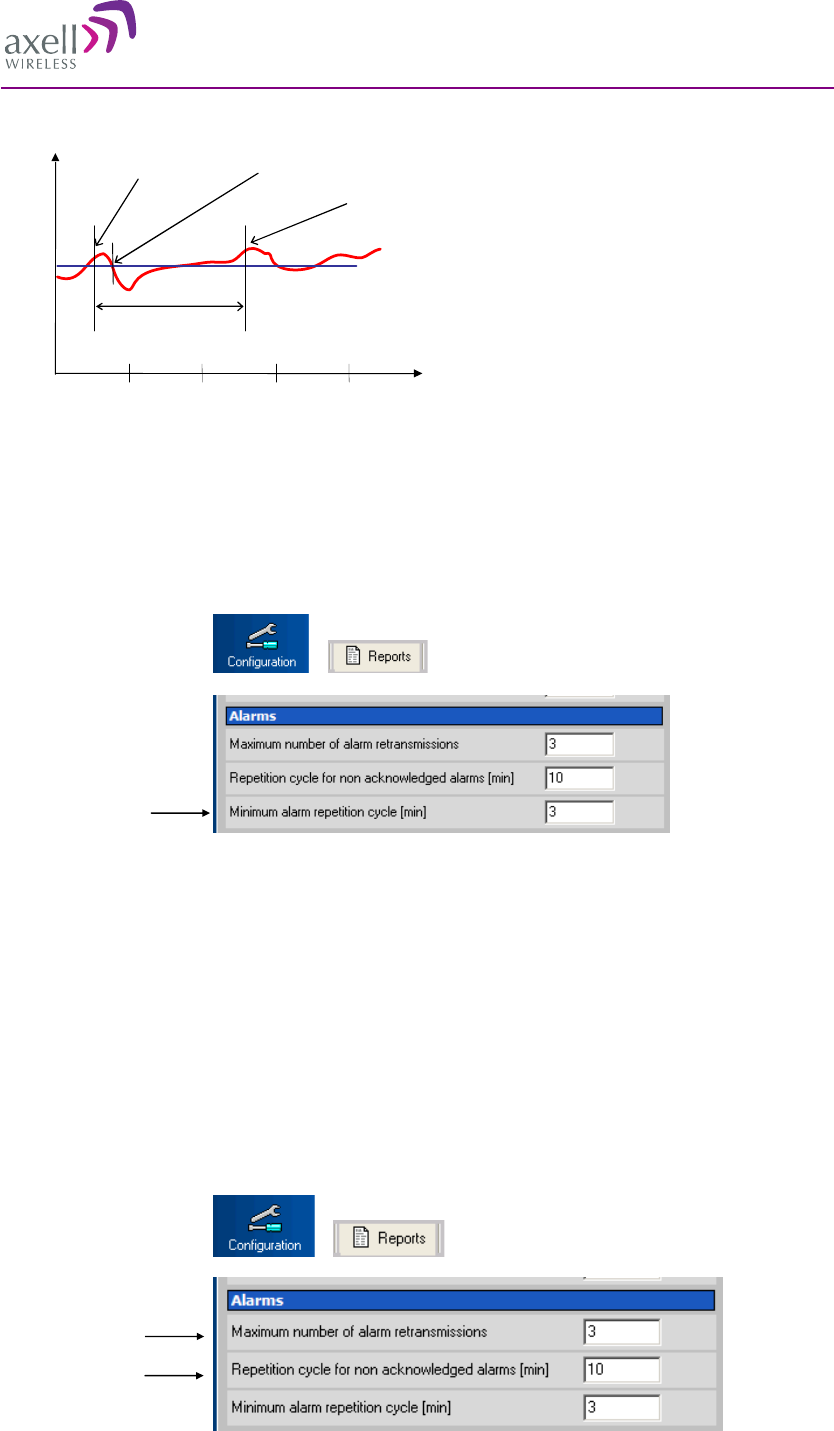
MBF, Multi Band Repeater
PRODUCT DESCRIPTION AND USER'S MANUAL
© Axell Wireless Ltd A 200 93 00, rev E 42 (105)
Alarm Threshold
Initial alarm End of Alarm
Three minutes have elapsed and a
new alarm is transmitted
Minimum alarm
repetition
Alarm level
Time
This illustration shows an alarm source with an upper threshold, and a fluctuating level around the alarm
threshold. In this example, the first alarm will be sent as indicated. The next alarm will be transmitted after
three minutes, when the minimum alarm repetition period has elapsed.
In this configuration a new alarm will not be sent before three minutes have elapsed. This variable can be set
from 0 to 99. If it is set to 0 the feature is disabled.
Set Minimum Alarm Repetition Cycle
Select
“Configuration “ and
“Reports”
4.4.3 Alarm Retransmissions and Acknowledgements
As soon as the repeater detects an alarm or an end of alarm, a connection to the Axell Element Manager is
established and the alarm event is reported.
The 2 000 latest alarms and end of alarms are stored in the repeater’s local alarm log. In case an alarm is not
acknowledged the alarm will be retransmitted to the AEM after a configurable number of minutes. Allowed
values are 0 to 999. Default retransmit interval is 10 minutes.
The retransmission will be repeated a configurable number of times. This variable can be set from 0 to 99.
Default number of retries is three
Set Number of Retransmissions and Repetition Cycle for Non-acknowledged
Alarms
Select
“Configuration “ and
“Reports”
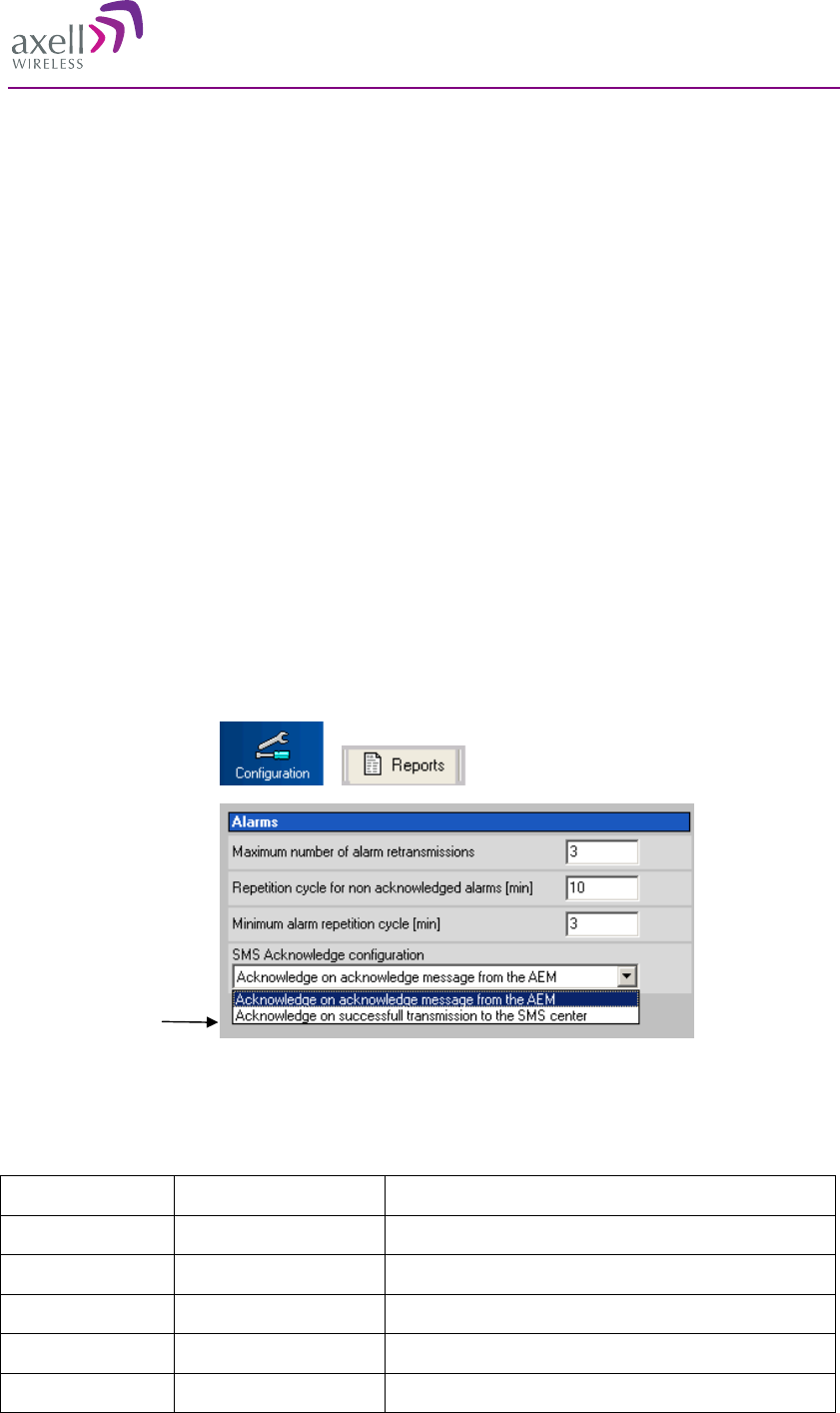
MBF, Multi Band Repeater
PRODUCT DESCRIPTION AND USER'S MANUAL
© Axell Wireless Ltd A 200 93 00, rev E 43 (105)
4.4.3.1 Alarm Acknowledgement using the RMC
Each alarm can be manually acknowledged using the Repeater Maintenance Console. However, if the
repeater is controlled by the Axell Element Manager, a manual acknowledgement of the alarm means that the
AEM will not be aware of the change in the repeater status.
4.4.3.2 Alarm Acknowledgement using the Axell Element Manager
If the repeater is integrated to and controlled by the Axell Element Manager (via an OMU or directly), an
alarm is considered acknowledged when the alarm has been delivered to the AEM. Once delivered to the
AEM, the acknowledgement of the event is taken care of locally at the AEM, why no dial-back needs to be
performed to acknowledge the alarms in the repeater.
4.4.3.3 Alarm Acknowledgement using SMS
Note! SMS functionality is not implemented in this SW release.
If the repeater is configured to send alarms using SMS, alarm acknowledgement can be made in two different
ways.
the alarm is acknowledged as soon as the alarm SMS is successfully received by the Short Message
Service Centre
or
the alarm is acknowledged by sending a special alarm acknowledgement SMS back to the repeater from
the alarm destination.
Set Acknowledgement Type for SMS Alarms
Select
“Configuration “ and
“Reports”
Pick one alternative
from the drop-down
menu
All alarms transmitted from the repeater contain a message number. Acknowledgement of an alarm is done
by sending an SMS to the repeater containing this message number.
Note! Only the defined “Primary SMS address” can acknowledge alarms.
The table below displays the format of alarm acknowledgement messages.
Message field Format Description
Repeater ID XX-YY-ZZZZ ID of the repeater that the message is intended for
Message number NNNNN Message number set by originator
Command ACT Action command
Argument ACK Acknowledge action
Argument MMMMM Message number of the alarm message to acknowledge

MBF, Multi Band Repeater
PRODUCT DESCRIPTION AND USER'S MANUAL
© Axell Wireless Ltd A 200 93 00, rev E 44 (105)
The message fields are separated with blanks.
For example, sending an SMS to the repeater with the text
01-42-4711 00242 ACT ACK 00023
will acknowledge alarm number 00023 from repeater 01-42-4711.
4.4.4 Alarm Format
Each alarm transmitted from the repeater contains a number of fields, in detail describing the event that
caused the alarm. The alarm is transmitted as an ASCII text string, each field separated by a blank/white
space.
Using the Axell Element Manager to control the repeater, the alarm string is delivered to the transceiver for
further processing in the AEM system.
When SMS is used to control the repeater, the string is sent as clear text to the alarm address (main address).
Note! The SMS functionality is not implemented in repeaters with this SW release.
Message
field
Format # of
char.
Description
Repeater ID XX-YY-ZZZZ 10 ID of the repeater causing the alarm. When monitoring the repeater using the AEM,
this repeater ID is set by the AEM during the repeater installation phase. Using
SMS, this repeater ID should be modified to uniquely identify the repeater in the
network.
Message # N 1 to 10 This integer value uniquely identifies this message from the repeater and may be
from 0 to 2147483648 (231).
Message type ALARM 5 This text string identifies the message as being an alarm (or end of alarm)
Date DDMMYY 6 Day, month and year when the alarm was detected
Time HHMMSS 6 Hour, minute and second when the alarm was detected
Alarm Name CCC 3 Identifies the alarm type (e.g. PW1, SZU, PDL, etc)
Alarm Severity CC 2 Abbreviation for severity of the alarm. This severity varies between the different
alarm sources.
CR = critical
MA = major
MI = minor
WA = warning
CL = cleared
When an and of alarm is sent, the severity is CL = cleared
Alarm Class CC 2 Abbreviation for kind of alarm
CO = communication alarm
EN = environmental alarm
QS = quality of service alarm
PR = processing alarm
EQ = equipment alarm
Status C 1 This status identifier is 0 if end of alarm and 1 if alarm.
Hardware
Enumeration
CCCC 1 to 5 Denotes what hardware module the alarm originates from. If not used, a '-' (dash) is
replied.
Position
Identifier
CCCCCCCCC
CCC
1 to 12 Gives detailed information about certain alarm sources. For some alarms, such as
VLI, LGO and CLR, this may contain user information. If not used, a '-' (dash) is
replied.
Additional text <Text>
60 This quoted string contains additional alarm information, such as measured levels
when the alarm condition was detected.

MBF, Multi Band Repeater
PRODUCT DESCRIPTION AND USER'S MANUAL
© Axell Wireless Ltd A 200 93 00, rev E 45 (105)
4.4.5 Alarm Class
Each alarm belongs to a class. The defined classes are:
Class Description
CO Communications
QS Quality of service
PR Software or processing
EQ Hardware equipment
EN Environment (enclosing or surrounding equipment)
All alarms are configured to a class at delivery but can be changed by the user. The external alarms do not
have a classification at delivery, but can be set by the user.
4.4.6 Alarm Severity
Alarms can be of five different severity levels.
Severity Level Description
Critical A critical error has occurred which affects the functionality of the repeater. This type
of alarm requires immediate action.
Major A major error has occurred. This type of alarm should be investigated within a short
time.
Minor A minor error has occurred. This type of alarm should be investigated, but is not
urgent.
Warning Something has occurred that does not affect the operation of the repeater but may be
important to notice. For example, someone has logged on to the repeater.
Cleared A cleared alarm. This is the end of alarm.
The severity can be defined for each alarm source in the Alarm Configuration screen in the RMC. It is
recommended not to change the default settings.
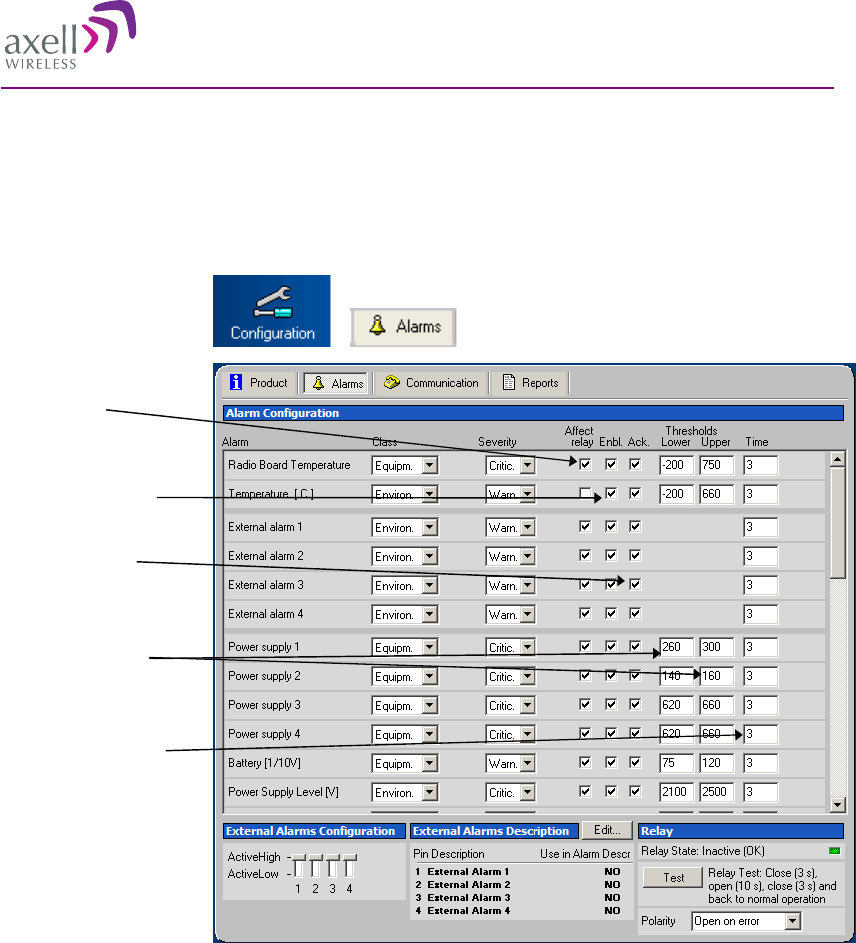
MBF, Multi Band Repeater
PRODUCT DESCRIPTION AND USER'S MANUAL
© Axell Wireless Ltd A 200 93 00, rev E 46 (105)
4.4.7 Alarm Configuration
A number of different parameters can be configured for how the alarms are transmitted to the repeater OMC.
Each alarm source can also be individually configured in a number of different ways.
Note! The alarm configuration window will differ from the one below but have similar functionality.
Select
“Configuration “ and
“Alarms”
Affect Relay
Alarm transmission
enabled
Requires
acknowledgement
Lower and upper
threshold
Number of faulty
measures before an
alarm is triggered
Affect relay If checked, an active alarm from the alarm source affects the relay status
Enabl. If checked, the alarm is transmitted to the repeater OMC
Note! This only affects the transmission of the alarm. The alarm is still
measured, and corresponding alarm status is still displayed in the repeater status
screen and in the heartbeat reports transmitted to the repeater OMC.
Ack. All alarms will by default be transmitted to the repeater OMC requiring
acknowledgement (the box is checked). Disabling this checkbox removes this
requirement, which means that an alarm will only be transmitted once,
regardless if an acknowledgement is received or not.
Lower Lower threshold, not applicable for all alarm sources. Please refer to documents
Command and Attribute Summary for details on the usage of thresholds for
each alarm source.
Upper Upper threshold, not applicable for all alarm sources. Please refer to documents
Command and Attribute Summary for details on the usage of thresholds for
each alarm source.
Time Defines how many consecutive measurements from one alarm source that
should be measured as ERROR before an alarm is triggered.
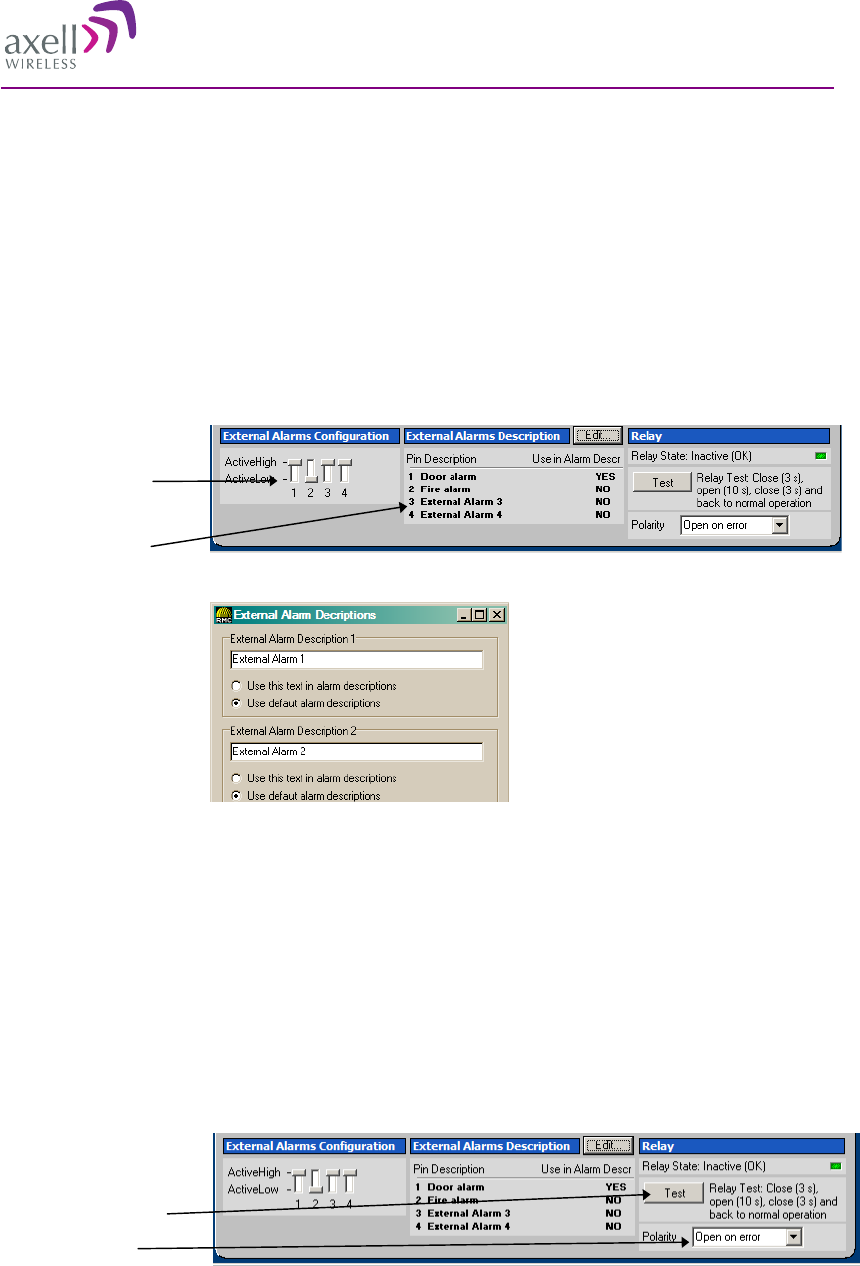
MBF, Multi Band Repeater
PRODUCT DESCRIPTION AND USER'S MANUAL
© Axell Wireless Ltd A 200 93 00, rev E 47 (105)
External Alarms
Four external alarm sources can be connected to the External Alarm module in the repeater. These can be for
instance fire alarms or external door sensors.
The alarm sources must generate a voltage between 12 and 24 VDC. The presence or absence of voltage will
trigger the alarm depending on how alarm thresholds have been configured in the controller software. Each
alarm can also be given a unique name.
The external alarms can be set as “active high” or “active low”
As for all alarm sources a delay can be set that defines how many seconds an alarm should be in error state
before an alarm is generated.
To define names and polarity of the external alarms use the lower part of the Alarm Configuration screen.
Set the dip-switches
to configure the
external alarms
Name the alarms
The external alarms
can be given
individual names of
up to 19 characters.
Click on Edit and
insert the new
names.
For more information about external alarms see 5.2.7 Connect External Alarms.
Sum Alarm
The module for external alarms contains a relay output. The relay can be used to indicate the summary status
of the repeater. Each alarm source can be configured to be affecting the relay or not.
Note! The relay status is not affected by the login / logout alarm parameters.
For installation testing purposes, it is possible to test the open / close function of the relay. This test procedure
makes sure the relay is closed for 3 seconds, then opens for 10 seconds, and finally closes for 3 seconds
before going back to original state.
The relay can be set to close or open to indicate an alarm. This can be changed by changing the polarity.
Click on Relay Test
Relay polarity
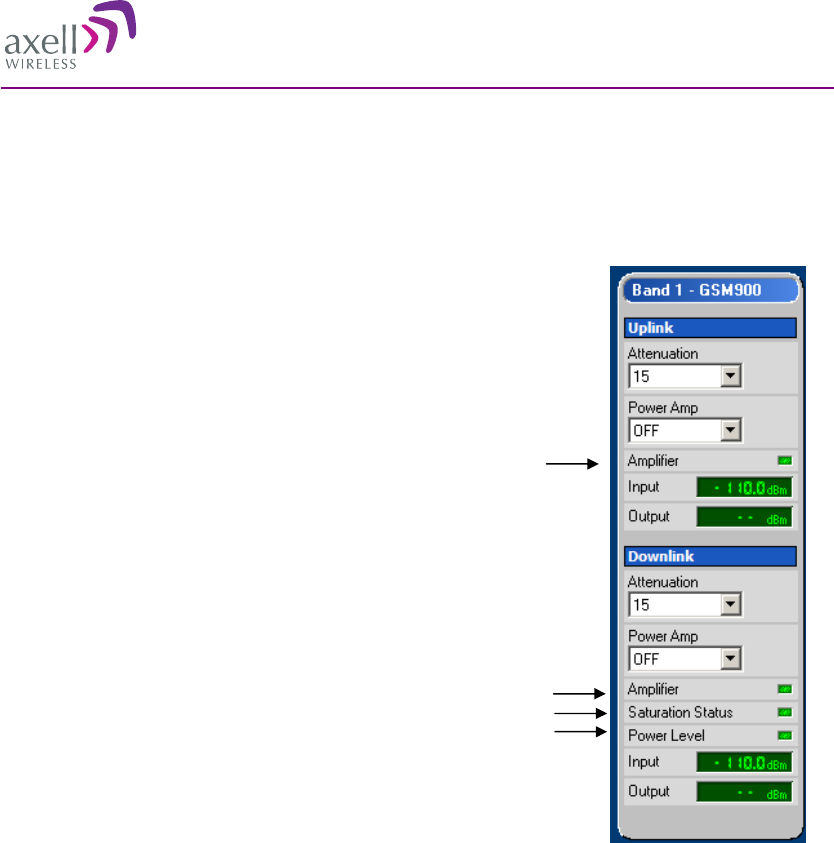
MBF, Multi Band Repeater
PRODUCT DESCRIPTION AND USER'S MANUAL
© Axell Wireless Ltd A 200 93 00, rev E 48 (105)
4.4.8 Alarm Monitoring
The alarms can be monitored via the RMC. Each alarm has an indicator that is either green or red.
See also reference to section 4.4.1 Alarm Sources.
Uplink Related Alarms
Amplifier, AU1-4. The repeater measures the input signal level
in the uplink and compares it to expected output power with
regards to set attenuation. If the output power is too high or too
low an alarm is triggered.
Downlink Related Alarms
Amplifier, AD1-4. The repeater measures the input signal level
in the downlink and compares it to expected output power with
regards to set attenuation. If the output power is too high or too
low an alarm is triggered.
Saturation Status, ASD. Measures saturation in the downlink.
Power Level, PD1-4. Measures the output power in the
downlink.
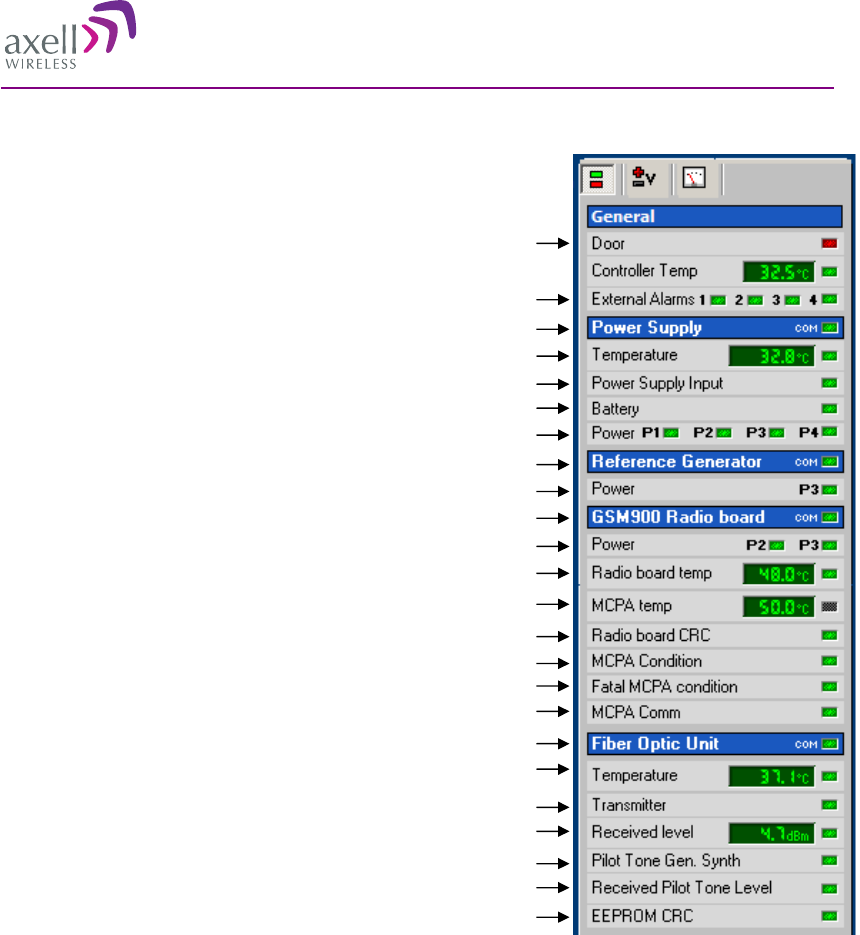
MBF, Multi Band Repeater
PRODUCT DESCRIPTION AND USER'S MANUAL
© Axell Wireless Ltd A 200 93 00, rev E 49 (105)
General Alarms
Door, DOO. Door to repeater open
Controller Temp, TEM. Temperature in Control Module too
high or too low
External Alarms, EX1-4. Alarm from external source
Power Supply Related Alarms
Com, COM. Error in communication with Power Supply
Temperature, PTM. Temperature in Power Supply too high or
too low
Power Supply Input, PSL. Input power to the repeater too high
or too low
Battery, BAT. Power level in battery too high or too low
Power P1-4, PW1-4. +28VDC, +15VDC, +6,45VD and backed
up +6,45 VDC too high or too low
Reference Generator Related Alarms
Com, COM Error in communication with module
Power P3, PW3. Relevant power to module too high or too low
Radio Board Related Alarms
Com, COM Error in communication with module
Power P2-3, PW2-3 Relevant power to module too high or too
low
Radio board temp, RBT. Temperature in Radio Board too high
or too low
MCPA temp, RBT Temperature in MCPA too high or too low
Radio board CRC, CRC Faulty checksum in Radio Board
MCPA Condition, PAE Error in MCPA
Fatal MCPA Condition, PAF Fatal error in MCPA
MCPA Com, CMM Error in communication between the radio
board and the MCPA
Fibre Optic Converter Related Alarms
Com, COM. Error in communication with module
Temperature, RBT. Temperature in Fibre Optic Converter too
high or too low
Transmitter, TXO. No detectable transmitted optical signal
Received Level, RXO. Received optical level too low
Pilot Tone Gen Synth, SZP. Pilot tone frequency faulty
Re. Pilot Tone Level, RXP. Pilot tone level too high or too low
EEPROM CRC, CRC. Faulty checksum in Fibre Optic
Converter
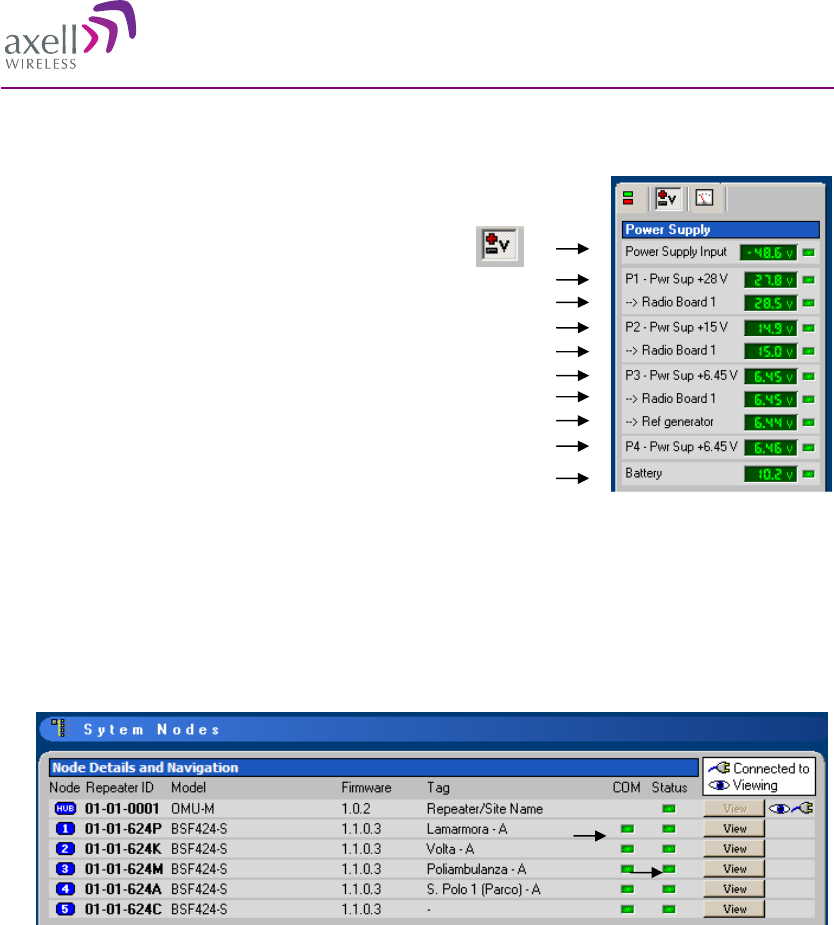
MBF, Multi Band Repeater
PRODUCT DESCRIPTION AND USER'S MANUAL
© Axell Wireless Ltd A 200 93 00, rev E 50 (105)
Power Supply Alarms
Additional power levels and alarms is monitored by clicking
Power Supply Input, PSL
P1 – Pwr Sup +28V, PW1
P2 – Pwr Sup +15V, PW2
P3 – Pwr Sup +6,45V, PW3
P4 – Pwr Sup +6,45V, PW4
Battery, BAT
System Node Alarms
COM, Node Communication, NCO. Error in communication with slave (repeater)
Status. Sum status of slave repeater
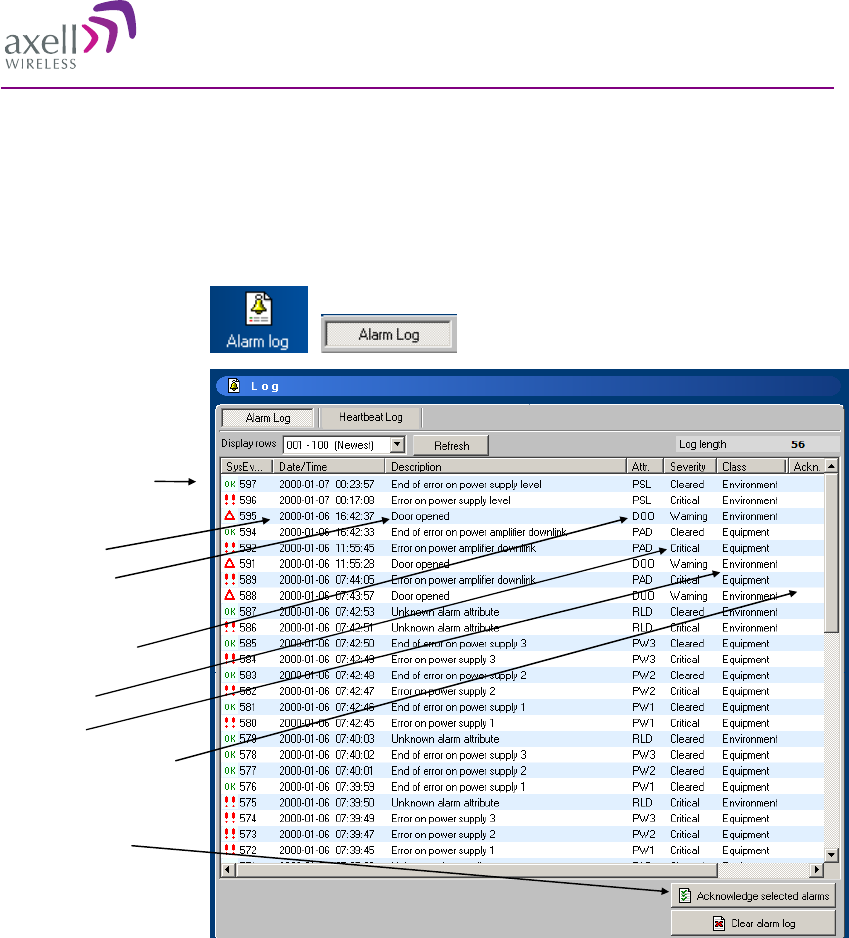
MBF, Multi Band Repeater
PRODUCT DESCRIPTION AND USER'S MANUAL
© Axell Wireless Ltd A 200 93 00, rev E 51 (105)
4.4.9 Alarm Log
Recent alarms can be viewed in an alarm log that shows details about the alarms.
Note! The alarm log window will differ from the one below but have similar functionality.
Select “Log” and
“Alarm Log”
Message No
Date/Time
Description
Attribute/Alarm
Source
Severity
Class
Alarm acknowledged
Acknowledgement
using RMC

MBF, Multi Band Repeater
PRODUCT DESCRIPTION AND USER'S MANUAL
© Axell Wireless Ltd A 200 93 00, rev E 52 (105)
4.5 Repeater Heartbeat
On regular intervals, the repeater sends a heartbeat report to the AEM to confirm that the repeater is
functioning. The heartbeat message contains information about the RF-configuration and the alarm sources. It
ensures that the data communication from the repeater to the AEM is working properly.
The heartbeat interval can be set from 1 to 1440 minutes. Setting the heartbeat to 0 disables the transmission
of heartbeats.
Slave repeaters in OMU-repeater system send the heartbeat messages to the OMU. The heartbeats are sent on
to the AEM by the OMU.
4.5.1 Heartbeat Tasks
With the heartbeat reports, a number of tasks are carried out.
4.5.1.1 Ensuring Repeater to AEM Communications path
By configuring the repeater to regularly establish a connection to the AEM, the functionality of the data
communications path between the repeater and the AEM is verified. This ensures that for instance the alarms
will be transmitted properly.
If an expected heartbeat is not received by the AEM, an alarm is generated to the AEM operator. Reasons for
a heartbeat message failing to be delivered can be:
No power – the repeater site might experience a power failure, and the battery backing up the Control
Module and modem is empty
Broken donor antenna – If the repeater antennas have been tampered with, the repeater might not get
adequate signal to establish a connection to the AEM
Failing BTS – If the feeding BTS for some reason goes down, the repeater will loose its network
connection, and hence fail to establish a connection to the Axell Element Manager.
4.5.1.2 AEM Database Synchronization
The Axell Element Manager stores all repeater parameters in a database. This database is populated during
the repeater integration into the AEM, when the AEM downloads all the repeater parameters. If the AEM
operator wants to monitor the configuration of the repeater, the parameters can be read from the database
without having to connect to the repeater.
In case of an alarm, the AEM updates the database with the status of the alarm source. In case the repeater
failed to deliver the alarm to the AEM, there will be a discrepancy between the repeater configuration and the
configuration in the database. Furthermore, if a technician at site makes changes to the RF-configuration of
the repeater, the configuration will differ from the AEM configuration.
For this reason, each heartbeat report contains all the relevant RF-parameters and status of all the alarm
sources in the repeater. This means that each heartbeat report will update the AEM with all status and RF
parameters.
Note! Once the repeater is integrated to the Axell Element Manager, it is recommended that all
reconfigurations are made from the AEM.
Note! If a user logs in to the repeater making changes, as soon as the user logs out, an alarm will be
transmitted to the AEM informing the operator that a change has been made. When this alarm is received, the
operator can initiate repeater synchronization where all repeater parameters will be updated.
4.5.1.3 Time Synchronization
Each heartbeat message transmitted to the AEM contains a time stamp of the local time inside the repeater.
Upon reception in the AEM, the time stamp is compared to the Axell Element Manager time. If the difference
between the repeater and AEM time is too big, time synchronization is initiated by the AEM, adjusting the
time in the repeater. In this ways, we ensure that a repeater integrated to the Axell Element Manager always
contains the correct time information.

MBF, Multi Band Repeater
PRODUCT DESCRIPTION AND USER'S MANUAL
© Axell Wireless Ltd A 200 93 00, rev E 53 (105)
Note! If the time is adjusted by a user logged in to the repeater, once the user logs out, a heartbeat is sent to
the AEM to ensure that the time is correctly synchronized.
4.5.2 Heartbeat Format
The heartbeat report is transmitted as an ASCII text string, with a number of fields representing the RF-
configuration and status parameters, each field separated by a blank/white space.
Using the Axell Element Manager to control the repeater, the heartbeat report is delivered to the Transceiver
for further processing in the AEM system.
Field Format # of
char
Description
Repeater ID XX-YY-ZZZZ 10
Message no NNNNNNNNN 9
State STATE 5
Date DDMMYY 6
Time HHMMSS 6
IHU NNNNNNNNN
NNN
12 Installed hardware units.
0 = not installed
1 = installed
Hardware order: PSUP1, PSUP2, RefGen, RadioUnit1, RadioUnit2, RadioUnit3,
RadioUnit4, FiberOptic1, FiberOptic2, FiberOptic3, FiberOptic4,
Comm.Multiplexer
ATD XXYYZZWW 8 Attenuation in downlink
ATU XXYYZZWW 8 Attenuation in uplink
LVD/LVU JKLMXYZW 4 Output Power Enabled / Disabled in downlink/uplink
AMD/AMU NN 2
Status of amplifier chain downlink/uplink.
These values are Hex Coded, and should be used in conjunction with COM status for
actual device.
For example, the Byte 1 status is sent as Hex ‘8’, which is extracted to 1000.
Byte 1
Bit 3 Bit 2 Bit 1 Bit 0
Amplifier Chain
1 Downlink
Amplifier Chain
2 Downlink
Amplifier Chain
3 Downlink
Amplifier Chain 4
Downlink
Byte 2
Bit 3 Bit 2 Bit 1 Bit 0
Amplifier Chain
1 Uplink
Amplifier Chain
2 Uplink
Amplifier Chain
3 Uplink
Amplifier Chain 4
Uplink
ASD N 1
Status of amplifier saturation downlink
These values are Hex Coded, and should be used in conjunction with COM status for
actual device.
For example, the Byte 1 status is sent as Hex ‘8’, which is extracted to 1000.
Bit 3 Bit 2 Bit 1 Bit 0
Amplifier Chain
1 Downlink
Amplifier Chain
2 Downlink
Amplifier Chain
3 Downlink
Amplifier Chain 4
Downlink
BAT N 1 Status of Battery Charge
CMM N 1
Status of communication between Radio Board and MCPA.
These values are Hex Coded, and should be used in conjunction with COM status for

MBF, Multi Band Repeater
PRODUCT DESCRIPTION AND USER'S MANUAL
© Axell Wireless Ltd A 200 93 00, rev E 54 (105)
Field Format # of
char
Description
actual device.
For example, the Byte 1 status is sent as Hex ‘8’, which is extracted to 1000.
Bit 3 Bit 2 Bit 1 Bit 0
MCPA Comm.
Chain 1
MCPA Comm.
Chain 2
MCPA Comm.
Chain 3
MCPA Comm.
Chain 4
COM NNNNNNNNN
NNN
12 Status of communication between controller and active devices
CRC NNN 3
Status of CRC Status for target firmware. These values are Hex Coded, and should
be used in conjunction with COM status for actual device.
For example, the Byte 1 status is sent as Hex ‘8’, which is extracted to 1000.
Byte 1
Bit 3 Bit 2 Bit 1 Bit 0
CRC
Radio Unit 1
CRC
Radio Unit 2
CRC
Radio Unit 3
CRC
Radio Unit 4
Byte 2
Bit 3 Bit 2 Bit 1 Bit 0
CRC
Fibre Optic Unit
1
CRC
Fibre Optic Unit
2
CRC
Fibre Optic Unit
3
CRC
Fibre Optic Unit 4
Byte 3
Bit 3 Bit 2 Bit 1 Bit 0
Com Mux 0 0 0
MSC NN 2
Status of MCPA, both errors and fatal errors.
These values are Hex Coded, and should be used in conjunction with CMM status
for actual MCPA.
For example, the Byte 1 status is sent as Hex ‘A’, which is extracted to 1010.
Byte 1
Bit 3 Bit 2 Bit 1 Bit 0
Fatal Error
MCPA 1
Error MCPA 1 Fatal error
MCPA 2
Error MCPA 2
Byte 2
Bit 3 Bit 2 Bit 1 Bit 0
Fatal Error
MCPA 3
Error MCPA 3 Fatal error
MCPA 4
Error MCPA 4
PDL N 1
Status of Power Downlink Level.
These values are Hex Coded, and should be used in conjunction with COM status for
actual device.
For example, the Byte 1 status is sent as Hex ‘8’, which is extracted to 1000.
Bit 3 Bit 2 Bit 1 Bit 0
Power Level
Chain 1
Downlink
Power Level
Chain 2
Downlink
Power Level
Chain 3
Downlink
Power Level
Chain 4 Downlink

MBF, Multi Band Repeater
PRODUCT DESCRIPTION AND USER'S MANUAL
© Axell Wireless Ltd A 200 93 00, rev E 55 (105)
Field Format # of
char
Description
PSL N 1 Status of Power Supply Input Level
PTM NN 2 Status of Power Supply Temperature
PW1 NN 2
Status of 28V Power Supply distribution.
These values are Hex Coded, and should be used in conjunction with COM status for
actual device.
For example, the Byte 1 status is sent as Hex ‘8’, which is extracted to 1000.
Byte 1
Bit 3 Bit 2 Bit 1 Bit 0
PW1 Power
Supply 1
PW1 Power
Supply 2
PW1 Radio Unit
1
PW1 Radio Unit 2
Byte 2
Bit 3 Bit 2 Bit 1 Bit 0
PW1 Radio Unit
3
PW1 Radio Unit
4
0 0
PW2 NN 2
Status of 15V Power Supply distribution.
These values are Hex Coded, and should be used in conjunction with COM status for
actual device.
For example, the Byte 1 status is sent as Hex ‘8’, which is extracted to 1000.
Byte 1
Bit 3 Bit 2 Bit 1 Bit 0
PW2 Power
Supply 1
PW2 Power
Supply 2
PW2 Radio Unit
1
PW2 Radio Unit 2
Byte 2
Bit 3 Bit 2 Bit 1 Bit 0
PW2 Radio Unit
3
PW2 Radio Unit
4
0 0
PW3 NN 2
Status of 6.45V Power Supply distribution. These values are Hex Coded, and should
be used in conjunction with COM status for actual device.
For example, the Byte 1 status is sent as Hex ‘8’, which is extracted to 1000.
Byte 1
Bit 3 Bit 2 Bit 1 Bit 0
PW3 Power
Supply 1
PW3 Power
Supply 2
PW3 Radio Unit
1
PW3 Radio Unit 2
Byte 2
Bit 3 Bit 2 Bit 1 Bit 0
PW3 Radio Unit
3
PW3 Radio Unit
4
PW3 Ref Gen PW3 Com Mux
PW4 N 1 Status of 6.45V Backup Power Supply distribution
RBT NNN 3
Status of Radio Board Temperatures.
These values are Hex Coded, and should be used in conjunction with COM status for

MBF, Multi Band Repeater
PRODUCT DESCRIPTION AND USER'S MANUAL
© Axell Wireless Ltd A 200 93 00, rev E 56 (105)
Field Format # of
char
Description
actual device.
For example, the Byte 1 status is sent as Hex ‘8’, which is extracted to 1000.
Byte 1
Bit 3 Bit 2 Bit 1 Bit 0
Temp Radio
Unit 1
Temp Radio
Unit 2
Temp Radio
Unit 3
Temp Radio Unit
4
Byte 2
Bit 3 Bit 2 Bit 1 Bit 0
Temp MCPA 1 Temp MCPA 2 Temp MCPA 3 Temp MCPA 4
Byte 3
Bit 3 Bit 2 Bit 1 Bit 0
Temp Fibre
Optic Unit 1
Temp Fibre
Optic Unit 2
Temp Fibre
Optic Unit 3
Temp Fibre Optic
Unit 4
RXO N 1
Status of Received Optical Level
These values are Hex Coded, and should be used in conjunction with COM status for
actual device.
For example, the Byte 1 status is sent as Hex ‘8’, which is extracted to 1000.
Bit 3 Bit 2 Bit 1 Bit 0
RXO Fibre
Optic Unit 1
RXO Fibre
Optic Unit 2
RXO Fibre
Optic Unit 3
RXO Fibre Optic
Unit 4
RXP N 1
Status of Received Pilot Tone level
These values are Hex Coded, and should be used in conjunction with COM status for
actual device.
For example, the Byte 1 status is sent as Hex ‘8’, which is extracted to 1000.
Bit 3 Bit 2 Bit 1 Bit 0
RXP Fibre
Optic Unit 1
RXP Fibre
Optic Unit 2
RXP Fibre Optic
Unit 3
RXP Fibre Optic
Unit 4
RXQ N 1 Status of Received Data Quality If repeater is NOT a system slave, this reports as a
dash.
SZP N 1
Status of Synthesizer in Pilot Tone Generator
These values are Hex Coded, and should be used in conjunction with COM status for
actual device.
For example, the Byte 1 status is sent as Hex ‘8’, which is extracted to 1000.
Bit 3 Bit 2 Bit 1 Bit 0
SZP Fibre Optic
Unit 1
SZP Fibre Optic
Unit 2
SZP Fibre Optic
Unit 3
SZP Fibre Optic
Unit 4
TEM N 1 Status of temperature in Controller
TXO N 1
Status of Optical Transmitter
These values are Hex Coded, and should be used in conjunction with COM status for
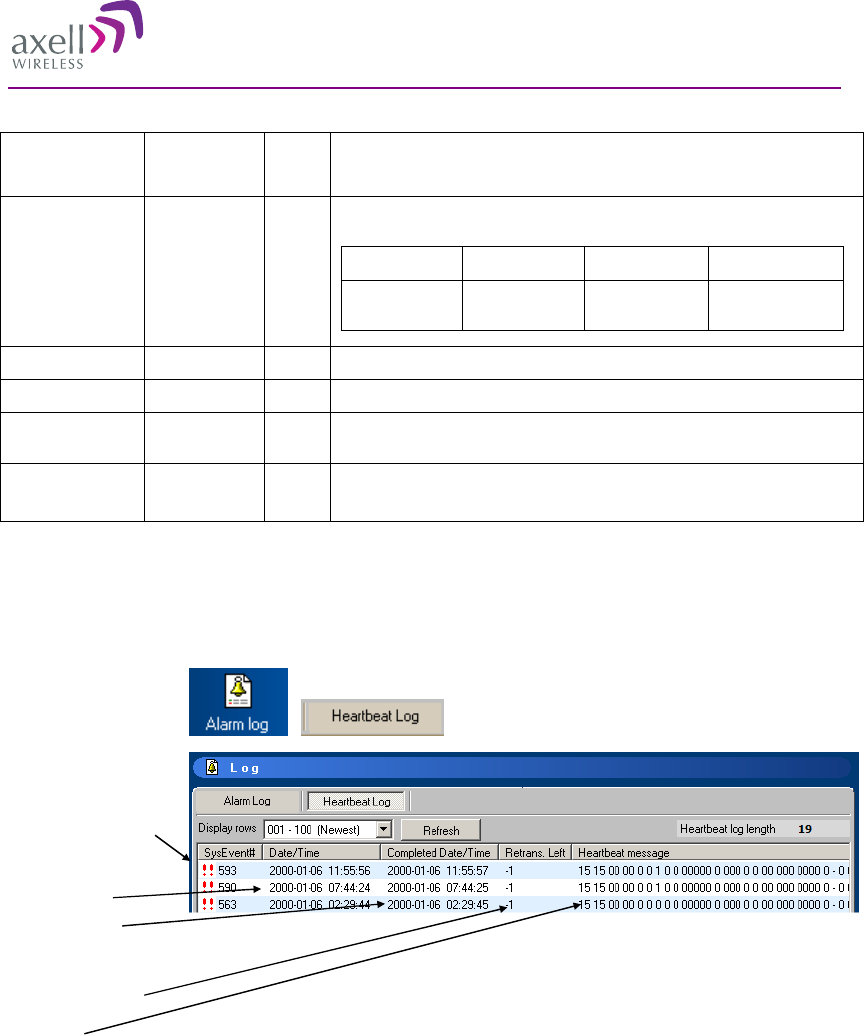
MBF, Multi Band Repeater
PRODUCT DESCRIPTION AND USER'S MANUAL
© Axell Wireless Ltd A 200 93 00, rev E 57 (105)
Field Format # of
char
Description
actual device.
For example, the Byte 1 status is sent as Hex ‘8’, which is extracted to 1000.
Bit 3 Bit 2 Bit 1 Bit 0
TXO Fibre
Optic Unit 1
TXO Fibre
Optic Unit 2
TXO Fibre Optic
Unit 3
TXO Fibre Optic
Unit 4
EX1/EX2/EX3/EX4 NNNN 4 Status of external alarm inputs
DOO N 1 Door status
NMP X 1 Communications path to node master in the Communications Multiplexer. If not
used, a dash is reported.
RCH NNNNNN 6 Repetition Cycle for Heartbeat reports
4.5.3 Heartbeat Log
Recent heartbeats can be viewed in a log that shows details about the alarms.
Monitor Alarm Log via the RMC
Select “Alarm
Log” and
“Heartbeat Log”
Message No
Date/Time
Description
Retransmissions
Message
The heartbeat message format is described in section 4.5.2 Heartbeat Format.
4.6 RF Parameters
The attenuation can be changed in 1 dB steps. If the attenuation for example is set to 15 dB, the repeater is
downgraded 15 dB from its maximum performance.
Maximum gain in the repeater can be read from the Product Information menu (choose
Configuration/Product).
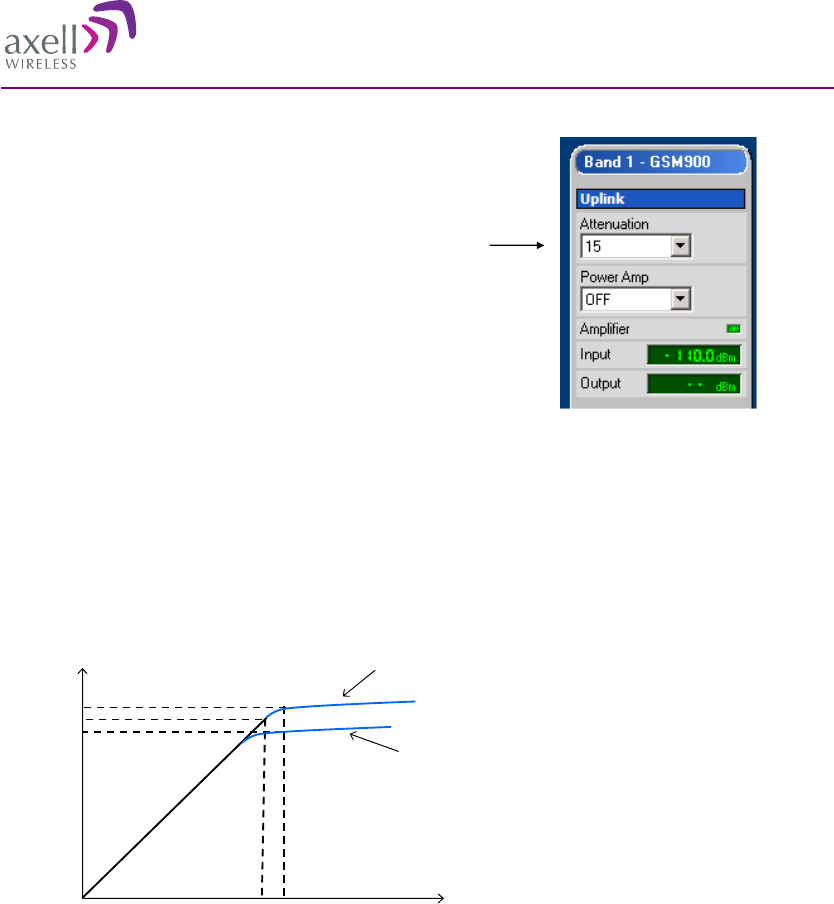
MBF, Multi Band Repeater
PRODUCT DESCRIPTION AND USER'S MANUAL
© Axell Wireless Ltd A 200 93 00, rev E 58 (105)
Setting the gain in the repeater plays an important role in the
repeater configuration.
The gain is adjusted by changing the attenuation of the
repeater. The setting is done for the uplink and downlink
separately.
The attenuation can be changed in 1 dB steps. If the
attenuation for example is set to 15 dB, the repeater is
downgraded 15 dB from its maximum performance.
Maximum gain in the repeater can be read from the Product
Information menu (choose Configuration/Product).
4.6.1 Power Level
The repeater has a constant gain in both uplink and downlink paths. The gain is set by defining the
attenuation as described above.
The repeater has a defined maximum output level. If the input signal amplified by the gain set exceeds the set
output limit, an ALC (Automatic Level Control) loop is activated. This ALC ensures that the amplifier does
not add distortion to the radio signal. Below are examples of the ALC function for one and two carriers.
ALC one carrier
Input signal, dBm
Output power, dBm
+36,5
+33,8
-24 -16
Gain: 60 dB
+35
ALC two carriers
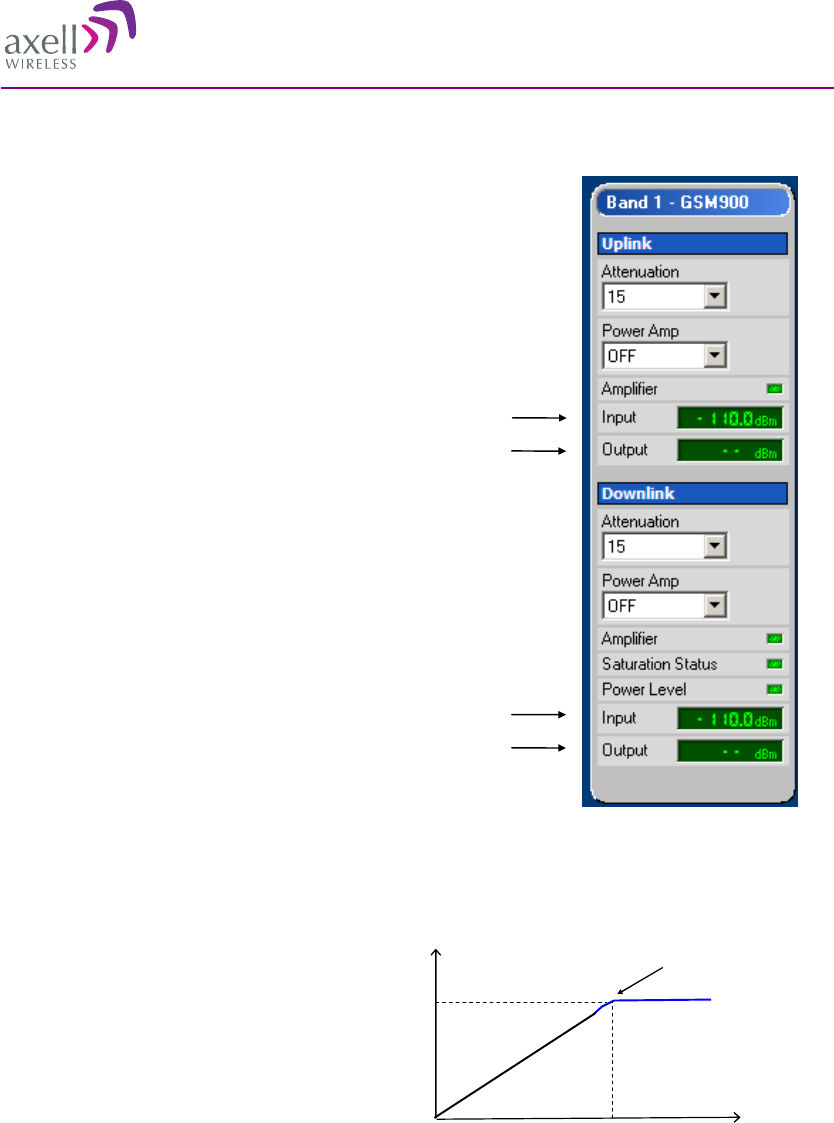
MBF, Multi Band Repeater
PRODUCT DESCRIPTION AND USER'S MANUAL
© Axell Wireless Ltd A 200 93 00, rev E 59 (105)
4.6.2 Input / Output Levels
By using the input/output values together with the gain
settings in the repeater it is possible to monitor the
functionality of the amplifier chains. These measurements can
also be useful during installation of the repeater.
Monitoring the output level is helpful in determining how
much the gain must be increased to reach maximum output
power.
The input and output power levels to and from the repeater are
constantly monitored.
If the power levels are lower than the lowest detectable level,
the RMC reports a dash.
Note! Uplink power levels can only be displayed when there is
a user in the repeater coverage area generating traffic.
In this example there is no signal on the uplink nor on the
downlink.
4.6.3 ALC
The repeater is equipped with an
ALC, Automatic Level Control.
The ALC is an immediate reaction to
the input signal level which keeps the
output level to the maximum defined
level.
+20
Input Signal, dBm
Output Power Level, dBm
Gain 70dB
-50
ALC
4.7 Hardware Identification
A repeater contains a number of different modules. Some of these are active devices meaning that they
contain a micro controller used for monitoring module parameters. Some are passive devices, for example the
external alarm interface.
The Control Module communicates with the active devices using a master/slave configuration, where the
Control Module is the master and the active devices are slaves. Each active device uses its serial number as
an address. A slave only replies to requests with the correct address information.
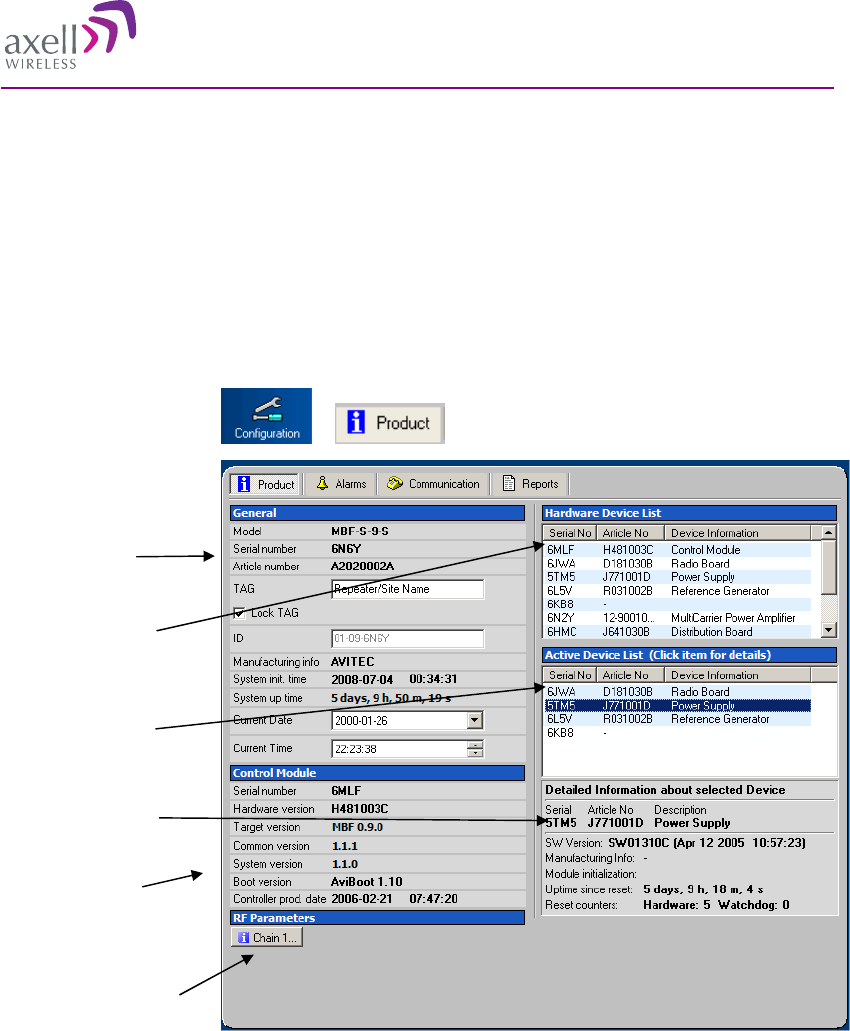
MBF, Multi Band Repeater
PRODUCT DESCRIPTION AND USER'S MANUAL
© Axell Wireless Ltd A 200 93 00, rev E 60 (105)
During manufacturing the repeater is configured with all the serial numbers of all the devices in the system.
For passive devices, the article number of the device is added. Once the system is configured, the Control
Module polls all the active devices for article numbers and production information as well as software
versions and statistics of the active devices.
Via the RMC the full repeater inventory can be read, including statistics of the active devices.
When a login to a repeater is made using the Repeater Maintenance Console, the RMC detects the repeater
type and adjusts the user interface correspondingly. The same RMC can be used for all repeater types.
Via the RMC basic information about the repeater configuration can be monitored.
Select “Configuration”
and “Product”
General repeater
information
Hardware devices
installed
Active devices
installed
More details regarding
selected item
Control Module
information
Additional information
regarding Radio Board
and MCPA
4.8 Tag and ID
When the repeater is integrated into the Axell Element Manager the repeater is assigned a repeater ID, which
is a unique identifier in the repeater network. This ID is used by the AEM to keep track of the repeaters in the
AEM database.
The repeater Tag can be used to give the repeater a more logical name, such as the site or installation place. If
Tag is set during site installation, this can easily be read by the AEM during AEM integration, giving the
AEM operator a clear identification of the site.
The repeater tag can be locked so that the tag can not be accidentally changed from the AEM.
Refer to section 5.6.2 Set Repeater Name (TAG) for information about how to set the repeater Tag.
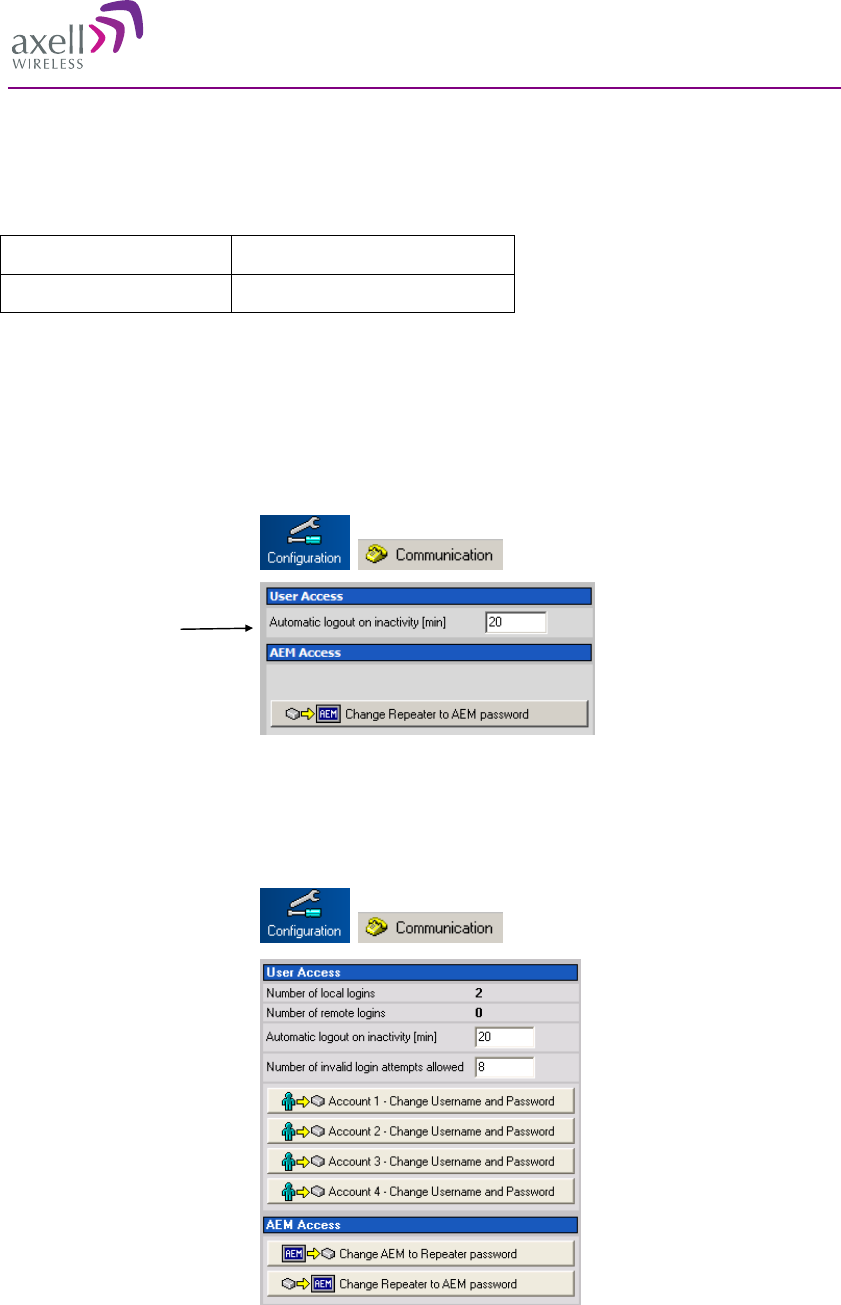
MBF, Multi Band Repeater
PRODUCT DESCRIPTION AND USER'S MANUAL
© Axell Wireless Ltd A 200 93 00, rev E 61 (105)
4.9 User Access
Several users at a time can be logged on to a Repeater, for instance one locally via the RS232 interface and
one remotely via modem. There is one default user name and password defined for the repeater.
User Name Password
avitec AvitecPasswd
Note! Both the user name and the password are case sensitive.
The password can be changed and new accounts be added once a logon has been made. This is made in
terminal mode. Please refer to the Command and Attribute Summary.
A user will be logged out after a configurable number of minutes of inactivity. This time can be defined via
the RMC.
4.9.1 Configure Automatic Logout
Select “Configuration”
and “Communication”
Note! A password for the repeater’s communication with the AEM can be set in the box above but it is
recommended that it is done from the AEM, and NOT from here.
4.9.2 Change Username or Password
Select “Configuration”
and “Communication”
Make the changes

MBF, Multi Band Repeater
PRODUCT DESCRIPTION AND USER'S MANUAL
© Axell Wireless Ltd A 200 93 00, rev E 62 (105)
4.9.3 User Access in a Network Application
An operator can login to the system from any node in the network and access all parameters in all nodes,
including those in the node master unit. This can be done using a serial cable connected to the node’s LMT-
port or by remote access over the modem (GSM or PSTN) in the master unit, or in the repeater itself.
In an OMU-repeater system with slave-type repeaters the OMU unit polls the connected repeaters / nodes
regularly and keeps control of login requests. If a user at a repeater site wants to log in to the repeater system,
the OMU Control Module is responsible for granting / denying the login request. If a user forgets to log out
from the node when a session is finished, the system will automatically log the user out after a configurable
number of minutes of inactivity.
All nodes contain a copy of all user accounts (username and password). These are updated as soon as there is
a change or at system start-up.
All configuration and changes of this information needs to be made when the node has connection with a
master. A node in standalone mode cannot change the username or password.
4.10 Integration into AEM
When the repeater has been installed at site and the remote communication has been enabled, either through
the repeater’s own modem or via an OMU, the repeater can be integrated to the Axell Element Manager. This
is done by the operator of the AEM. After entering the telephone number to the repeater, the AEM dials up
the repeater, downloads all the repeater parameters and statuses into a database. When all parameters have
been downloaded, the AEM configures the repeater with the telephone number where alarms and reports
should be sent, and optionally with a secondary telephone number where the repeater can dial in case
connection to primary number fails.
When heartbeat reports and alarms are sent from the repeater to the AEM also the latest information about the
status and RF-configuration is included. This means that the AEM operator always has information about the
current status in the AEM database (and do not need to call the repeater to find this out).
Note! Once the repeater is integrated to the AEM, all changes to the repeater should preferably be done from
the Axell Element Manager in order to ensure that the database always contains correct information.
4.11 Upgrading Firmware
The software installed in the repeater is called firmware. Using the RMC it is possible to see what firmware is
installed, install upgrades etc.
The firmware can be upgraded in the field while the repeater is operational.
The RMC is used to upload software to the Control Module. Since the Control Module contains two separate
software banks, software can be downloaded to one bank while executing from the other. Once software is
successfully uploaded, the new software is executed.
All repeater configurations remain unchanged when upgrading the software to a new version.
The Control Module contains two different program banks. The software can be executed from one bank
while new software is downloaded to the other. When new software has been completely downloaded, the
execution is moved over to the new program bank. The software download can be done at site, or remotely
via a modem.
Note! During software download no measurements will be made in the repeater. However, the RF
transmission will still be fully operational.

MBF, Multi Band Repeater
PRODUCT DESCRIPTION AND USER'S MANUAL
© Axell Wireless Ltd A 200 93 00, rev E 63 (105)
Firmware Control via RMC
View the currently
installed firmware
1. Open the Firmware upload view in RMC.
In the box labeled Installed Firmware information about the currently installed
firmware is displayed.
Upload new
firmware
1. Open the Firmware upload view in RMC. In the box labeled Firmware Location
select the directory where your firmware files (ARF files) are located.
2. Select the firmware to upload from the firmware list, labeled Select new firmware
to upload. For each firmware available, there is information about version and
compatibility with the repeater you are currently connected to. Below this list there
is a box with detailed information about the selected firmware.
3. Click Start Upload. During upload a status screen displays upload progress
information while you wait. The upload takes about 10 minutes with a local
connection and 15 minutes over the GSM network.
4. Upload completed.
5. The user is logged out and the new firmware is initiated.

MBF, Multi Band Repeater
PRODUCT DESCRIPTION AND USER'S MANUAL
© Axell Wireless Ltd A 200 93 00, rev E 64 (105)
5 Installation
5.1 Commissioning Advice
5.1.1 Introduction
To set the proper operating RF levels on the repeaters in the MBF family during commissioning there are six
steps to be carried out for each band of operation.
Set OMU DL attenuation to adjust the RF level from the BTS to suit the fibre optic converter in the
OMU (UFO-M)
Run the OLA (Optical Link Adjustment) command for each band to correct for DL optical fibre loss
Set the DL attenuation in the repeater to adjust gain following fibre optic converter in the repeater
(UFO-S)
Set the UL attenuation in the repeater to adjust gain before the fibre optic converter in the repeater
(UFO-S)
Run the OLA (Optical Link Adjustment) command for each band to correct for DL optical fibre loss
Set OMU UL attenuation to adjust the OMU output level to suit the BTS
5.1.2 OMU Point of Interface (POI)
The OMU will usually be fed from the donor BTS via an attenuator or coupling network. The electrical
configuration of this OMU Point of Interface (POI) will be system specific depending on the presentation of
the BTS RF ports, the power class of the BTS and whether the BTS itself provides coverage via
antennas/radiating cable infrastructure or if coverage is only via the MBF repeaters.
The important consideration for commissioning is that the correct attenuation exists between BTS and OMU
in order that
input power limits of OMU ports are not exceeded
operating levels can be brought into the correct range using the OMU internal attenuators
isolation is preserved between ports and bands
OMU damage levels are 10dBm RF in to the fibre optic converter.
For some systems the commissioning adjustments may be completely independent (e.g. an MBF Tri Band
repeater fed by separate OMUs, one per frequency band). For other systems (e.g. an MBF Tri Band repeater
fed a by a single OMU carrying all three bands) one adjustment may affect all bands simultaneously. In such
cases certain commissioning actions e.g. optical link adjustment only need to be carried out once for all bands
but the POI must include some means to level the different frequency bands at the OMU interface ports.
5.1.3 Downlink POI / OMU DL Attenuator Adjustment
The critical aspect for the correct system operating level is the composite power presented at the input of the
fibre optic converter in the OMU (UFO-M). The illustration below shows the simplest possible arrangement
for a single Tri Band repeater fed by three BTSs - one per band. It is assumed that the BTS for GSM900 and
GSM1800 produce two carriers each of +43dBm and that the UMTS BTS produces a single carrier of
+43dBm.
The correct interface level at the optical fibre converter is -5dBm/carrier in 900MHz and -7dBm/carrier in
both GSM1800 and UMTS bands. An attenuation of 48dB in 900MHz and 50dB in 1800/UMTS is therefore
required between them.
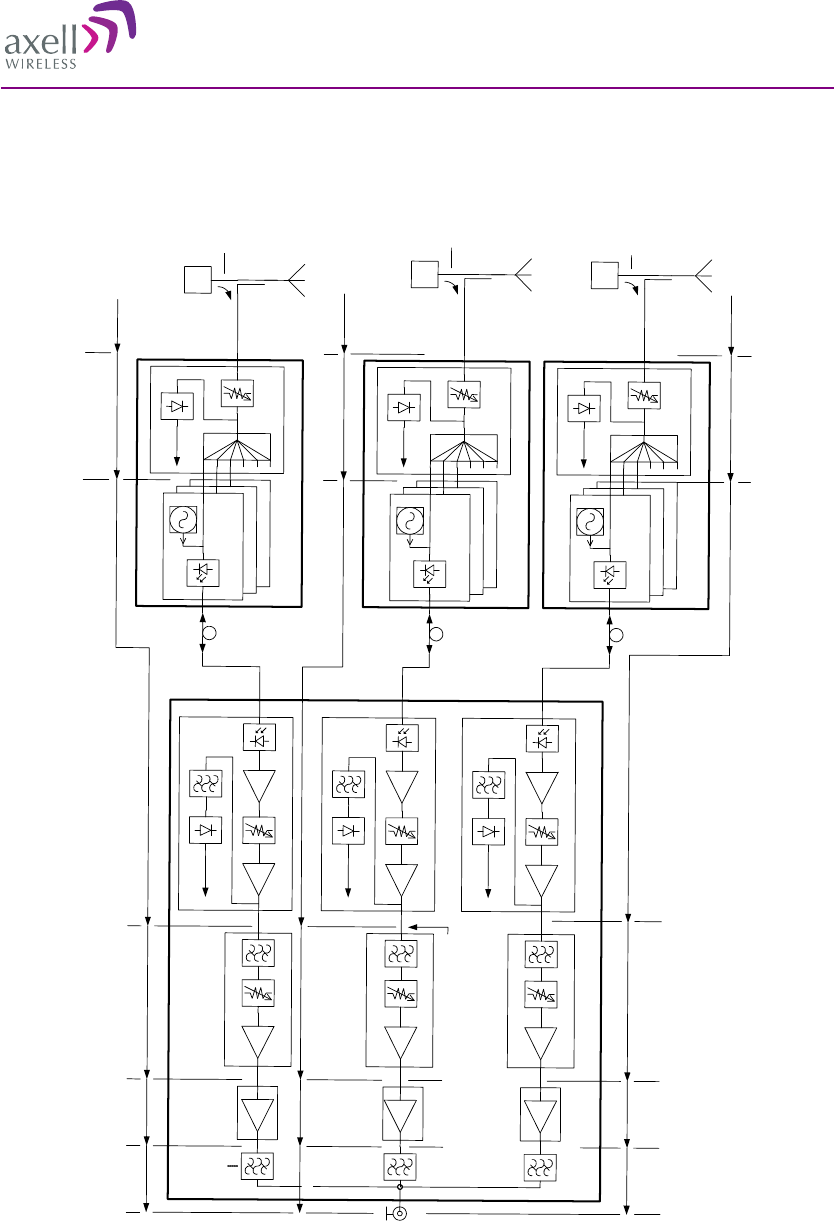
MBF, Multi Band Repeater
PRODUCT DESCRIPTION AND USER'S MANUAL
© Axell Wireless Ltd A 200 93 00, rev E 65 (105)
MBF-T-9-18-22
OMU #1
UFOM #3
UFOM #2
RB2200
BS
BS
UMTS
RB900
-17dB
-19dB
MCPA UMTS
+40dB
+24dB-1dB
+18dB
Atten=1
Atten=4
(Max Gain=25dB)
+40dB
MCPA GSM900
-1.5dB
-17dB
-1dB
-1dB-17dB
-30dB
-30dB
UMTS:
+43dBm
GSM900:
2x+43dBm
0..10dB
optical
2x+12dBm
(IL=16dB)
(IL=14dB)
(Max Gain=22dB)
2x-5dBm
2x-4dBm2x+35.5dBm2x+34dBm
+12dBm-7dBm
0dBm+40dBm+39dBm
RB1800MCPA 1800
Atten=5
+40dB
+20dB-1.5dB
2x+35.5dBm
2x-4dBm
-19dB
-1dB
(IL=16dB)
-17dB
GSM1800:
2x+43dBm
2x-7dBm
2x-24dBm
2x-24dBm
2x+12dBm
UFOSAtten: 0-20dB
PD
Pilot Level
UFOS
Atten=3
Det Pwr
UFOM #1
LD
Pilot tone
ANT
UFOSAtten: 0-20dB
PD
Pilot Level
UFOSAtten: 0-20dB
PD
Pilot Level
2x-22dBm
(Max Gain=25dB)
-24dBm
OMU #2
UFOM #3
UFOM #2
0..10dB
optical
UFOS
Atten=3
Det Pwr
UFOM #1
LD
Pilot tone
OMU #3
UFOM #3
UFOM #2
0..10dB
optical
UFOS
Atten=3
Det Pwr
UFOM #1
LD
Pilot tone
BS
GSM1800
-30dB

MBF, Multi Band Repeater
PRODUCT DESCRIPTION AND USER'S MANUAL
© Axell Wireless Ltd A 200 93 00, rev E 66 (105)
It must also be kept in mind that the OMU might have separated input/output ports for each band (UL/DL)
while the interface with the BTS may well be duplex. In that case some duplexing network must be provided
to allow these to be brought together. If there is more than one operator’s BTS per band the loss of any
combining network and any equipment room cabling also becomes part of the overall attenuation required to
reach the correct interface level in each frequency band.
The illustration on the next page shows a more complicated arrangement where the same three BTSs feed
multiple MBF repeaters (up to 6 is possible using the standard splitter card which fits the OMU rack). In this
case an OMU per frequency band is shown. The internal splitter has an insertion loss of 14 or 16dB
depending on frequency band. This loss is again a contribution to the overall attenuation which must be
provided between BTS and the input ports of the UFO-M for the correct operational levels to be achieved.
The interface levels must be modified to maintain the same composite power if a greater number of carriers is
to be applied from the BTS.
The DL POI / OMU Adjustment must be made considering the fully loaded condition – e.g. a BTS capacity
of 8 carriers must include a back off of 6dB compared to the 2 carrier level and -11dBm/carrier is then the
correct UFO-M drive level for GSM 900. The same rule for back off applies in other bands.
Note that a UMTS BTS at idle (no traffic) will be radiating only a pilot – approx -10dB compared to the
average power when it is in traffic. See also section about UMTS Signal Measurement below.
5.1.4 Repeater Downlink Optical Link Adjustment (OLA)
The optical link between the UFO-M of the OMU and the UFO-S in the repeater is equipped with a calibrated
pilot tone transmitter/receiver which enables compensation for the loss of the optical fibre plant between
them.
The OLA procedure requires a computer running Axell RMC software and an RS232 connection to the LMT
Port of the repeater controller.
Start the RMC and login to the repeater as described in the appropriate section of the handbook. Click on the
Actions tab on top of the RMC screen. A drop down list will appear where a command will be found to
execute the optical link adjustment for each UFO-S module that is fitted to the repeater. Click the command
for the desired optical link and following a short delay (2-3 secs) an information screen will be shown
describing the result of the automatic setup process.
This procedure is described in the OMU Manual section 4.10.
5.1.5 Downlink Repeater Gain Adjustment
When the DL POI levels and the repeater optical links have both been set up as described in the foregoing the
MBF repeater set at maximum gain should produce a composite signal level at the output connector of
+37dBm for GSM900 and 1800 and +39dBm for UMTS.
The RMC provides sub screens for each band where the downlink power from UFO-S optical receiver /input
to the DL radio board and the composite output power level from the MCPA can be viewed.
The power amplifier for each frequency band can be enabled /disabled and the preset DL attenuation in the
radio board for each band can be adjusted. A saturation status indicator (red/green) shows whether the radio
board ALC is in operation. This indicator should be green. A red indication indicates overdrive the cause of
which should be investigated and rectified.
In each band the DL output power per carrier should be measured using a spectrum analyzer. Allowing for
the maximum DL carrier quantity in each band the composite level per band under full loading should be
calculated to ensure it does not exceed the rated maximum otherwise ALC will be in operation when traffic
levels are high. See also section about UMTS Signal Measurement below.
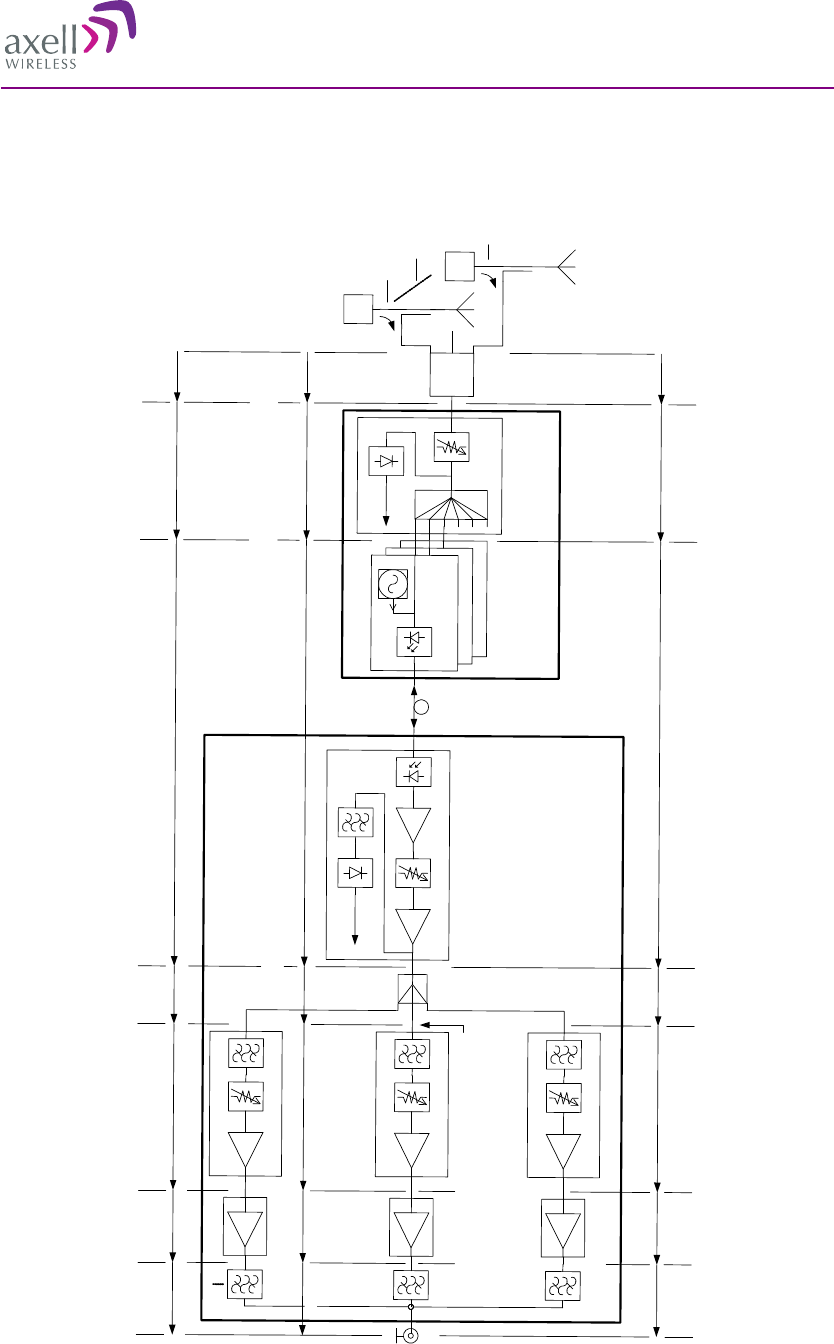
MBF, Multi Band Repeater
PRODUCT DESCRIPTION AND USER'S MANUAL
© Axell Wireless Ltd A 200 93 00, rev E 67 (105)
OMU
MBF-T-9-18-22
UFOM #3
UFOM #2
RB2200
BS
BS
GSM900
UMTS
RB900
-17dB
-19dB-4dB
MCPA UMTS
+40dB
+28dB-1dB
+22dB
Atten=1
Atten=4
(Max Gain=29dB)
+40dB
MCPA GSM900
+4dB-1.5dB
Split
-17dB
-1dB
-1dB-17dB
-30dB
-30dB
UMTS:
+43dBm
GSM900:
2x+43dBm
0..10dB
optical
2x+12dBm
(IL=16dB)
(IL=14dB)(Max Gain=26dB)
2x-5dBm2x-22dBm2x-26dBm2x-4dBm2x+35.5dBm2x+34dBm
+12dBm-7dBm-24dBm-28dBm0dBm+40dBm+39dBm
RB1800MCPA 1800
Atten=5
+40dB
+24dB-1.5dB
-4dB
2x+35.5dBm
2x-4dBm
-19dB
-1dB
(IL=16dB)
-17dB
GSM1800:
2x+43dBm
2x-7dBm
2x-24dBm
2x-28dBm
(Max Gain=29dB)
2x+12dBm
UFOSAtten: 0-20dB
PD
Pilot Level
UFOS
Atten=3
Det Pwr
UFOM #1
LD
Pilot tone
Comb
Netw
ANT

MBF, Multi Band Repeater
PRODUCT DESCRIPTION AND USER'S MANUAL
© Axell Wireless Ltd A 200 93 00, rev E 68 (105)
5.1.6 UMTS Signal Measurement
The UMTS signal carries wideband and complex modulation and its properties vary depending on the level
of traffic carried.
5.1.6.1
Bandwidth
The first issue is the wideband nature of the signal. It occupies around 3.8MHz and measurements through a
narrower filter will reduce the apparent power level since only a portion of the signal reaches the detector in
the test equipment.
Equipment that includes a UMTS/3G measurement personality simplifies the task considerably. Usually a
stored configuration for power measurement will integrate many samples taken using a narrower filter to
display the correct power level for the bandwidth of the signal. Settings can easily become corrupted however
leading to erroneous results. In such cases following the manufacturers instructions in detail is advised.
Measuring with a simple spectrum analyzer must use a wider resolution bandwidth than 3.8MHz or else a
bandwidth correction factor has to be applied to the observed result. E.g. if measuring with a 300kHz RBW
the power level in the centre of the signal would appear to be around 11dB lower than actual (10Log
3.84/0.3).
5.1.6.2
Traffic
A further complication is that the power level of a UMTS signal depends on the traffic level being carried.
UMTS carrier power is usually quoted as average values e.g. a 5Watt or 37dBm signal can contain peaks up
to 10dB greater when traffic is high. An idling base station carrying no traffic radiates only a Pilot in which
case the power observed is around 10dB below the average value with traffic.
Advanced test equipment that can measure the different code power components in the UMTS signal avoids
this problem but more often in the field repeater commissioning must be done when only simple test
equipment is available. This leads to the need to know and allow for the state of traffic when making repeater
setup and diagnostic measurements. It is obvious that adjusting a repeater to maximum rated output power by
using BTSs that are idling radiating only the pilot will lead to overloading when they are in traffic.
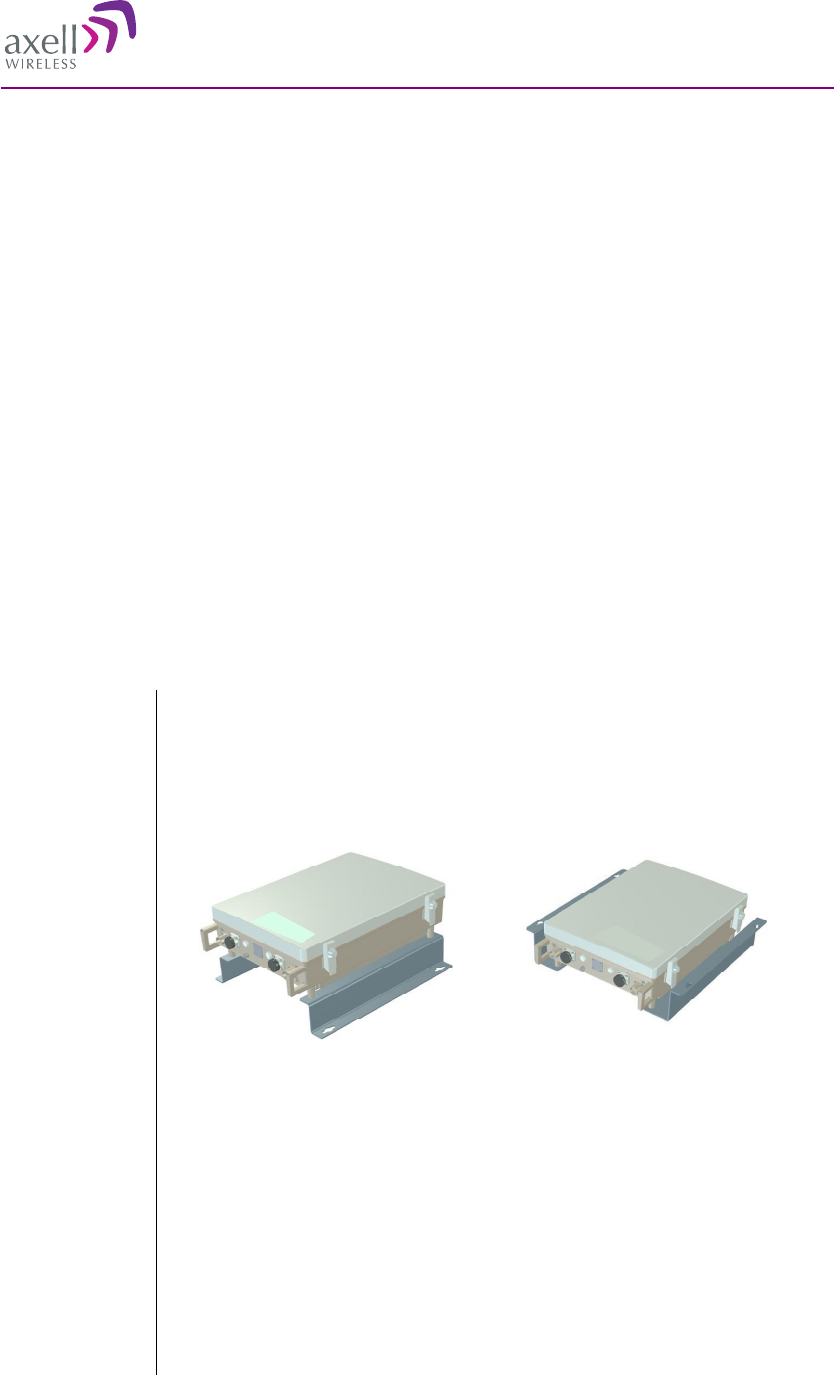
MBF, Multi Band Repeater
PRODUCT DESCRIPTION AND USER'S MANUAL
© Axell Wireless Ltd A 200 93 00, rev E 69 (105)
5.2 Install the Repeater
5.2.1 Unpack the Repeater
Unpack the
repeater
Inspect the shipped material before unpacking the equipment, document any visual
damage and report according to routines.
A delivery of a repeater from Axell Wireless contains:
Checklist with delivered items
Repeater
Mounting brackets
4 bolts for attaching repeater to mounting kit
Cable cover
Keys to repeater and insex tool for bolts
Hose for fibre inlet
CD containing User’s Manual and RMC
Any other specifically ordered item
5.2.2 Mount the Repeater
Mount the
repeater on a wall,
on a pole or in a
rack
Mount the repeater in an accessible location and in a location that fulfils the
environmental requirements.
The repeater can be mounted on the wall or in a 19 inch rack. The Repeater is
delivered with mounting brackets.
The repeater needs to be mounted tightly to eliminate vibrations
Mounting bracket position for w
all
mounting
Mounting bracket position for
r
ack
mounting
Ensure proper
ventilation
Mount the repeater so that heat can be dispersed from it. The repeater wall mounting
kit ensures an optimum airflow between the wall and the repeater itself. Do not
block this air channel as it will cause the MTBF of the repeater to drop dramatically,
or even in the worst case cause the repeater to fail completely.
If possible use a wall in the shadow to minimize the overall sun loading. If sufficient
shielding cannot be obtained, an additional sun shield should be mounted.
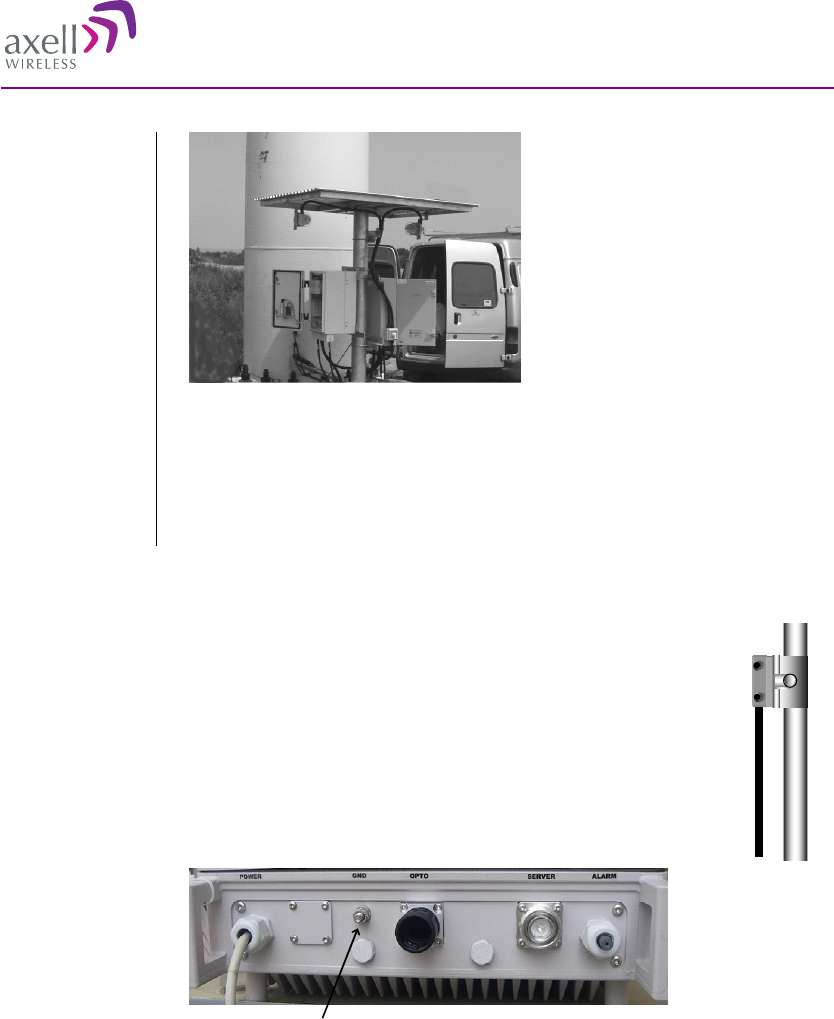
MBF, Multi Band Repeater
PRODUCT DESCRIPTION AND USER'S MANUAL
© Axell Wireless Ltd A 200 93 00, rev E 70 (105)
Example of a sun shield
IP65 Casing Note! The repeater box should be closed using the two screws. The screws must be
fully tightened. Failure to do so may affect the IP65 compliancy and therefore any
warranty.
5.2.3 Ensure Proper Grounding
Connect the
grounding
protection
Ensure that good grounding protection measures are taken to create a
reliable repeater site. Make sure to use adequately dimensioned
grounding cables. The minimum recommended conductive area for a
grounding cable is 16mm
2.
The antenna cabling should be connected to ground every 10m by a
reliable grounding kit.
Make sure the grounding product used is suitable for the kind and size
of cable being used.
Connect the repeater box bolt to the same ground.
Ground
Ground connector on repeater
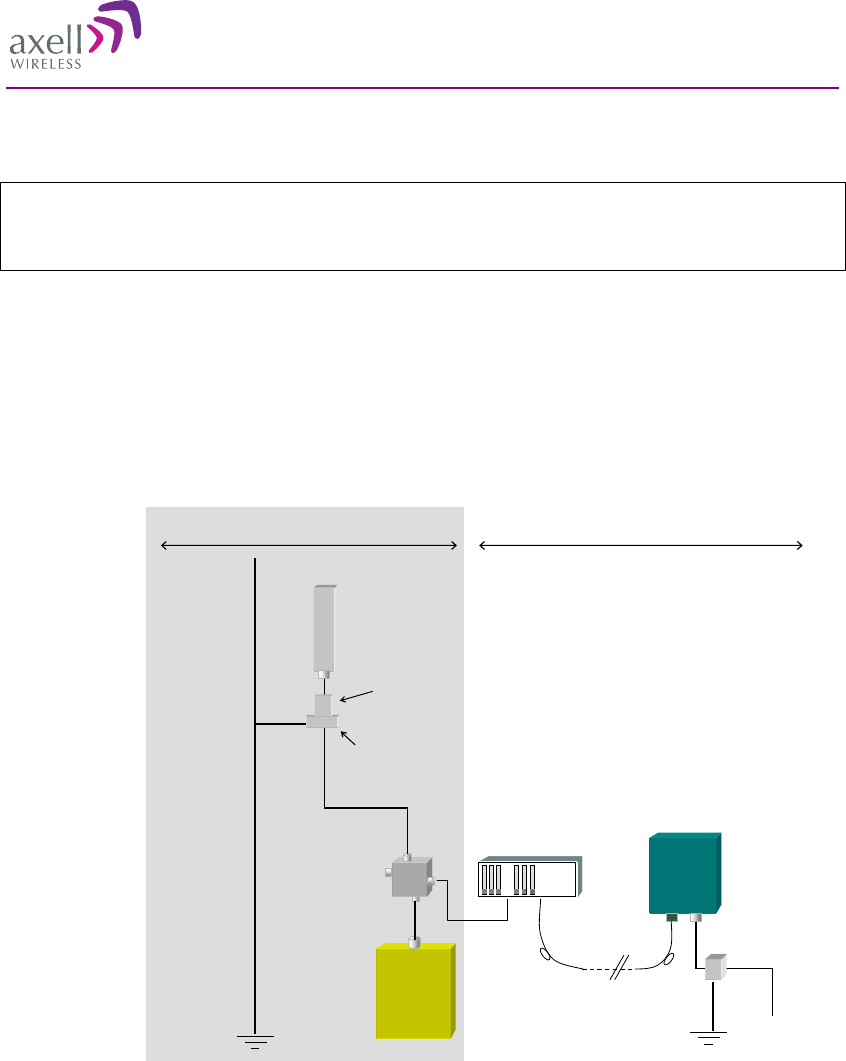
MBF, Multi Band Repeater
PRODUCT DESCRIPTION AND USER'S MANUAL
© Axell Wireless Ltd A 200 93 00, rev E 71 (105)
5.2.4 Ensure Good EMV Protection
Caution
If insufficient Electromagnetic Protection is provided,
or if EMV measures are not taken, warranties issued by Axell Wireless are not valid.
Connect the
lightning
protection
The lightning hazard to electric and electronic equipment consists in the interferences of
direct lightning current infections and high surge voltages induced by the electromagnetic
field of nearby lightning channels or down conductors. Amplitudes from cloud-to-earth
lightning amounts to several 10kA and may last longer than 2 ms. The damage caused
depends on the energy involved and on the sensitivity of the electronics systems.
Ensure that lightning protection measures are taken to create a reliable repeater site.
Protect all coaxial cables and power cables from the transients caused by lightning. Fit all
cables with suitable lightning protection devices.
Repeater
Fiber
BTS
-30dB
Coupler
OMU
Antenna
Primary
Protective
Device
Equipotential
Grounding Bar
230VAC/
-48VDC
Protective
Device
The top of
the mast
must be
higher than
the antennas
and be
grounded
properly
The
grounding
path must
have reliable
continuity
and be
dimensioned
correctly
BTS area Repeater area
Example of EMV protection for a repeater system
For detailed information please refer to IEC 61024-1 and 61312-1 for international
standards for protection of information systems against LEMP, Lightning Electromagnetic
Pulse, including radio transmitters. They define proper planning, installation and
inspection of effective lightning protection systems.
The Axell Wireless repeaters comply with the EN standard ETS 301 498-8 which
stipulates demands on lightning/surge protection for typical infrastructure telecom
equipment installations.
Several lightning protection devices should be used in series with declining threshold
voltages to help attenuate the pulse component which makes it through the first layer of
protection.
The primary protective device is part of the site installation and is not supplied by Axell
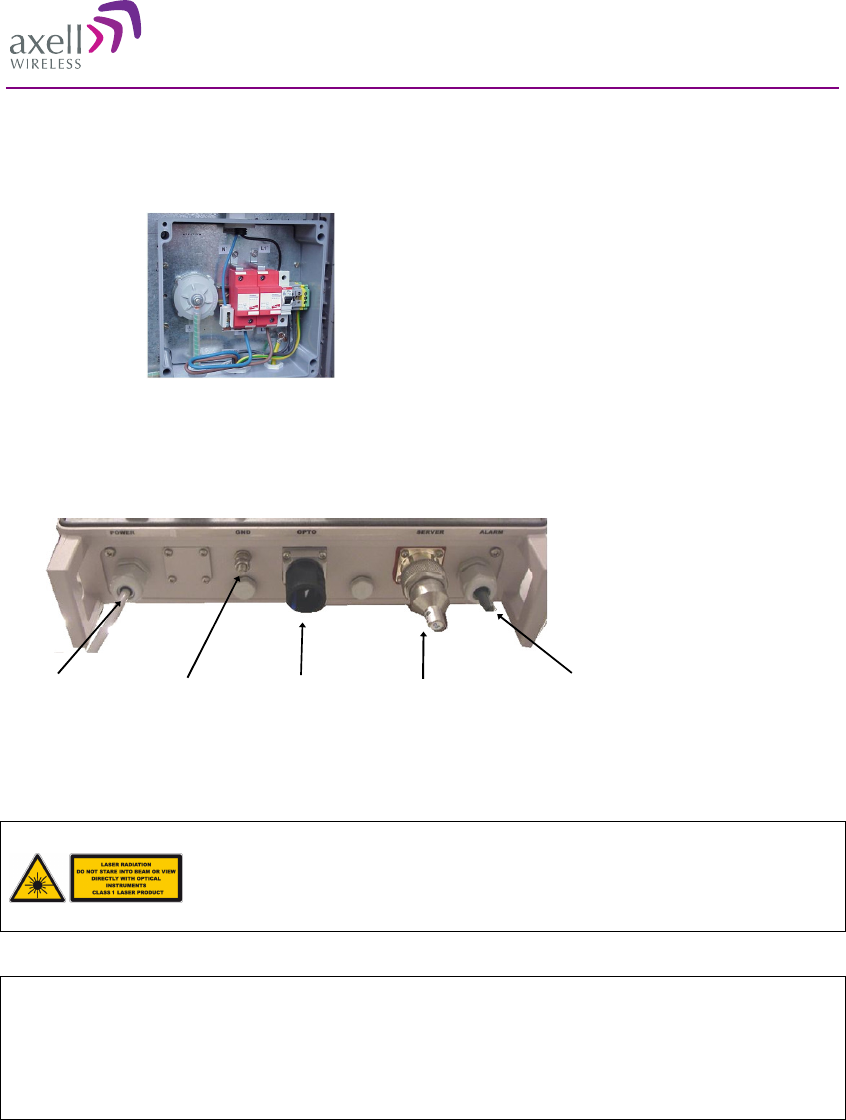
MBF, Multi Band Repeater
PRODUCT DESCRIPTION AND USER'S MANUAL
© Axell Wireless Ltd A 200 93 00, rev E 72 (105)
Wireless. Coaxial lightning protection is normally one of these three types: Gas capsule,
High-pass and Bandpass.
There also need to be a protective device installed on the power supply cord.
Protective device installed in connection with the power supply
5.2.5 Attach Cabling
Power Fiber inputGround Server
antenna
External
alarms
5.2.5.1
Attach Fiber Cable
This product is equipped with class 1 lasers, as per definition in EN 60825-1.
Caution
Un-terminated optical receptacles may
emit laser radiation. Do not stare into beam
or view with optical instruments.
Note!
Angled connectors, APC, need to be used throughout the whole link between
the OMU and the repeater. The angle needs to be 8 degrees.
Also the ODF connections need to be APC type.
The fibre must be monomode type.
Select fibre Recommended fibre cable is single mode 9/125.
Connect the fibre The casing of the repeater is equipped with an inlet. The inlet is designed to go with a
corrugated hose, which is included in the shipment.
The hose, together with the rubber seal meet the protection standard IP65.
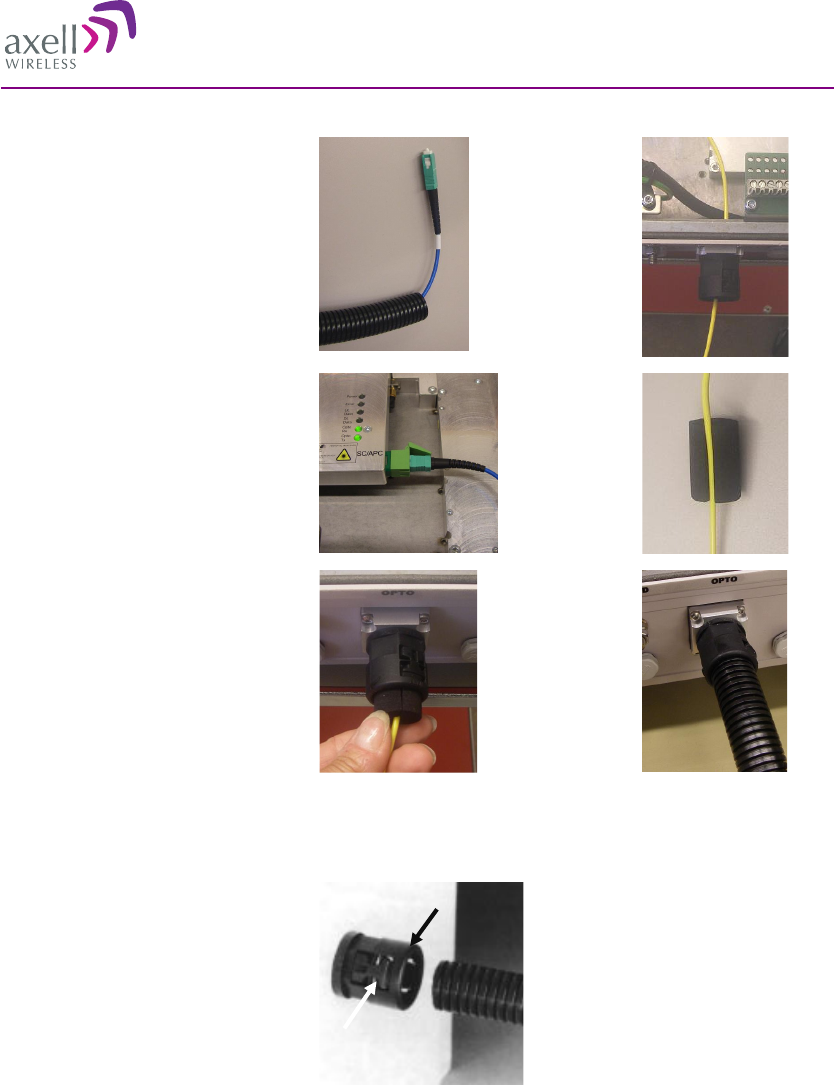
MBF, Multi Band Repeater
PRODUCT DESCRIPTION AND USER'S MANUAL
© Axell Wireless Ltd A 200 93 00, rev E 73 (105)
1. Run the
fibre through
the hose
2. Run the
fibre through
the inlet in
the repeater
3. Connect the
fibre to the
Fibre Optic
Converter
inside the
repeater
4. Place the
fibre in the
rubber seal
5. Adjust the
fibre length
inside the
repeater and
insert the seal
into the inlet
6. Attach the
hose to the
inlet
Note! Make sure the fibre is not bent too sharply inside the repeater. There is room
under the optic module to allow for some slack of the fibre.
Note! To
insert and
extract the
hose from the
inlet press the
side levers.
Make necessary
measurements
Make necessary measurements to ensure a correct installation.
When the cable has been installed, the quality of the optical path should be checked
for optical path loss and magnitude and location of any reflections. This can be done
with an Optical Time Domain Reflectometer (OTDR). The total return loss should be
> 45 dB.
Optical reflections can degrade the noise and linearity of a fibre optic link. In
particular, reflections that reach the laser can be a problem. Keep all discrete
reflections to > 60 dB. The SC/APC connectors are polished to a return loss >60 dB.
Attach the fibre
to the fibre optic
Note! Clean the fibre connector before it is connected, see instruction below.
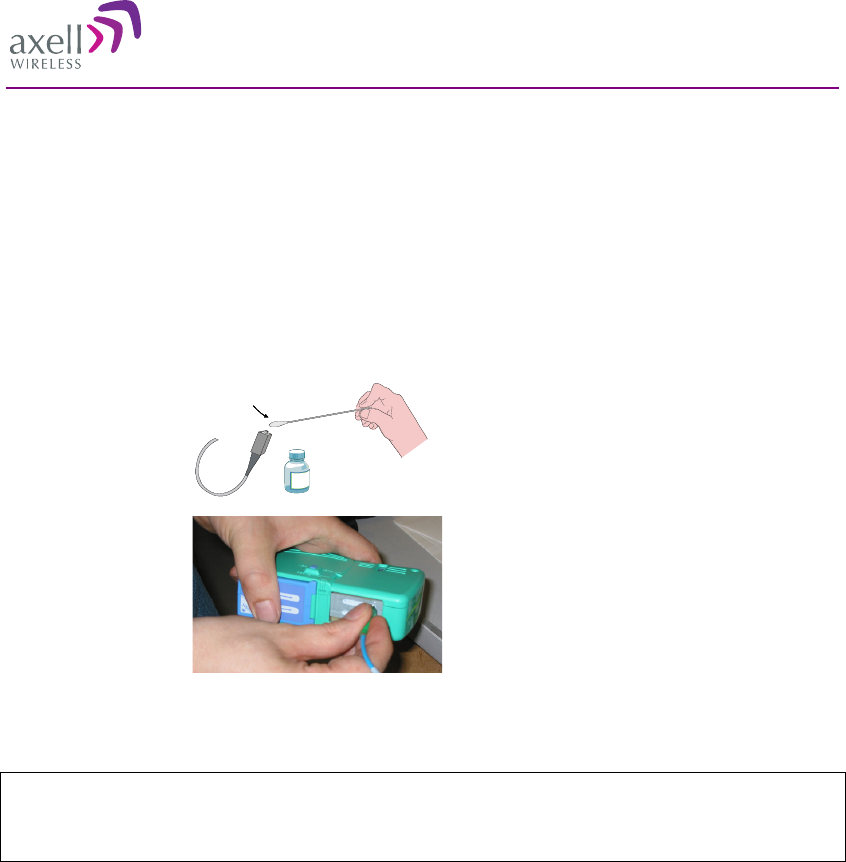
MBF, Multi Band Repeater
PRODUCT DESCRIPTION AND USER'S MANUAL
© Axell Wireless Ltd A 200 93 00, rev E 74 (105)
converter inside
the repeater.
Cleaning Optical Connectors
Optical reflections from a discontinuity such as a poor connector interface appear on
an RF spectrum analyzer trace as stable variations in the noise floor amplitude that are
periodic with RF frequency. If the reflection is bad enough, it could impact the system
performance. By far, the most common cause for a large discrete reflection is a dirty
optical connector. A bit of dust or oil from a finger can easily interfere with, or block
this light. Fortunately, it is very easy to clean the connector.
Be sure to use the correct procedure for the given connector. When disconnected, cap
the FC/APC connector to keep it clean and prevent scratching the tip of the ferrule.
Alternative 1
Swipe the tip of the ferule 2-3 times with a
cotton swab soaked in alcohol. Let it air dry.
Alternative 2
Use a product specially designed for the
purpose.
5.2.6 Supply Power to the Repeater
Caution!
The antenna cables must be connected to the repeater before mains power is switched on. Alternatively the
antenna connections on the repeater can be terminated with 50ohm termination plugs.
Note! The repeater can be fed by 230 VAC 50 Hz, 115 VAC 60 Hz or -48 VDC.
Ensure that the right voltage is used.
Connect the
repeater to the
power supply
Power is connected to the repeater via a plinth inside the repeater.
The strain relief fitting is a Pg 13.5 suitable for a 6-12 mm cable diameter.
230 VAC Power Supply
Connect the power cable to the plinth with the phase linked to the brown cable,
neutral linked to the blue and ground to the yellow/green. See illustration below.
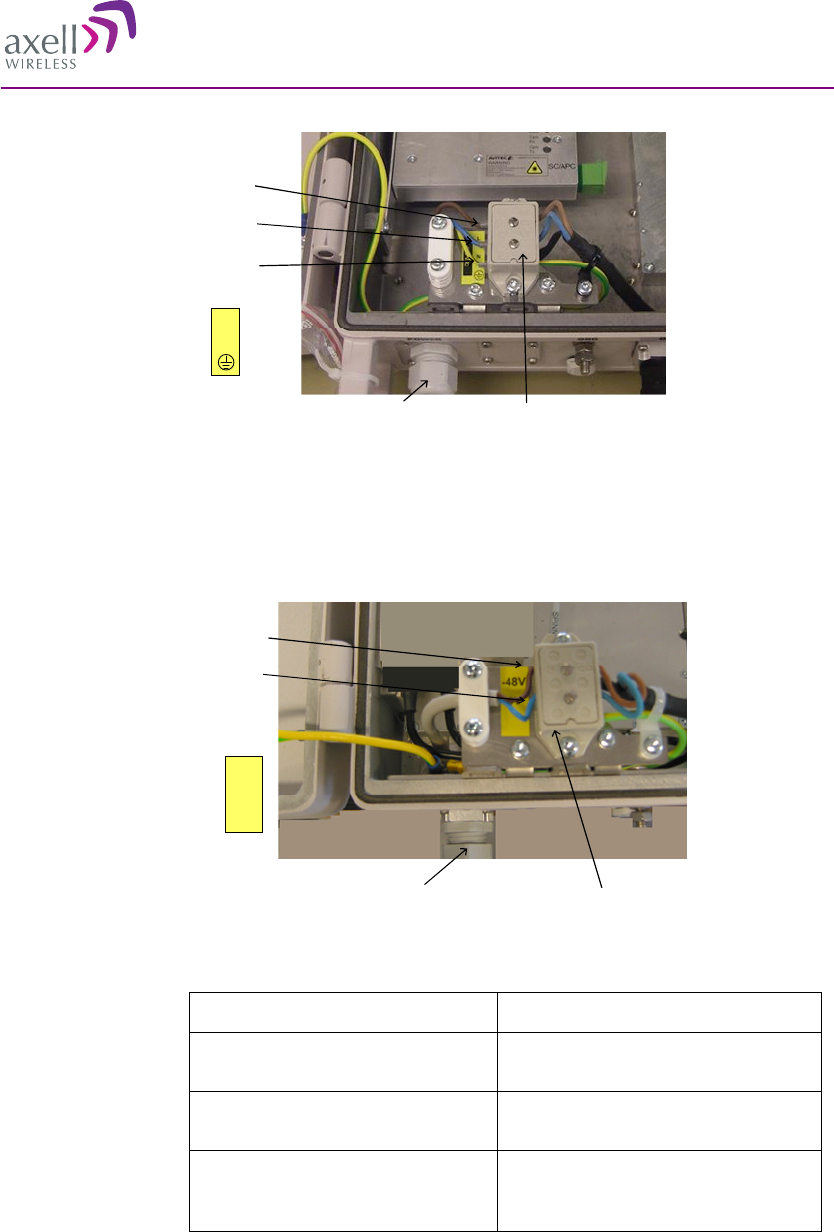
MBF, Multi Band Repeater
PRODUCT DESCRIPTION AND USER'S MANUAL
© Axell Wireless Ltd A 200 93 00, rev E 75 (105)
Connection Plinth
Phase
/Live
Neutral
Ground
L
N
Strain Relief Fitting
-48 VDC Power Supply
Connect the power cable to the plinth with negative (-48V) to the uppermost
connection and positive (0V) to the lower connection. Leave the middle connection
empty. See illustration below.
Connection Plinth
Negative
Positive
-48V
0V
Strain Relief Fitting
Recommended cable areas for 48VDC
Distance Cable Area
0 - 10 meters between repeater and
power supply
2,5 mm²
10 – 50 meters between repeater and
power supply
4 mm²
Over 50 meters between repeater and
power supply
Recommendation is to reconfigure the
installation, or to make special
arrangements to increase cable area
Requirements on 48 V DC power supply
The 48VDC power supply must comply with SELV requirements, as defined in
EN60950, which implies double isolation. The output power needs to be 48VDC
+25%/-15%. The maximum input current is 8A.
Turn Off level
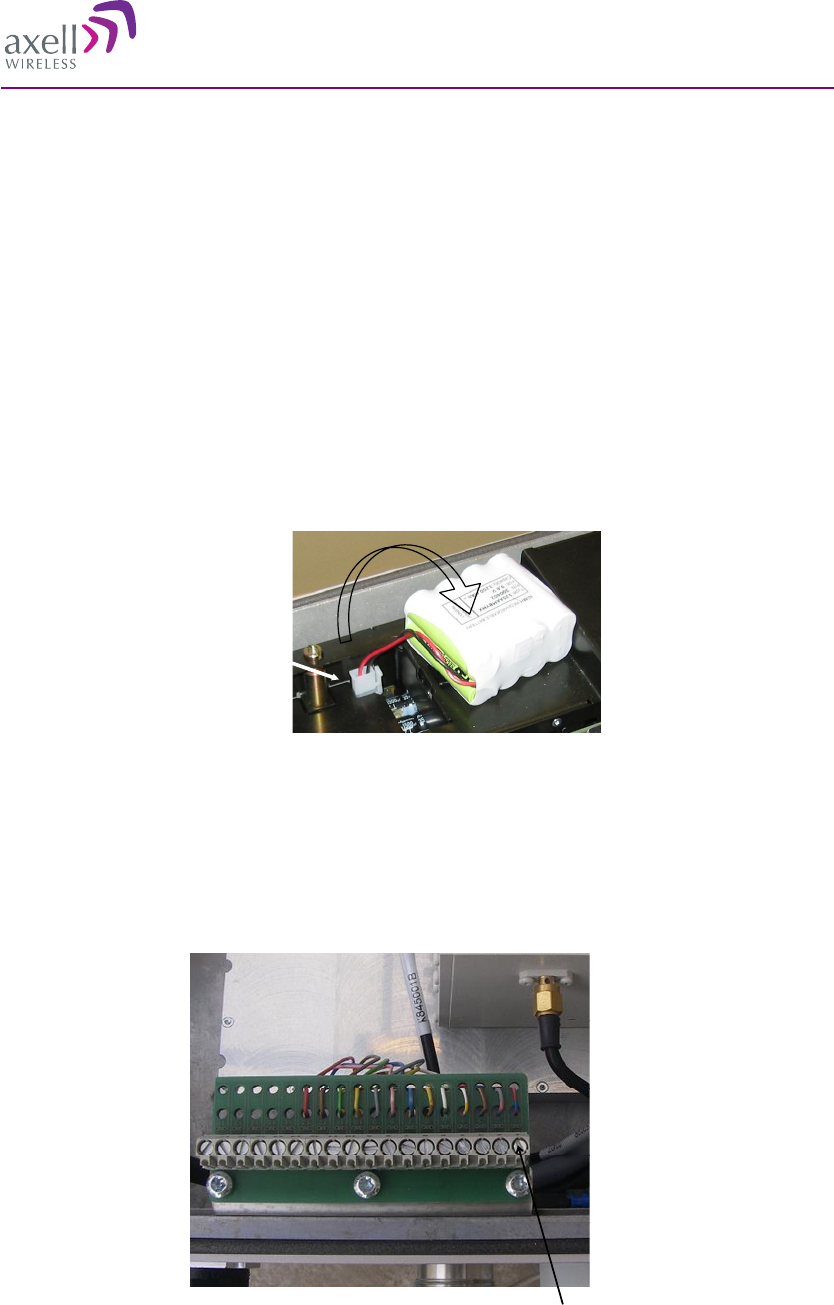
MBF, Multi Band Repeater
PRODUCT DESCRIPTION AND USER'S MANUAL
© Axell Wireless Ltd A 200 93 00, rev E 76 (105)
The -48VDC version of the power supply is designed to turn off if the supply
voltage falls below -36V (±1V), not to drain the feeding battery. It will turn on again
as the supply voltage reaches -43V (± 1V).
Back-up battery
Backup Battery
There is a back-up battery installed in connection with the power supply. If there is a
power failure the battery will supply enough power to the Control Module and the
Fibre Optic Converter in the repeater to send information about the power failure.
The backup battery can be switched on and off separately. The switch is placed
adjacent to the main power switch on the power supply.
At delivery the back-up battery is connected.
The battery is replaced by lifting the battery pack out of the crate and disconnecting
the cable.
Connector
5.2.7 Connect External Alarms
Connect external
alarms
The repeater is equipped with an external alarm interface card. The connector plinth
for the external alarms is located at the bottom of the repeater.
The strain relief fitting in is a Pg 13.5 suitable for a 6-12 mm cable diameter.
Connect the alarm cords to the plinth according to the pin layout below (in the
standard version pins 14 – 18 are not used).
1 External alarm 1A
2 External alarm 1B
3 External alarm 2A
4 External alarm 2B
5 External alarm 3A
6 External alarm 3B
7 External alarm 4A
8 External alarm 4B
9 Alarm +15V
10 Alarm 0V
11 Relay Output 1A
12 Relay Output 1B
13 GND
14 NC
15 NC
16 NC
17 NC
18 NC
Pin # Signal
Pin 1

MBF, Multi Band Repeater
PRODUCT DESCRIPTION AND USER'S MANUAL
© Axell Wireless Ltd A 200 93 00, rev E 77 (105)
External Alarm
Four external alarm sources can be connected to the repeater. These alarms operate on
a voltage between 12 and 24VDC. The presence or absence of this voltage will trigger
the alarm depending on how the alarm polarity has been configured.
The alarms can be configured active-low or active-high, so that the alarm is given
either in the presence or absence of applied power. Active high means that an applied
voltage of between 12 and 24 V will cause the external alarm indicator to turn red.
Active low means that when there is no voltage the alarm indicator will turn red. The
repeater can supply +15 VDC to an external alarm source through pin 9 and 10. The
maximum allowed load is 100mA.
The repeater contains a relay (pin 11 and 12) that can be connected to an external
device to indicate an alarm. The relay can be configured to trigger on any number of
internal and external alarms. The maximum current that can be supplied is 100mA.
5.2.8 Close Repeater
Close repeater Close lid and lock repeater, or continue with the next section: Start-up the Repeater.
Note! The two screws must be fully tightened. Failure to do so may affect the IP65
compliancy and therefore any warranty.
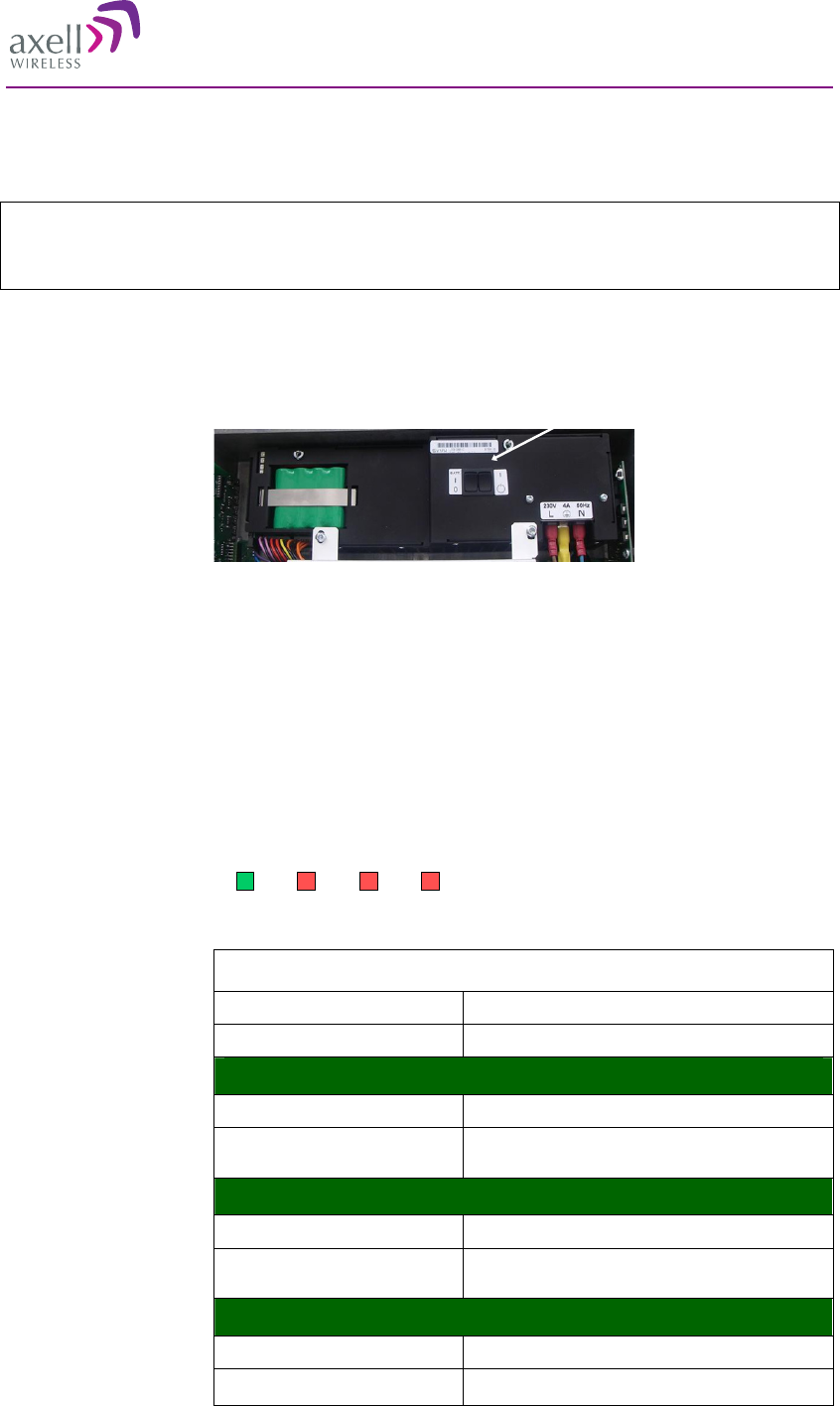
MBF, Multi Band Repeater
PRODUCT DESCRIPTION AND USER'S MANUAL
© Axell Wireless Ltd A 200 93 00, rev E 78 (105)
5.3 Start-up the Repeater
Caution!
Make sure the antenna cables or 50 ohm terminations are connected to the repeater’s antenna connectors
before the repeater is turned on.
Switch the repeater
on
Switch the repeater on by using the power switches on the power supply.
Note! See caution above!
Power Switch
There are two switches. One is for the battery and one is for the power
The rightmost switch is the one that switches the main power. The leftmost is for
turning the battery on/off.
Note! The power switch has two positions; “on” and “stand by”. In the stand by
position the repeater is still connected to the power supply but not operational.
Note! On repeaters mounted in an extended box with two power supplies, both
power supplies needs to be switched on.
Check power supply
LEDs
Check the LEDs on the Power unit to ensure that normal operation conditions
have been attained.
Input
Power
+6V +15V +28V
LED 1, Input Power, Green
Slow flash Power supply unit operating on AC or DC
OFF Power supply unit not operating
LED 2, +6V, Red
Slow flash (every 10 seconds) +6V power supply operating
Quick flash +6V power supply not operating or operating with
malfunction
LED 3, +15V, Red
Slow flash (every 10 seconds) +15V power supply operating
Quick flash +15V power supply not operating or operating with
malfunction
LED 4, +28V, Red
Slow flash (every 10 seconds) +28V power supply operating
Quick flash +28V power supply not operating or operating
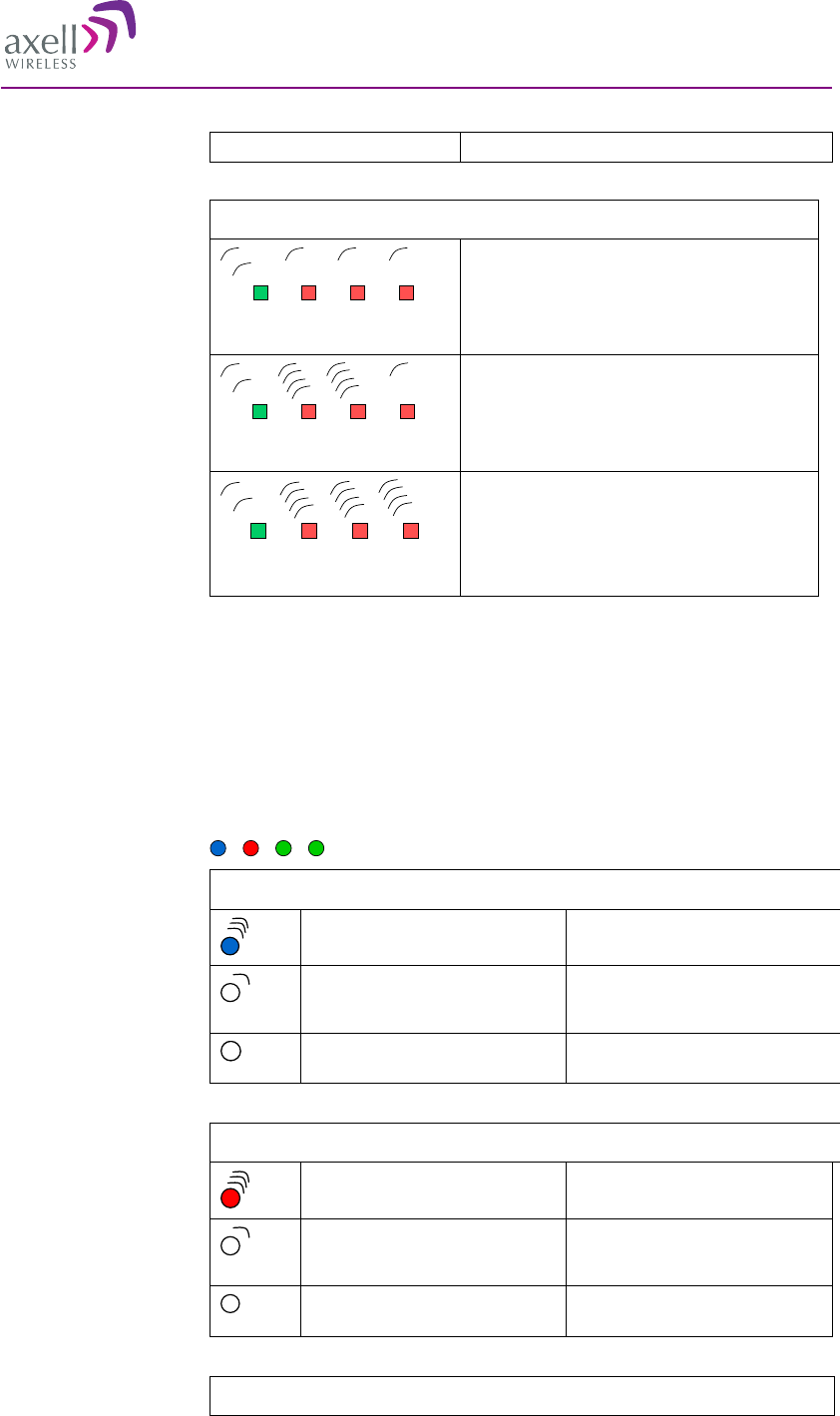
MBF, Multi Band Repeater
PRODUCT DESCRIPTION AND USER'S MANUAL
© Axell Wireless Ltd A 200 93 00, rev E 79 (105)
with malfunction
Examples
Input
Power
+6V +15V +28V
LED 1 is flashing slowly, LED 2 – 4 are flashing slowly
(once every 10 seconds)
=> power supply unit is operating without problem
Input
Power
+6V +15V +28V
LED 1 is flashing slowly, one or two of the red LEDs
are flashing quickly
=> Input power is operating but there is a problem with
some of the other voltages
Input
Power
+6V +15V +28V
LED 1 is flashing slowly, all of the red LEDs are
flashing quickly
=> Input power is out and unit is operating on backup
battery
Check Control
Module LEDs
The Control Module has four LEDs which give information regarding the status
of the repeater and if someone is logged on to the repeater.
If the repeater is configured as a system slave the two LEDs MDM Power and
MDM Status do not fill any function and can be disregarded.
LOGIN
STATUS
MDM PWR
MDM STATUS
Blue LED - Login
Quick flash Control Module switched on, someone
logged in locally and/or remotely
Off
(except for a quick flash every 10th
second)
Control Module switched on, no one
logged in
Off
(permanent)
Control Module switched OFF
Red LED - Status
Quick flash Control Module switched on, one or
more errors/alarms detected
Off
(except for a quick flash every 10th
second)
Control Module switched on, status OK
Off
(permanent)
Control Module switched off
Green LED – Modem Power
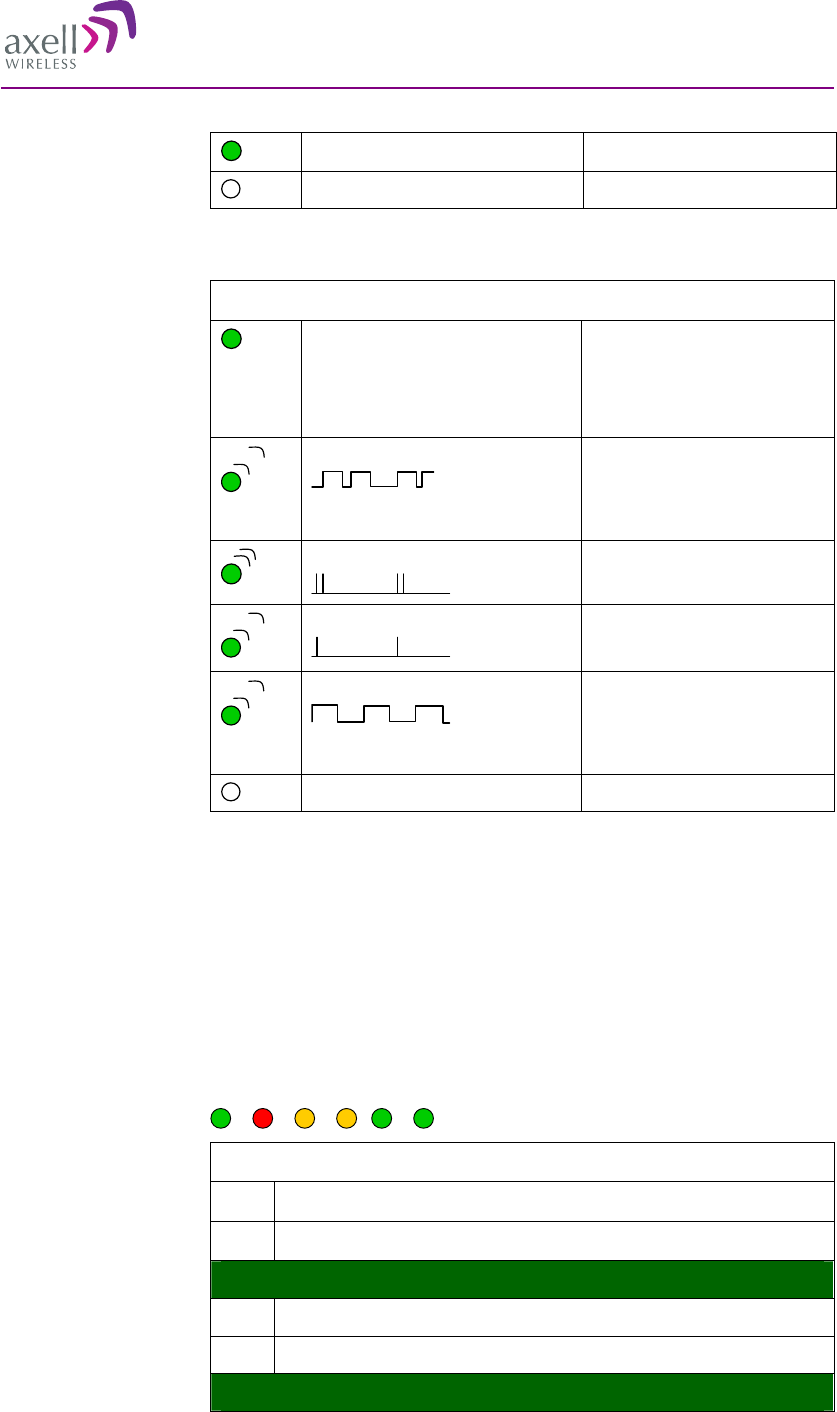
MBF, Multi Band Repeater
PRODUCT DESCRIPTION AND USER'S MANUAL
© Axell Wireless Ltd A 200 93 00, rev E 80 (105)
On Modem Power is on
Off Modem Power is off
Green LED – Modem Status
On Depending on type of call:
Voice call: Connected to remote party
Data call: Connected to remote party
or exchange of parameters while
setting up or disconnecting a call
Flashing
(irregular)
Indicates GPSR data transfer. When a
GPRS transfer is in progress the LED
goes on within 1 second after data
packets were exchanged. Flash
duration in approximately 0.5s.
75ms on/75ms off/75ms on/3s off
One or more GPRS contexts activated
75ms on/3s off
Logged to network (monitoring
control channels and user inRadio
Modulections). No call in progress
600ms on/600ms off
No SIM card inserted, or no PIN
entered, or network search in
progress, or ongoing user
authentications, or network login in
progress
Off Modem is off
Check the LEDs on
the Fibre Optic
Converter
The Fibre Optic Converter contains two optical alarm sources. These are alarms
for transmitted and received optical signal level. The levels of the received optical
signals can be monitored on-line via the RMC. This is convenient during
installation and tuning of the system.
There are 6 LEDs on the module to indicate the status.
PWR
ERR
UL Data
DL Data
Opto Rx
Opto Tx
LED 1, Power, Green
On Unit is powered on
Off Unit has no power
LED 2, Error, Red
On Error detected
Off No error
LED 3, UL Data, Yellow
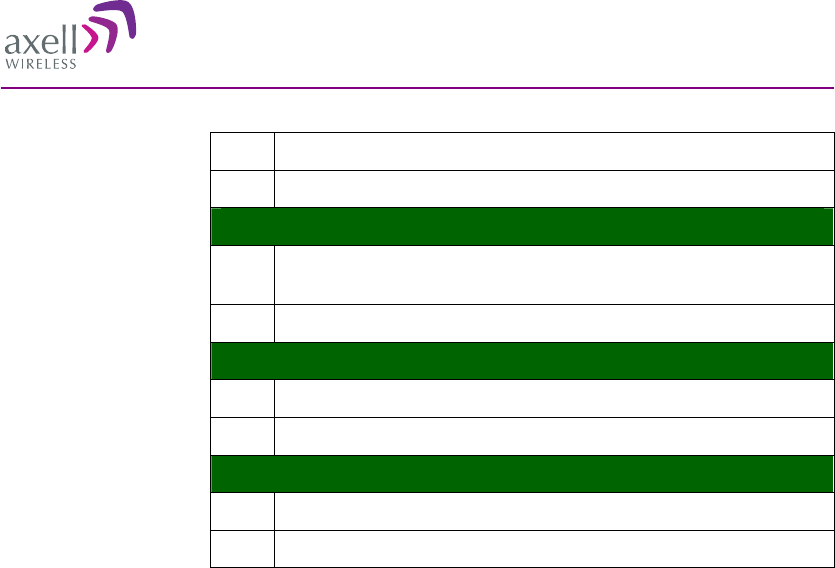
MBF, Multi Band Repeater
PRODUCT DESCRIPTION AND USER'S MANUAL
© Axell Wireless Ltd A 200 93 00, rev E 81 (105)
On Communication via the opto module is ongoing in the uplink direction
Off No communication
LED 4, DL Data, Yellow
On Communication via the opto module is ongoing in the downlink
direction
Off No communication
LED 5, Opto Rx, Green
On Input opto level OK
Off Input opto level below threshold
LED 6, Opto Tx, Green
On Output opto level OK
Off Output opto level below threshold
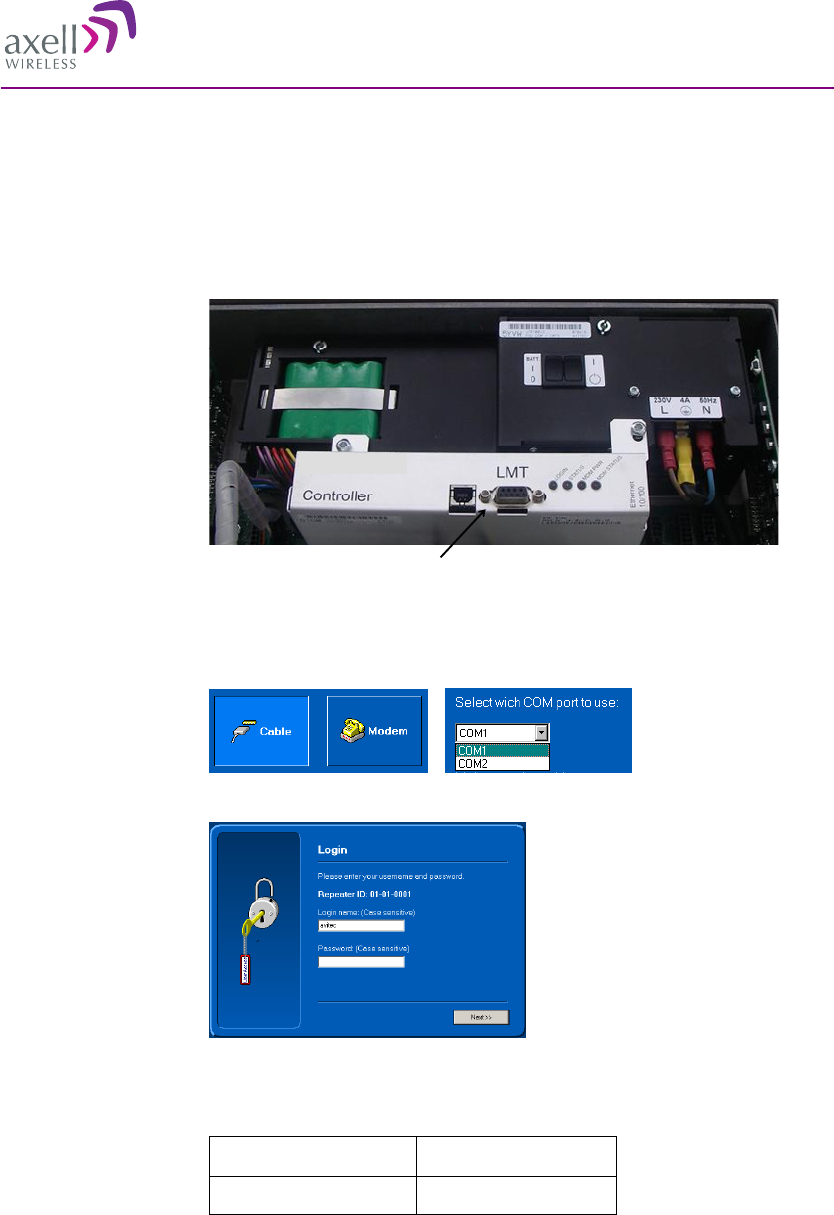
MBF, Multi Band Repeater
PRODUCT DESCRIPTION AND USER'S MANUAL
© Axell Wireless Ltd A 200 93 00, rev E 82 (105)
5.4 Initiate Local Communication
5.4.1 RMC Communication
Connect to the LMT
port
Connect the computer to the LMT port via a DB9 male connector with serial RS232
interface.
LMT Port
The communication parameters are set automatically by the RMC
Select “Cable”
connection and
communication port
Enter user name and
password
Several users at a time can be logged on to a Repeater, for instance one locally via
the RS232 interface and one remotely via modem or Ethernet.
There is one default user name and password defined for the repeater..
User Name Password
avitec AvitecPasswd
Note! Both the user name and the password are case sensitive.
Note! Do not use the number pad when entering numbers.
Note! Failed login attempts are logged. Default maximum number is 8. It is
decremented by one every hour, which means that it takes one hour after the last
failed attempt before a new try can be made.
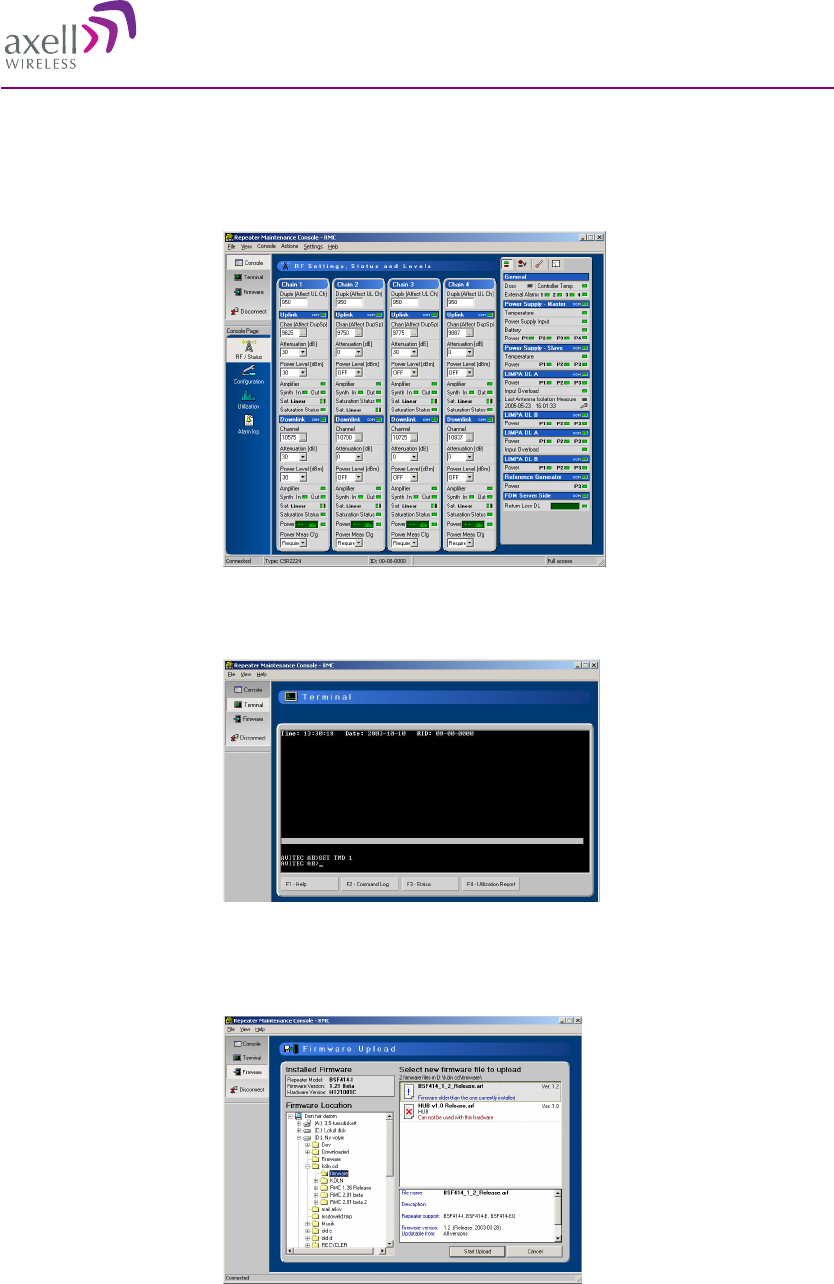
MBF, Multi Band Repeater
PRODUCT DESCRIPTION AND USER'S MANUAL
© Axell Wireless Ltd A 200 93 00, rev E 83 (105)
5.4.2 RMC Work Views
There are three different work views to choose from in the RMC
Console mode
The console mode displays a large number of repeater parameters and contains
a number of console pages. It adjusts its user interface to adapt to the features of
the connected repeater.
Terminal mode
The terminal mode is used for communication with the repeater using its native
command line interface. This interface follows the VT100 standard. For some
special actions and error tracing, this mode gives an enhanced availability of the
repeater.
Firmware mode
The firmware mode is used for monitoring the currently installed software and
for uploading new software to the repeater.
Note! The description in this manual is based on using the Consol work view.
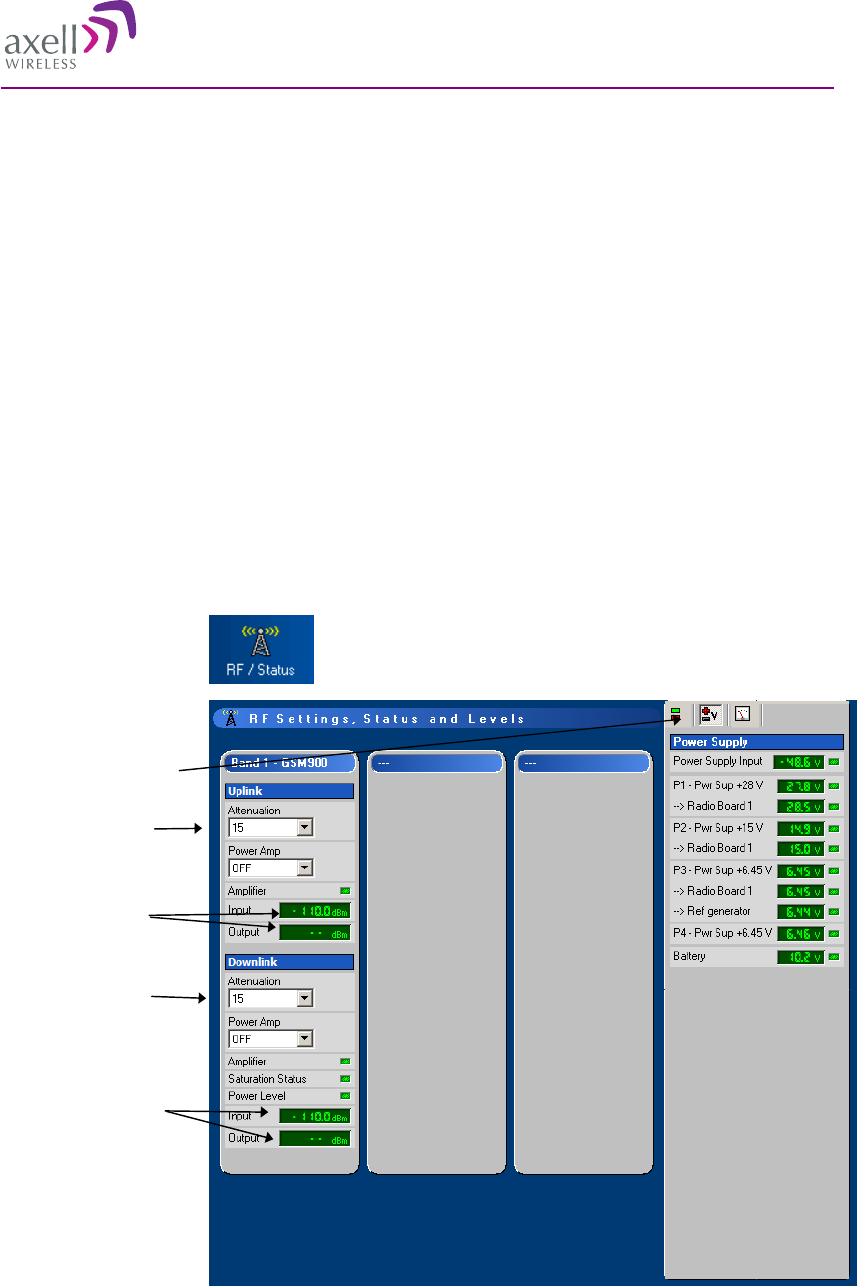
MBF, Multi Band Repeater
PRODUCT DESCRIPTION AND USER'S MANUAL
© Axell Wireless Ltd A 200 93 00, rev E 84 (105)
5.5 Install the OMU and Set up OMU-Repeater
System
For information about how to install the OMU which will supply the input signal to the repeater please refer
to the OMU Manual. In the OMU Manual there is also information about how to calculate link budgets for a
whole OMU-Repeater system.
5.6 Configure the Repeater
The following pages will guide you through the configuration of a repeater utilizing the Repeater
Maintenance Console (RMC) software. Configuration of a repeater is made partially on site and partially
remotely through the AEM. At site the RF parameters are set and verified, the repeater is given a name (a tag)
and the remote communication is set and verified. All other configuration can, and should be made from the
AEM.
5.6.1 Set up RF Configuration
Configuration of the repeater amplification can be made locally. If the repeater is connected to an OMU the
configuration can also be made via this OMU. See OMU User’s Manual.
Note! This is an example from a single band repeater. Other repeaters will have similar features.
Ensure online
communication with
the repeater
Select “RF/Status” window
Alarms and general
information
Uplink attenuation
Uplink input and
output power
Downlink
attenuation
Downlink input and
output power
This shows a single band repeater with no RF signals
Check that the fibre
is OK
Make sure there are no alarms relating to the fibre.
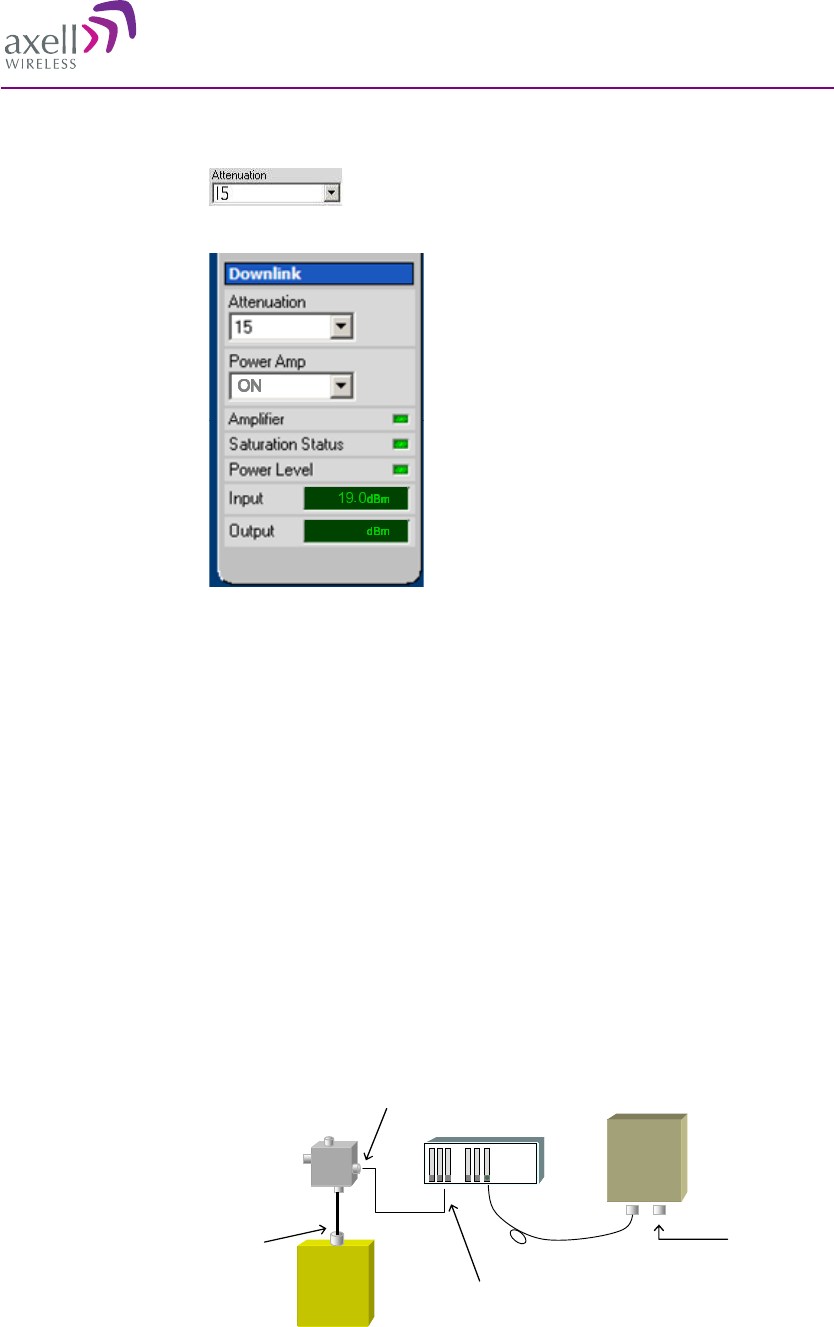
MBF, Multi Band Repeater
PRODUCT DESCRIPTION AND USER'S MANUAL
© Axell Wireless Ltd A 200 93 00, rev E 85 (105)
Set attenuation level
in uplink and
downlink to a
maximum
Choose the maximum attenuation value from the drop down menu.
Configure the
downlink
-
33
Lower the attenuation level step by step until the desired output power level is
reached. In this example +33 dBm. Zero attenuation is the same as maximum gain.
Note! Please also consult the OMU User’s Manual.
Initiate a fibre loss
elimination
This is done from the OMU by sending a pilot tone to the repeater and calculating the
loss in the fibre link. This loss is compensated for automatically. The system will
behave as if there is no loss at all in the fibre link.
Configure the uplink
In the uplink direction the attenuation needs to be set based on a measurement of a
known signal which is transmitted through the repeater and the OMU as well as the
fibre. There are two ways of performing this measurement.
Alternative 1
Use a signal generator to insert a signal of approximately -70dBm into the repeater’s
server antenna port. Measure the signal level on the BTS or on the coupler and adjust
the attenuation so that the total gain in the uplink is close to 0dB. (At 0dB gain the
signal level at the coupler should be -40dBm and on the BTS -70dBm in this
example.)
Repeater
Signal
Generator
Fiber
-70dBm
BTS
-30dB
Coupler
OMU
-40dBm
-70dBm
Alternative 2: Use the RMC to
measure the uplink at the OMU
Alternative 2
Use a signal generator to insert a signal of approximately -70dBm into the repeater’s

MBF, Multi Band Repeater
PRODUCT DESCRIPTION AND USER'S MANUAL
© Axell Wireless Ltd A 200 93 00, rev E 86 (105)
server antenna port. Log into the OMU and monitor the uplink via the RMC. This
measurement is not as accurate as alternative 1.
Note! If several repeaters are connected to the same OMU the total gain in each chain
should be slightly lower than 0dB not to insert too much noise into the BTS.
Note! For in-depth instructions for commissioning of an OMU-Repeater system please
contact your Axell Wireless representative.
5.6.2 Set Repeater Name (TAG)
The TAG can be chosen freely to give the repeater a name that is linked to the location, the site name, etc.
The TAG may contain up to 30 characters including spaces.
Select
“Configuration” and
“Product”
Insert the repeater’s
name (TAG) in this
box.
Note! Do not assign an ID. The AEM will do this automatically when the repeater
is integrated in the AEM.
5.6.3 Configure Alarms
See section 4.4.7Alarm Configuration.
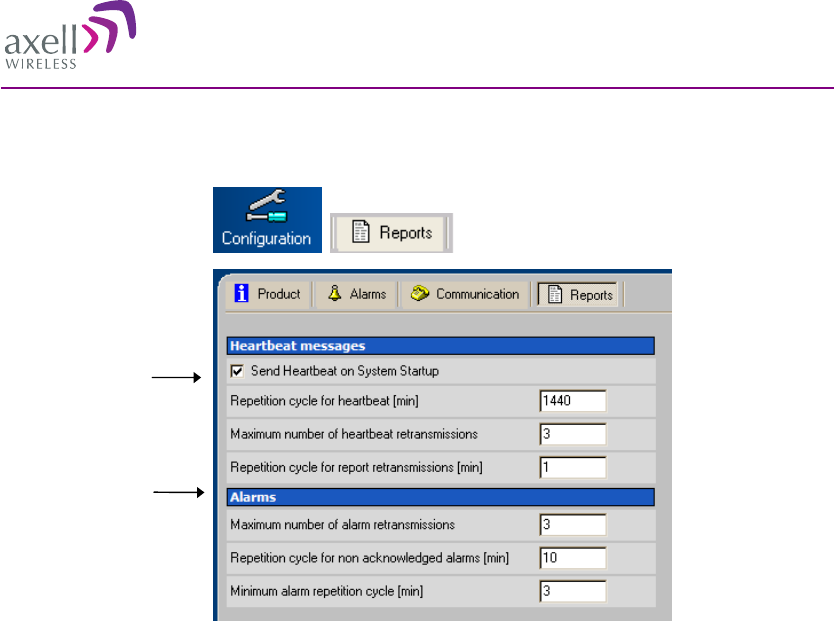
MBF, Multi Band Repeater
PRODUCT DESCRIPTION AND USER'S MANUAL
© Axell Wireless Ltd A 200 93 00, rev E 87 (105)
5.6.4 Configure Reports
Select
“Configuration” and
“Reports”
Set report data
Heartbeat
Alarms
Note! For repeaters that are to be used as slaves in an OMU-Repeater system all report configurations are
done from the OMU.
5.7 Set Up Remote Communication
Note! If the repeater is fibre fed and is set up as a slave- this section is not relevant since the remote
communication is handled by the node master – in most cases an OMU.
The repeaters can be configured with a wireless modem, a PSTN modem or Ethernet for the remote
communication.
5.7.1 Communication via Modem
The Control Module is responsible for enabling the power to the modem, unlocking the SIM-card, using the
configured PIN-code and making sure the modem is logged in to the network correctly. Depending on
network configuration and modem usage, the modem might require different modem initialization strings to
work properly. This modem initialization string is set and verified during repeater setup.
5.7.1.1
Modem Initialization
After a power failure, or upon user request, the Control Module performs a full initialization of the modem.
This consists of three steps:
If the SIM-card in the modem has the PIN code enabled, the Control Module unlocks the PIN code. In
case wrong PIN-code is configured, the Control Module will not try to unlock the SIM again until the
PIN-code is changed. This avoids the SIM card being locked by a Control Module repeatedly trying to
unlock the SIM with the wrong PIN code.
Once the SIM is unlocked, the Control Module waits for the SIM to log in to the network. Depending on
signal quality and network configuration this might take a while. The Control Module will wait a
configurable number of seconds (default 50 seconds) for the modem to login to the network. In case no
network is found, a modem power cycle will be initiated.
When the modem is successfully logged in to the network, the Control Module configures the modem with
the modem initialization string as configured when setting up the remote configuration. The modem
initialization string is a network dependent string. The default string is suitable for most networks, but some
networks might require some tweaking of this string.
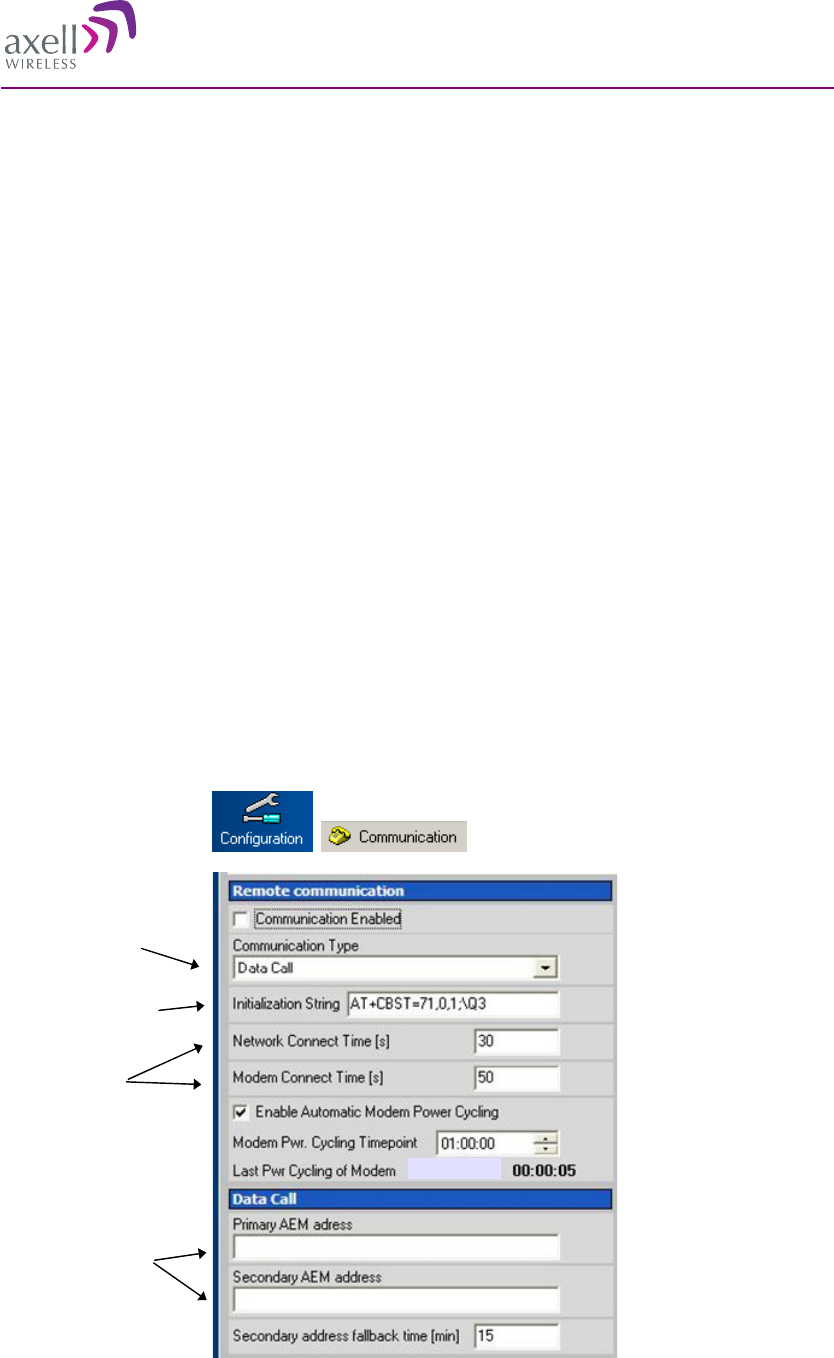
MBF, Multi Band Repeater
PRODUCT DESCRIPTION AND USER'S MANUAL
© Axell Wireless Ltd A 200 93 00, rev E 88 (105)
5.7.1.2
Monitoring Modem Connection
The Control Module constantly monitors the status of the modem connection to ensure that it is working
properly, and that the modem is logged in to the network.
In case the modem is not registered to the network, or the Control Module cannot properly communicate with
the modem, a power cycling of the modem is initiated, after which the modem will reinitialized.
5.7.1.3
Scheduled Modem Power Cycling
In addition to polling the modem to ensure the repeater online status, the Control Module can be configured
to perform an automatic power cycling on a scheduled time of the day. Power cycling the modem ensures the
latest network configuration for the modem, such as the HLR Update Interval etc.
Note! By default, the scheduled modem power cycling is disabled.
5.7.2 Communication via Wireless Modem
There are two different ways of communication for a wireless (GSM) modem:
Using data call / modem connection.
Note! This requires the SIM-card in the modem to be configured with data service.
Using SMS to configure the repeater with simple text messages
Note! SMS functionality is not implemented in this SW release.
The Axell Element Manager always uses data call communication with the repeater, why all repeaters being
controlled by the AEM must have data service enabled on the SIM card.
Configuring the repeater to send alarms and reports via SMS it is still possible to establish data calls to the
repeater, as long as the SIM card is data service enabled.
5.7.2.1
Modem Configuration, not using GPRS
Select
“Configuration” and
“Communication”
Select Data Call
Initialization string
Connect times
AEM addressed are
set via the AEM
2004-01-01
Select Data Call
Set the modem initialization string. This string differs between networks. Primary
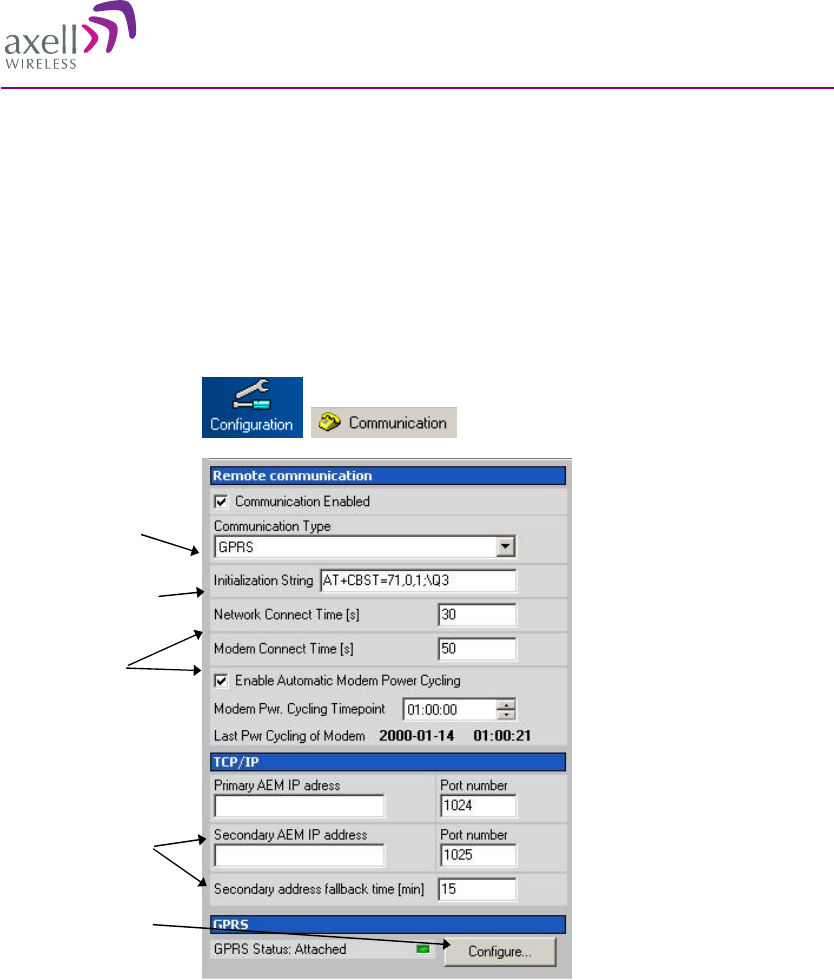
MBF, Multi Band Repeater
PRODUCT DESCRIPTION AND USER'S MANUAL
© Axell Wireless Ltd A 200 93 00, rev E 89 (105)
recommendation is AT+CBST=71,0,1;\Q3. If remote communication cannot be
established try 7,0,1 or 0,0,1 or 7,0,3. For more information please refer to the
section on Troubleshooting Remote Communication.
Tick “Enable Automatic Modem Power Cycling” for the modem to be power
cycled once every 24 hours. Set the time at which the modem should be tested. This
function ensures that the repeater always is logged in to the network.
5.7.2.2
Modem Configuration, using GPRS
Select
“Configuration” and
“Communication”
Select GPRS
Initialization string
Connect times
AEM addressed are
set via the AEM
Configure GPRS
Select GPRS
Set the modem initialization string. This string differs between networks. Primary
recommendation is AT+CBST=71,0,1;\Q3
Tick “Enable Automatic Modem Power Cycling” for the modem to be power cycled
once every 24 hours. Set the time at which the modem should be tested. This
function ensures that the repeater always is logged in to the network.
Click on Configure…
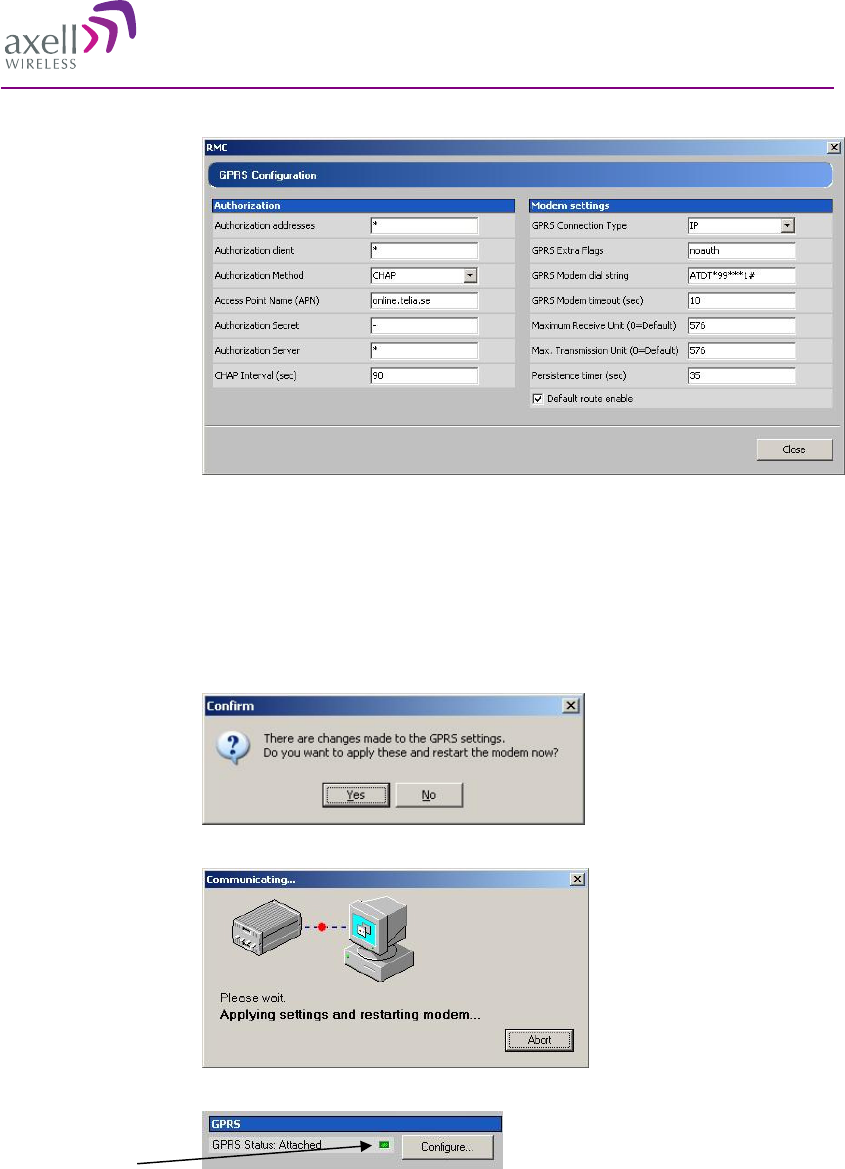
MBF, Multi Band Repeater
PRODUCT DESCRIPTION AND USER'S MANUAL
© Axell Wireless Ltd A 200 93 00, rev E 90 (105)
Each parameter is described in Common Commands and Attributes, section 14
GPRS Configurations.
Set the Access Point Name. It needs to be defined by the telecom operator
Set Maximum Receive Unit and maximum Transmission Unit. These differ
depending on access type: 576 for GSM, 1476 for EDGE and 1500 for WCDMA.
Click on Close, and then on “Yes”.
Wait for the modem to restart. This can take a few minutes.
When the modem settings are ready the LED turn green.
5.7.2.3
AEM Addresses
The Control Module can be configured with two different addresses (telephone numbers) to which alarms and
reports are delivered. In case the repeater cannot deliver alarms and reports to the primary address, the next
call will be made to the secondary address.
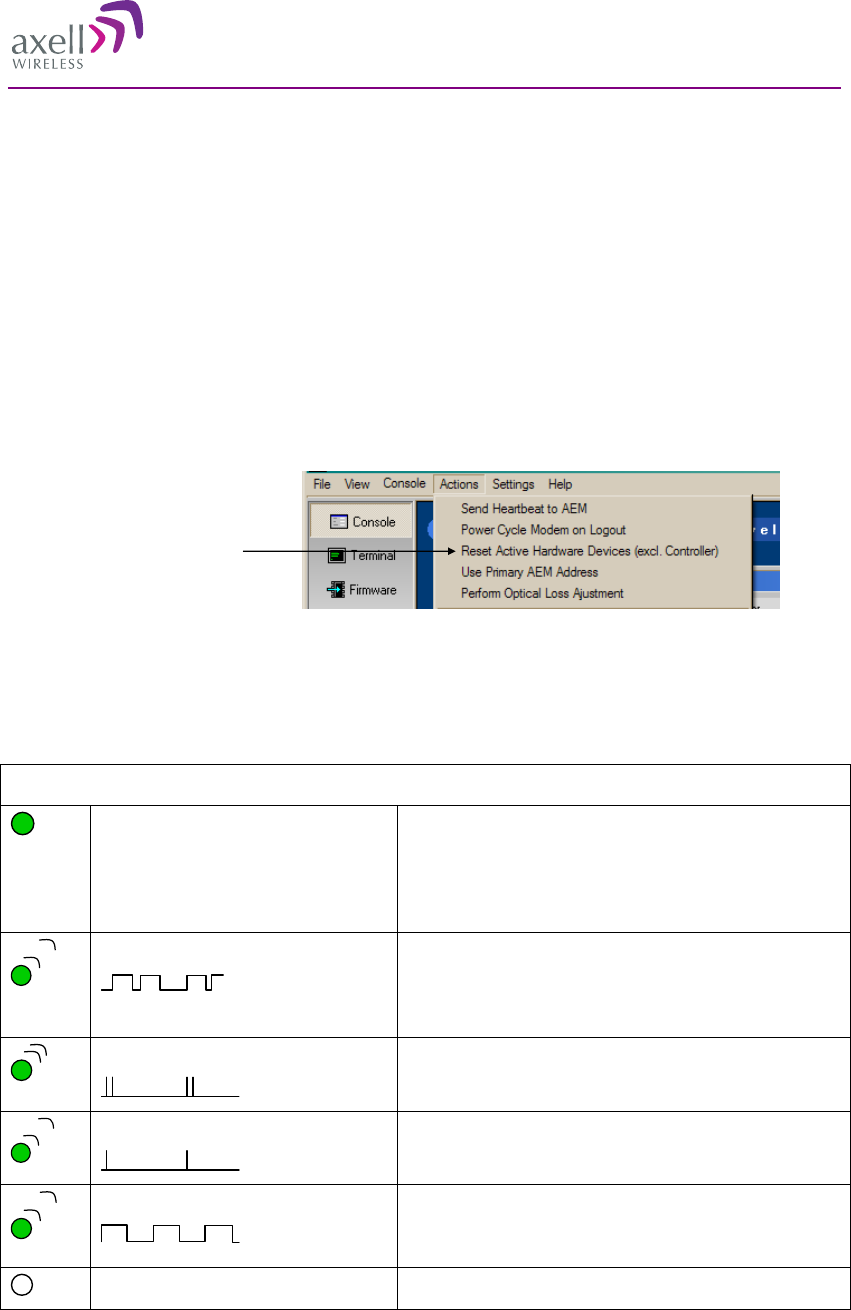
MBF, Multi Band Repeater
PRODUCT DESCRIPTION AND USER'S MANUAL
© Axell Wireless Ltd A 200 93 00, rev E 91 (105)
A fallback functionality is available, which means that the Control Module falls back to the primary address
after a configurable number of minutes. If this interval is set to 0, the fallback will not be performed. A user
can always force the Control Module to fall back to the primary address.
Note! When the repeater is integrated to the Axell Element Manager system, these addresses are set by the
AEM, why they need not be configured during site installation.
5.7.2.4
Modem Verification
When the remote configuration has been set up the communication can be verified using the modem feature
of the RMC and dialling the data number. The remote communication is verified as soon as a successful
remote login to the repeater has been performed.
However, as a first step, it is recommended to verify that the modem is initialized correctly. After configuring
the modem using the RMC, make sure to initiate a power cycling of the modem. This is done from the RMC
menu.
Click on the drop-down menu
Actions, choose Power Cycle
Modem on Logout
An immediate power cycling is initiated after which the modem is initialized and registered onto the network.
The modem is now ready for remote access.
Ensure a successful configuration by observing the modem LED as described below.
Note! This LED behaviour is valid only for GSM modems. Other modem types will be added in later
editions.
Green LED – Modem Status
On Depending on type of call:
Voice call: Connected to remote party
Data call: Connected to remote party or exchange of
parameters while setting up or disconnecting a call
Flashing
(irregular)
Indicates GPSR data transfer. When a GPRS transfer is
in progress the LED goes on within 1 second after data
packets were exchanged. Flash duration in
approximately 0.5s.
75ms on/75ms off/75ms on/3s off
One or more GPRS contexts activated
75ms on/3s off
Logged to network (monitoring control channels and
user interactions). No call in progress
600ms on/600ms off
No SIM card inserted, or no PIN entered, or network
search in progress, or ongoing user authentications, or
network login in progress
Off Modem is off
Verify the remote communication either by having someone attempting to integrate the repeater from the
Axell Element Manager, or by dialling the repeater using the Repeater Maintenance Console.
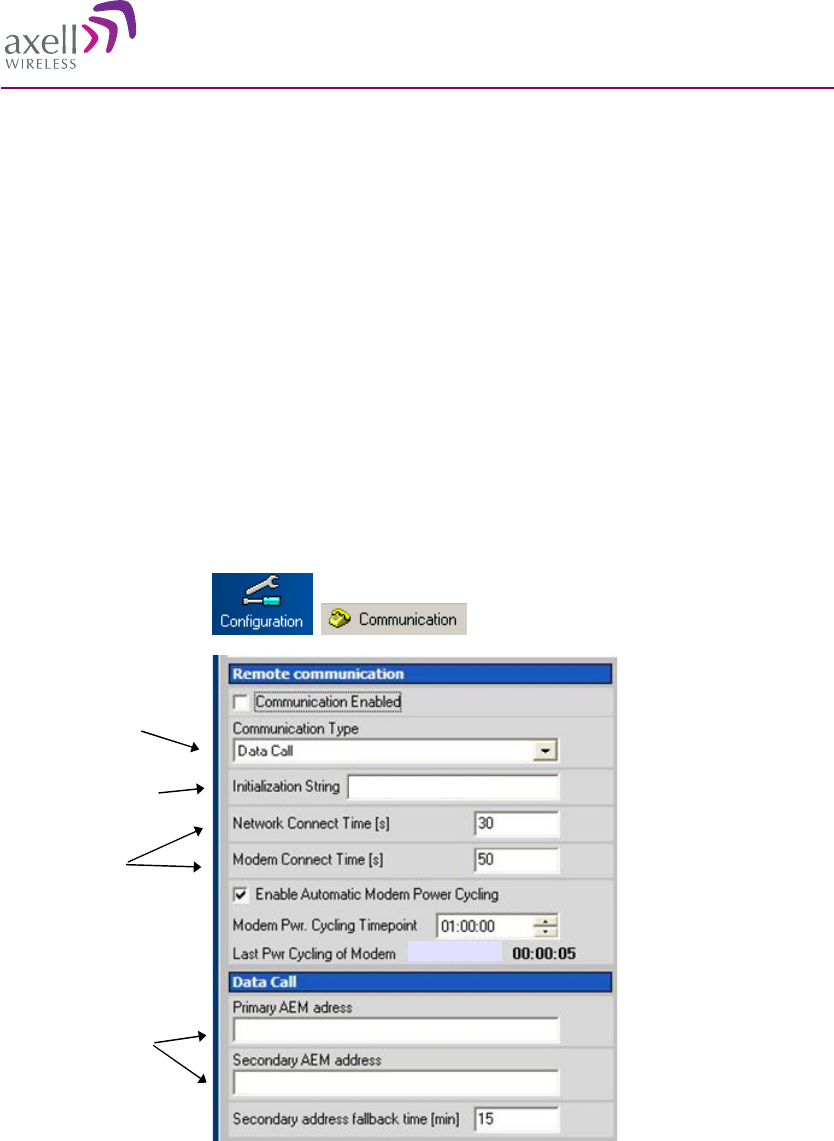
MBF, Multi Band Repeater
PRODUCT DESCRIPTION AND USER'S MANUAL
© Axell Wireless Ltd A 200 93 00, rev E 92 (105)
Note! It is very important to dial the data number of the SIM. In case the voice number is dialled, the call is
answered, but almost immediately the call will be hung up.
5.7.2.5
SIM-card Using Single Numbering Scheme
If the network is configured using Single Numbering Scheme (SNS), some special considerations apply.
The repeaters are by default configured so that networks using SNS always will have calls routed to the data
service in the modem. When dialling from within the network to a repeater having an SNS-configured SIM
will operate normally, since the call originator informs the system that the bearer is of type DATA. However,
when dialling from outside the network trying to connect to the repeater can be difficult. Depending on the
interface to the roaming network or to the PSTN network if an analogue modem is used, the bearer type can
default to voice. If the bearer is set to voice, the data service cannot be converted to DATA, and a call setup
cannot be completed.
Note! This is not a repeater related problem; the solution is to verify how the external network interfaces
handles the VOICE vs. DATA bearer type.
5.7.3 Configuration via PSTN (Fixed) Modem
Also for PSTN modems data call shall be used.
Select
“Configuration” and
“Communication”
Select Data Call
Initialization string
Connect times
AEM addressed are
set via the AEM
2004-01-01
ATE0S0=0
Tick “Enable Automatic Modem Power Cycling” for the modem to be power
cycled once every 24 hours. Set the time at which the modem should be tested. This
function ensures that the repeater always is logged in to the network.
5.7.4 Communication via TCP/IP and Ethernet
A TCP/IP communication is run over a company’s network. Therefore each company needs to define the
details regarding the configuration, IP addresses, etc. For more information please refer to Common
Commands and Attributes, section 13 Network Configurations.
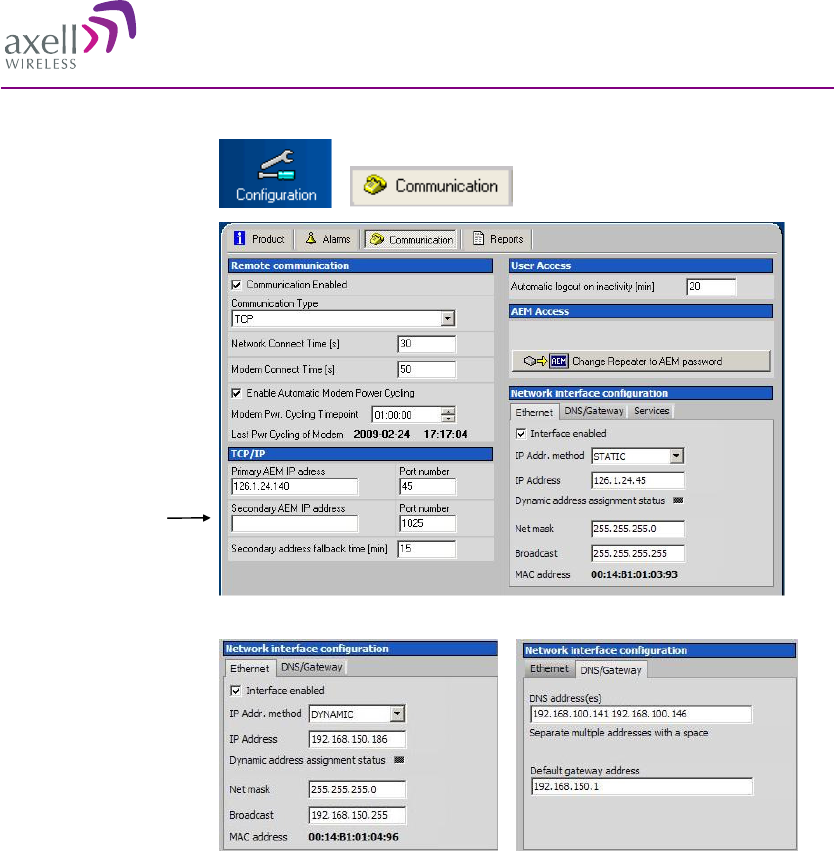
MBF, Multi Band Repeater
PRODUCT DESCRIPTION AND USER'S MANUAL
© Axell Wireless Ltd A 200 93 00, rev E 93 (105)
Select
“Configuration” and
“Communication”
Set IP address and
other relevant
information here
In these screens the
Ethernet and/or DNS
Gateway parameters
can be set
5.7.5 Troubleshooting Remote Communication
Please also refer to the document Common Command and Attributes for guidance.
Since many networks have their own “personality”, performing first time configuration of the remote
communication sometimes requires tweaking of the modem parameters.
This section describes some trouble shooting techniques if configuring the repeater for remote access fails.
The illustration below is a simplified schematic of the remote communication between a GSM modem in a
repeater and an analogue modem. The analogue modem in the computer communicates with the Interworking
Function Unit (IFU), which is the GSM network analogue network interface. The call is routed via the switch
centre over the air interface to the data call number in the SIM-card of the GSM module.
The Control Module is responsible for establishing connections with the Axell Element Manager, and to
answer incoming calls to the repeater.
As described in previous sections, the Control Module only accepts one login at a time, either via Local
Maintenance port (LMT) or modem connection. Hence, when verifying the remote access of the repeater, it is
important to log out from the repeater locally before trying to access the repeater remotely.
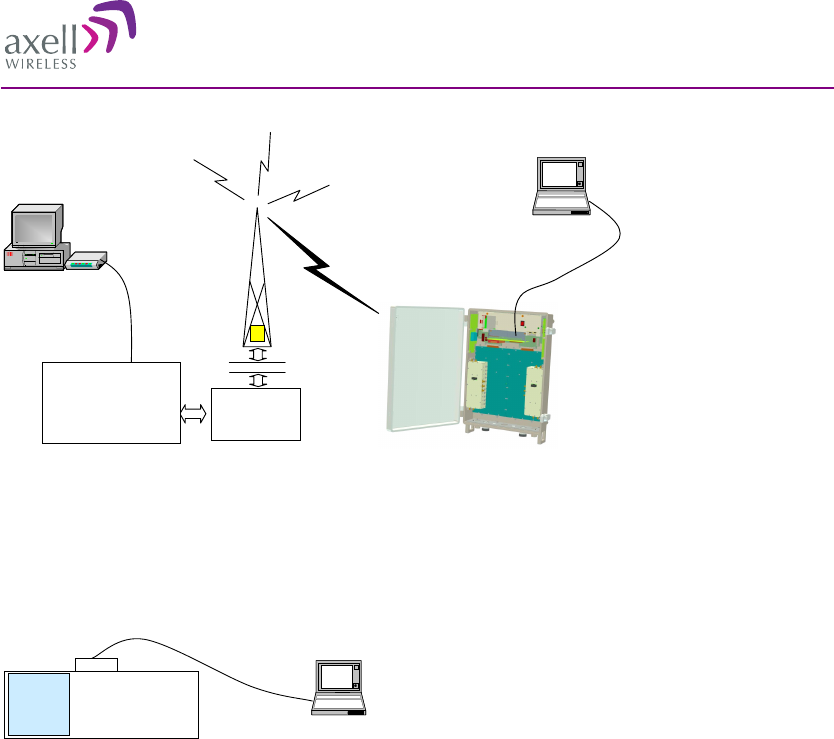
MBF, Multi Band Repeater
PRODUCT DESCRIPTION AND USER'S MANUAL
© Axell Wireless Ltd A 200 93 00, rev E 94 (105)
Radio
LinkProtocol
(RLP)
Base Station
LaptopLaptop
Control module in
Axell Wireless
Repeater
Switch
Centre
ModemModem RS232
Interworking
Function Unit
(IFU)
5.7.5.1
Direct Modem Access
To allow for advanced trouble shooting of the communications, it is possible to access the modem directly
via the Control Module from a laptop computer.
LaptopLaptop
RS232 cable
Control Module
GSM
Module
LMT Port
Log in to the repeater, either with RMC, or with a terminal emulation program, such as HyperTerminal™.
When the login is completed, select Terminal Mode, this will give access to the repeater command prompt in
the same way as with HyperTerminal.
When the repeater prompt is accessible, type in the command
ACCESS MODEM <Enter>.
When typing ACCESS MODEM, the controller will send all the characters that are typed directly out to the
modem port. All characters replied back from the modem will go directly to the LMT port and back to the
computer.
To abort an ACCESS MODEM session, press three ‘-‘ in a row (all three within one second) to come back to
the repeater command prompt.
Note! When accessing the modem port the modem might be configured with “echo off”, meaning that the
characters entered will not be echoed back to the screen. In order to enable “echo”, press Enter.
Type
ATE1 <enter>
(invisible)
The modem replies with
OK
indicating that the echo is enabled. All characters entered will now be echoed back to the terminal program.
5.7.5.2
Trace Modem
For troubleshooting purposes it is possible to trace the actual progress of initializing the modem. This trace is
useful when having problems with the modem initialization.
Go to Terminal Mode and type
TRACE MODEM
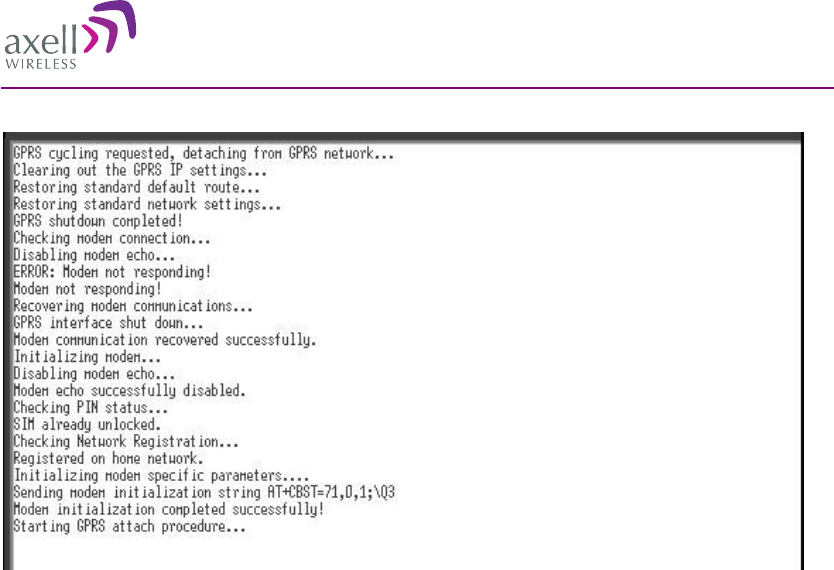
MBF, Multi Band Repeater
PRODUCT DESCRIPTION AND USER'S MANUAL
© Axell Wireless Ltd A 200 93 00, rev E 95 (105)
To end session type CTRL-Z
5.7.5.3
Manually Answering Incoming Calls
It is possible to manually answer incoming calls without involving the repeater software at all, to verify that
the remote access and the network itself works as intended. In order to verify the remote communication,
make sure to have someone stand by to dial up the repeater with a terminal emulation program, for example
HyperTerminal™.
Go in to Direct Modem Access as described earlier. When in direct access mode, ask the person standing by
to dial up the repeater.
As soon as a call is received, the text
RING
will repeatedly be displayed on the screen.
Type
ATA <enter>
This will inform the modem to answer (ATtention Answer).
When the connection is established, a connect message will be displayed including the connection speed.
Sometimes the information comes together with some miscellaneous information, such as error correction
protocols etc.
Note! Make sure the remote peer dials the Data Call number
If the voice number is dialled instead of the data number, or if the modem contains an illegal modem
initialization string, the message
OK
or
NO CARRIER
will be displayed almost immediately.
Try to change the modem initialization string. The modem initialization string mainly used to configure the
remote communication is AT+CBST.
Successful modem initialization strings used by Axell Wireless includes (most common first):
AT+CBST=71,0,1;\Q3
AT+CBST=7,0,1;\Q3
AT+CBST=0,0,1;\Q3
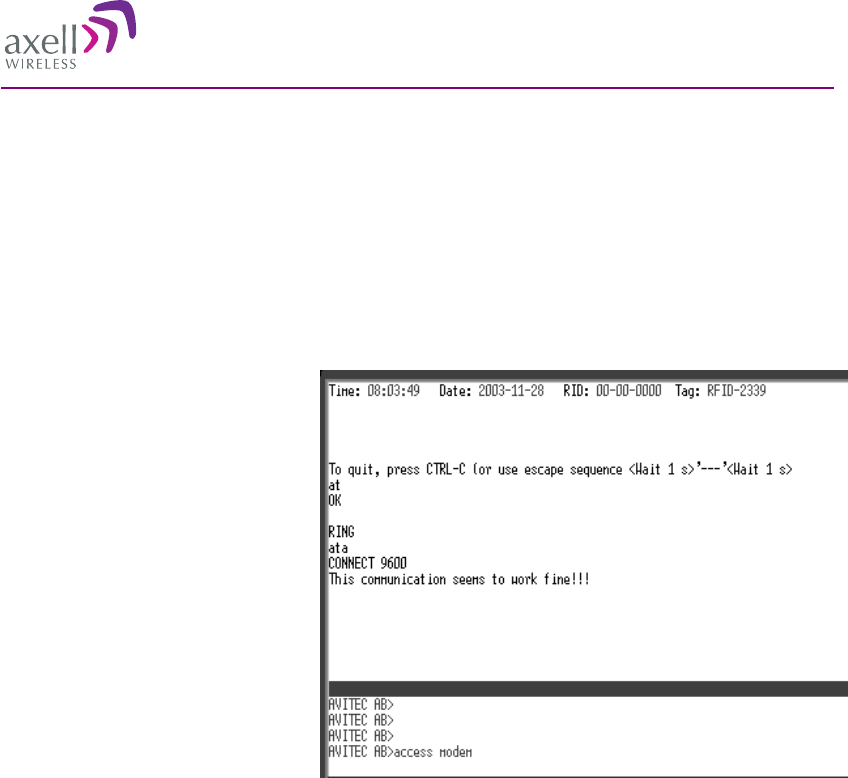
MBF, Multi Band Repeater
PRODUCT DESCRIPTION AND USER'S MANUAL
© Axell Wireless Ltd A 200 93 00, rev E 96 (105)
AT+CBST=0,0,1;\Q3
AT+CBST=7,0,3;\Q3
Once the modem initialization string is entered, try again to dial up the repeater. For details on the different
modem initialization strings, please refer to the modem’s user guide.
If the setup is successful, the connect message will be brought up;
CONNECT 9600
This means that an online connection is established to the remote peer. From now on, all characters typed on
the keyboard will end up on the remote peer’s screen. Similarly, all characters typed by the remote peer will
be displayed on the screen.
In the example, the incoming call was
successfully answered, and the remote
user entered the text message.
In order to come back to modem command mode, press +++ (three pluses) rapidly (within one second).
Receiving
OK
means that the modem is back in command mode.
Type
ATH <enter>
This terminates the connection to the remote peer. The message
NO CARRIER
will be displayed.
5.7.5.4
Common Problems
Problem 1
When enabling the remote access for the repeater, the modem fails to log in to the network.
Solution
Signal strength from the donor site is too low. The signal strength can be read directly from the modem. Go
in to Direct Modem Access as described earlier. Use the command AT+CSQ (documented below) to read out
the signal strength.
In order to have good signal quality, Axell Wireless recommends that the signal strength should be better
than -95 dBm. If signal strength is lower, try to adjust the antennas to get a better signal strength from the
donor.
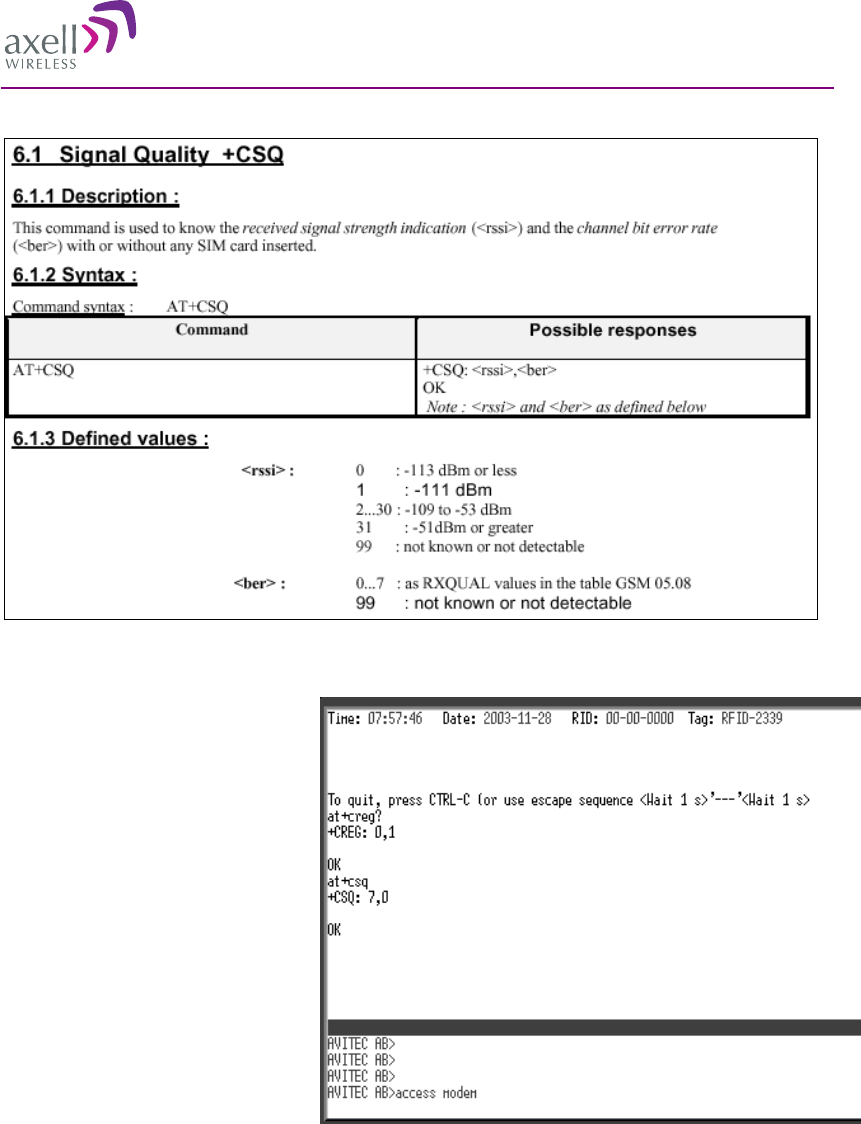
MBF, Multi Band Repeater
PRODUCT DESCRIPTION AND USER'S MANUAL
© Axell Wireless Ltd A 200 93 00, rev E 97 (105)
Documentation of +CSQ command from a modem’s manual.
In the example the reply to AT+CSQ is
0,7 meaning 7*2 dB above -113 dBm;
the modem detects a signal level of -99
dBm.
Problem 2a
Repeater is configured properly, and answers the incoming call, but when trying to dial the repeater using an
analogue mode, no modem handshaking is heard from the dialling modem.
Problem 2b
When dialling the repeater, the repeater answers the incoming call, but no connection is established, and after
a while the repeater disconnects the call.

MBF, Multi Band Repeater
PRODUCT DESCRIPTION AND USER'S MANUAL
© Axell Wireless Ltd A 200 93 00, rev E 98 (105)
Solution
The most common cause is that the number called is the voice number of the SIM, not the data number.
Therefore, make sure to dial the data number.
If data call is used, the problem probably is an illegal modem initialization string.
In order to change the modem string, go to the repeater command prompt. Try changing the modem
initialization string and log out to let the controller reinitialize the modem.
If problem remains, try a few different modem initialization strings. Axell Wireless has been successful with
the following modem initialization strings:
AT+CBST=71,0,1;\Q3
AT+CBST=7,0,1;\Q3
AT+CBST=0,0,1;\Q3
AT+CBST=0,0,1;\Q3
AT+CBST=7,0,3;\Q3
Please refer to the modem manual for detailed description of the modem initialization strings.
Problem 3
It is possible to call the repeater from another GSM mobile, but not from an analogue modem.
Solution
This problem is most likely related to the modem configuration and/or the configuration of the IFU unit. Try
to decrease the communications speed and make sure that the modem error correction is supported by the
IFU. Verify the IFU configuration to see if there are any known problems with the modem connections.
Problem 4
When dialling the repeater, or when the repeater is dialling the Element Manager, the connection is
terminated before the handshaking is completed.
Solution
When a repeater is answering an incoming modem call, or calling up the OMC to deliver an alarm or a report,
the repeater will wait a configurable number of seconds for the call to be established. If no communication is
established within this time, the call will be hung up. If this interval is set too low, the handshaking is
terminated too fast. In the RMC, verify the Modem Connect Time to see that it is set to at least 30 seconds.
5.8 Integration into the AEM
When the repeater has been installed at site and the remote communication has been enabled, the repeater can
be integrated to the Axell Element Manager. This is done by the operator of the AEM. After entering the
telephone number to the repeater, the AEM dials up the repeater, downloads all the repeater parameters and
statuses into a database. When all parameters have been downloaded, the AEM configures the repeater with
the telephone number where alarms and reports should be sent, and optionally with a secondary telephone
number where the repeater can dial in case connection to primary number fails.
When heartbeat reports and alarms are sent from the repeater to the AEM also the latest information about the
status and RF-configuration is included. This means that the AEM operator always has information about the
current status in the AEM database (and do not need to call the repeater to find this out).
Note! Once the repeater is integrated to the AEM, all changes to the repeater should preferably be done from
the Axell Element Manager in order to ensure that the database always contains correct information.
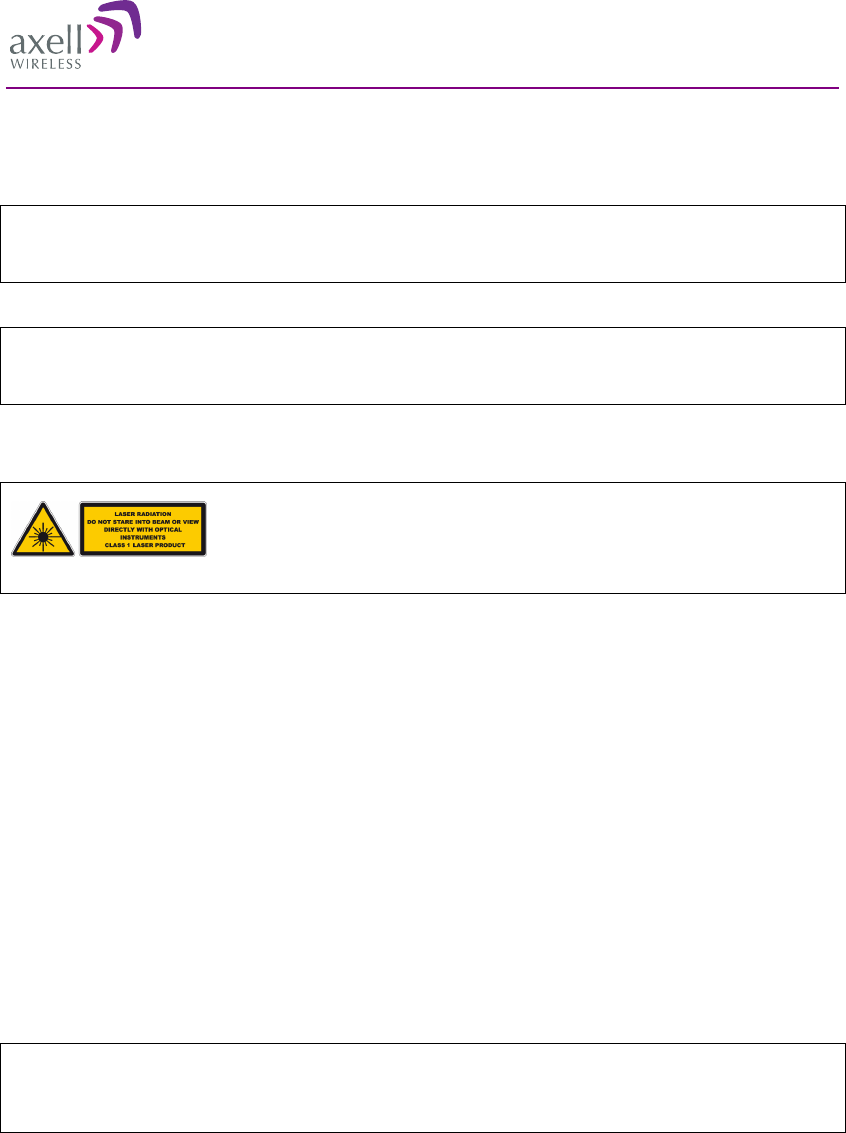
MBF, Multi Band Repeater
PRODUCT DESCRIPTION AND USER'S MANUAL
© Axell Wireless Ltd A 200 93 00, rev E 99 (105)
6 Maintenance
Caution
Please be aware that the equipment may, during certain conditions become very warm and can
cause minor injuries if handled without any protection, such as gloves.
Caution
Risk of explosion if battery is replaced by an incorrect type.
Dispose of used batteries according to local laws and instructions.
This product is equipped with class 1 lasers, as per definition in EN 60825-1.
Caution
Un-terminated optical receptacles may
emit laser radiation. Do not stare into beam
or view with optical instruments.
6.1 General
The system normally operates without any operator intervention or maintenance. If in the unlikely event of
any unit failure, the faulty repeater should be replaced. A failed unit can be removed and replaced with a
spare while the rest of the system (other repeaters) is still operating. However, the power supply of the failed
repeater should be isolated from the power before anything is replaced.
In the event of a malfunction in the system, the status of the antenna systems as well as the continuity of the
cabling should be checked before replacing any modules within the repeater.
6.2 Preventative Maintenance
The repeater does not require preventative maintenance apart from changing the battery once every three
years.
6.3 Trouble Shooting
In the event of a failure Axell Wireless’s support service should be contacted for advice on a possible module
replacement or other action to be taken.
Caution!
If a shipment of a repeater back to Axell Wireless is made within the period of
guarantee the original packing must be used.
6.4 Component Replacement
None of the modules in the repeater can be replaced without removing the repeater from its mounting and
opening the cover of the repeater.
6.5 Product Disposal
Disposal of this product must be handled according to all national laws and regulations. For detailed
information regarding materials, please refer to Axell Wireless.

MBF, Multi Band Repeater
PRODUCT DESCRIPTION AND USER'S MANUAL
© Axell Wireless Ltd A 200 93 00, rev E 100 (105)
7 Specifications
Note! All data is subject to change without prior notice.
7.1 Single Band Repeater MBF-S-7/8/9/17/18/19/22
Electrical Specifications
LTE 700 GSM/WCDMA
850
E-
GSM
GSM1800 GSM/WCDMA
1900
AWS WCDMA2100
UL 698-716MHz
and
777-787MHz
824 – 849 MHz 880 –
915
MHz
1710 -
1785 MHz
1850 - 1910
MHz
1710-1755
MHz
1920 - 1980
MHz
DL 728-756MHz 869 – 894 MHz 925 –
960
MHz
1805 -
1880 MHz
1930 - 1990
MHz
2110-2155
MHz
2110 - 2170
MHz
Operational
bandwidth
28MHz/18MHz/
10MHz
25MHz 35
MHz
75MHz 60 MHz 45MHz 60 MHz
Composite
Output Power
DL
+37dBm +37 dBm +37
dBm
+37 dBm +37 dBm -39 dBm
(for PAR
of 8.5 dB)
+39 dBm (for
PAR of 8.5 dB)
Ripple in pass band (all bands) < 2 dB
Noise figure UL (all bands) 3 dB typical (maximum gain)
Propagation delay (all bands) < 2 µs
Modulation Accuracy at nominal output power
LTE <3%EVM RMS
GSM / GMSK < 2.5 ° RMS and < 10 ° peak
EDGE / 8-PSK < 3 % EVM RMS
WCDMA/EVM < 12.5% RMS (composite according to ETSI TS 25.106
with TM 1/64 DPCH)
WCDMA/PkDCE < -33 dB (according to ETSI TS 25.106 with TM 1/64
DPCH and spreading factor 256)
Gain UL/DL (all bands) Adjustable in 1 dB steps
System Impedance 50 ohm
Return Loss at Antenna Connection > 14 dB
Antenna connectors DIN 7/16
Electrical ratings 230 VAC, 50 Hz or -48 VDC
Power Consumption 140 W

MBF, Multi Band Repeater
PRODUCT DESCRIPTION AND USER'S MANUAL
© Axell Wireless Ltd A 200 93 00, rev E 101 (105)
Optical Module Electrical Specification
Laser class Class 1
Optical power level +3dBm ±2dBm
Optical Wavelength
Two colour system Three colour system Four colour system
Master 1310 ± 10 nm 1310 ± 10 nm 1310 ± 10 nm
Slave 1 1550 ± 3 nm 1550 ± 3 nm 1530 ± 3 nm
Slave 2 NA 1510 ± 3 nm 1510 ± 3 nm
Slave 3 NA NA 1550 ± 3 nm
Mechanical Specifications
Dimensions 540 x 350 x 150 mm
Enclosure Aluminium (IP 65)
Weight 20 kg
Environmental Specifications
Cooling Convection*
EMC See compliance below
Operating Temperature - 25 to + 55 ° C
Storage - 30 to + 70 ° C
Humidity ETSI EN 300 019-2-4 (see compliance below)
MTBF > 100 000 hrs
Complies in applicable parts, relevant on different markets, to:
R&TTE Directive including
ETS EN 301 502 (ETS EN 300 609-4/GSM 11.26)
ETSI TS 25.106, ETSI 25.143
ETSI EN 301 908-11
ETS EN 301 498-8
EN 60 950
EN 50 385
* The MBF repeaters are designed primarily for multi carrier purposes. If the repeaters are run at full output
power over a longer period the convection cooling might not be enough. The repeaters have a power
management function implemented that will step down the power and if needed fully shut down the amplifier
chains until temperature has reached normal values. In situations where a repeater will be run in such a
manner extra cooling can be provided for instance by putting the repeater in a temperature controlled
environment or via external fans.

MBF, Multi Band Repeater
PRODUCT DESCRIPTION AND USER'S MANUAL
© Axell Wireless Ltd A 200 93 00, rev E 102 (105)
7.2 Dual Band Repeater MBF-D-9-22/8-19/7-17
Electrical Specifications
LTE 700 GSM/WCDMA
850
E-GSM GSM/WCDMA
1900
AWS WCDMA2100
UL 698-716MHz
and
777-787MHz
824 – 849 MHz 880 –
915
MHz
1850 - 1910 MHz 1710-1755
MHz
1920 - 1980 MHz
DL 728-756MHz 869 – 894 MHz 925 –
960
MHz
1930 - 1990 MHz 2110-2155
MHz
2110 - 2170 MHz
Operational
bandwidth
28MHz/18MHz/
10MHz
25MHz 35 MHz 60 MHz 45MHz 60 MHz
Composite Output
Power DL
+37dBm +37 dBm +37
dBm
+37 dBm -39 dBm (for
PAR of 8.5 dB)
+39 dBm (for PAR
of 8.5 dB)
Ripple in pass band (all bands) < 2 dB
Noise figure UL (all bands) 3 dB typical (maximum gain)
Propagation delay (all bands) < 2 µs
Modulation Accuracy at nominal output power
LTE 700 <3% EVM RMS
GSM / GMSK < 2.5 ° RMS and < 10 ° peak
EDGE / 8-PSK < 3 % EVM RMS
WCDMA/EVM < 12.5% RMS (composite according to ETSI TS 25.106
with TM 1/64 DPCH)
WCDMA/PkDCE < -33 dB (according to ETSI TS 25.106 with TM 1/64
DPCH and spreading factor 256)
Gain UL/DL (all bands) Adjustable in 1 dB steps
System Impedance (all bands) 50 ohm
Return Loss at Antenna Connection > 14 dB
Antenna connectors DIN 7/16
Electrical ratings 230 VAC, 50 Hz or -48 VDC
Power Consumption 220 W

MBF, Multi Band Repeater
PRODUCT DESCRIPTION AND USER'S MANUAL
© Axell Wireless Ltd A 200 93 00, rev E 103 (105)
Optical Module Electrical Specification
Laser class Class 1
Optical power level +3dBm ±2dBm
Optical Wavelength
Two colour system Three colour system Four colour system
Master 1310 ± 10 nm 1310 ± 10 nm 1310 ± 10 nm
Slave 1 1550 ± 3 nm 1550 ± 3 nm 1530 ± 3 nm
Slave 2 NA 1510 ± 3 nm 1510 ± 3 nm
Slave 3 NA NA 1550 ± 3 nm
Mechanical Specifications
Dimensions 540 x 350 x 150 mm
Enclosure Aluminium (IP 65)
Weight 22 kg
Environmental Specifications
Cooling Convection*
EMC See compliance below
Operating Temperature - 25 to + 55 ° C
Storage - 30 to + 70 ° C
Humidity ETSI EN 300 019-2-4 (see compliance below)
MTBF > 100 000 hrs
Complies in applicable parts, relevant on different markets, to:
R&TTE Directive including
ETS EN 301 502 (ETS EN 300 609-4/GSM 11.26)
ETSI TS 25.106, ETSI 25.143
ETSI EN 301 908-11
ETS EN 301 498-8
EN 60 950
EN 50 385
* The MBF repeaters are designed primarily for multi carrier purposes. If the repeaters are run at full output
power over a longer period the convection cooling might not be enough. The repeaters have a power
management function implemented that will step down the power and if needed fully shut down the amplifier
chains until temperature has reached normal values. In situations where a repeater will be run in such a
manner extra cooling can be provided for instance by putting the repeater in a temperature controlled
environment or via external fans.

MBF, Multi Band Repeater
PRODUCT DESCRIPTION AND USER'S MANUAL
© Axell Wireless Ltd A 200 93 00, rev E 104 (105)
7.3 Tri Band Repeater MBF-T-9-18-22/8-17-19
Electrical Specifications
GSM/WCDMA
850
E-GSM GSM1800 GSM/WCDMA
1900
WCDMA
2100
AWS
UL 824 – 849 MHz 880 – 915
MHz
1710 - 1785
MHz
1850 - 1910
MHz
1920 - 1980
MHz
1710-1755
MHz
DL 869 – 894 MHz 925 – 960
MHz
1805 - 1880
MHz
1930 - 1990
MHz
2110 - 2170
MHz
2110-2155
MHz
Operational
bandwidth
25MHz 35 MHz 75MHz 60 MHz 60 MHz 45MHz
Composite
Output
Power DL
+37 dBm +37 dBm* +37 dBm* +37 dBm +39 dBm
(for PAR of
8.5 dB)
+39 dBm
(for PAR of
8.5 dB)
* In repeaters that share a common downlink fibre for 900MHZ and 1800MHz a minimum of 4 carriers in
each band is required for the full composite output power to be attainable maintaining full ETSI compliance
Ripple in pass band (all bands) < 2 dB
Noise figure UL (all bands) 3 dB typical (maximum gain)
Propagation delay (all bands) < 2 µs
Modulation Accuracy at nominal output power
GSM / GMSK < 2.5 ° RMS and < 10 ° peak
EDGE / 8-PSK < 3 % EVM RMS
WCDMA/EVM < 12.5% RMS (composite according to ETSI TS 25.106
with TM 1/64 DPCH)
WCDMA/PkDCE < -33 dB (according to ETSI TS 25.106 with TM 1/64
DPCH and spreading factor 256)
Gain UL/DL (all bands) Adjustable in 1 dB steps
System Impedance 50 ohm
Return Loss at Antenna Connection > 14 dB
Antenna connectors DIN 7/16
Electrical ratings 230 VAC, 50 Hz or -48 VDC
Power Consumption 350 W

MBF, Multi Band Repeater
PRODUCT DESCRIPTION AND USER'S MANUAL
© Axell Wireless Ltd A 200 93 00, rev E 105 (105)
Optical Module Electrical Specification
Laser class Class 1
Optical power level +3dBm ±2dBm
Optical Wavelength
Two colour system Three colour system Four colour system
Master 1310 ± 10 nm 1310 ± 10 nm 1310 ± 10 nm
Slave 1 1550 ± 3 nm 1550 ± 3 nm 1530 ± 3 nm
Slave 2 NA 1510 ± 3 nm 1510 ± 3 nm
Slave 3 NA NA 1550 ± 3 nm
Mechanical Specifications
Dimensions 540 x 350 x 220 mm
Enclosure Aluminium (IP 65)
Weight 33 kg
Environmental Specifications
Cooling Convection*
EMC See compliance below
Operating Temperature - 25 to + 55 ° C
Storage - 30 to + 70 ° C
Humidity ETSI EN 300 019-2-4 (see compliance below)
MTBF > 100 000 hrs
Complies in applicable parts, relevant on different markets, to:
R&TTE Directive including
ETS EN 301 502 (ETS EN 300 609-4/GSM 11.26)
ETSI TS 25.106, ETSI 25.143
ETSI EN 301 908-11
ETS EN 301 498-8
EN 60 950
EN 50 385
* The MBF repeaters are designed primarily for multi carrier purposes. If the repeaters are run at full output
power over a longer period the convection cooling might not be enough. The repeaters have a power
management function implemented that will step down the power and if needed fully shut down the amplifier
chains until temperature has reached normal values. In situations where a repeater will be run in such a
manner extra cooling can be provided for instance by putting the repeater in a temperature controlled
environment or via external fans.